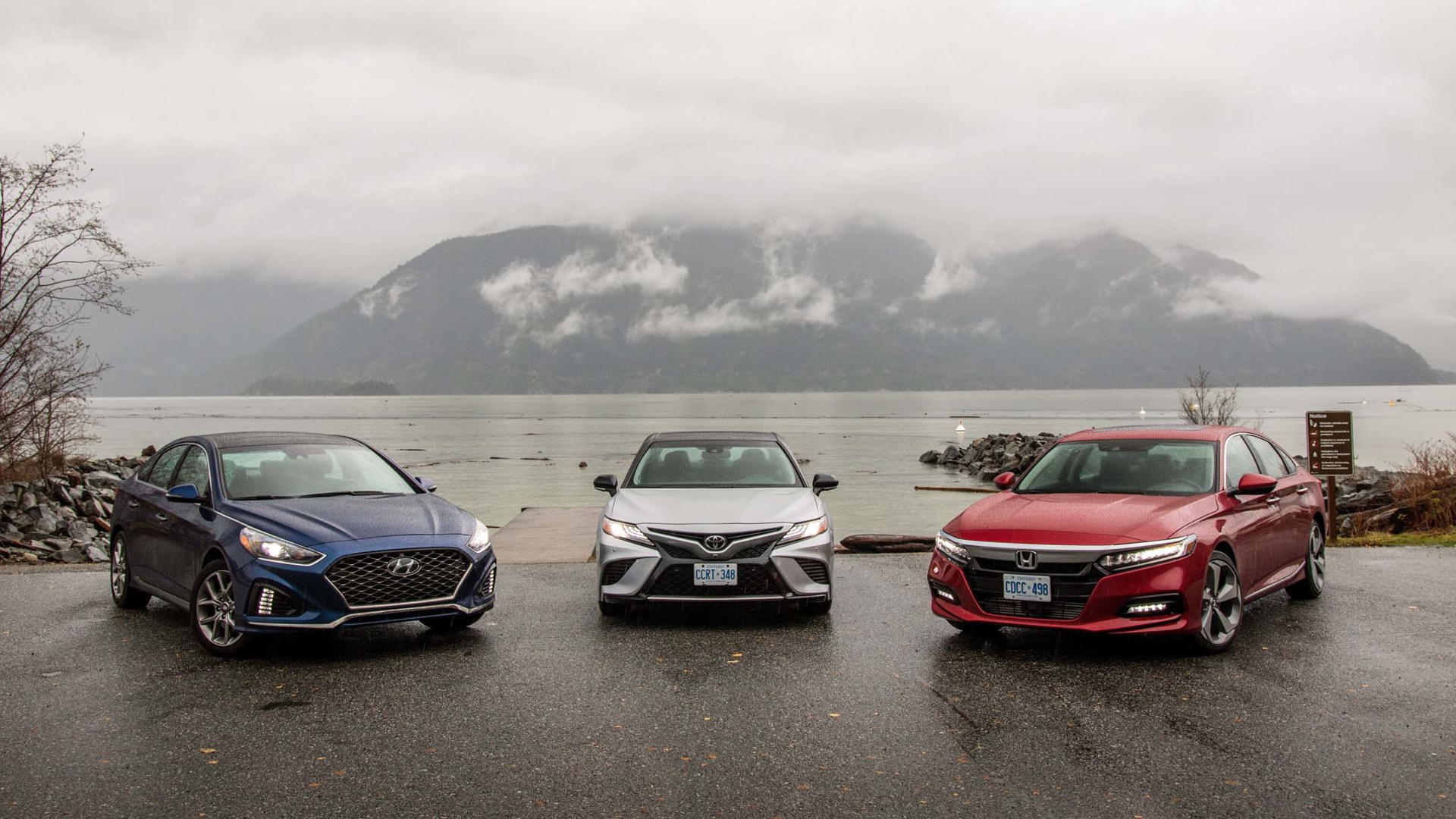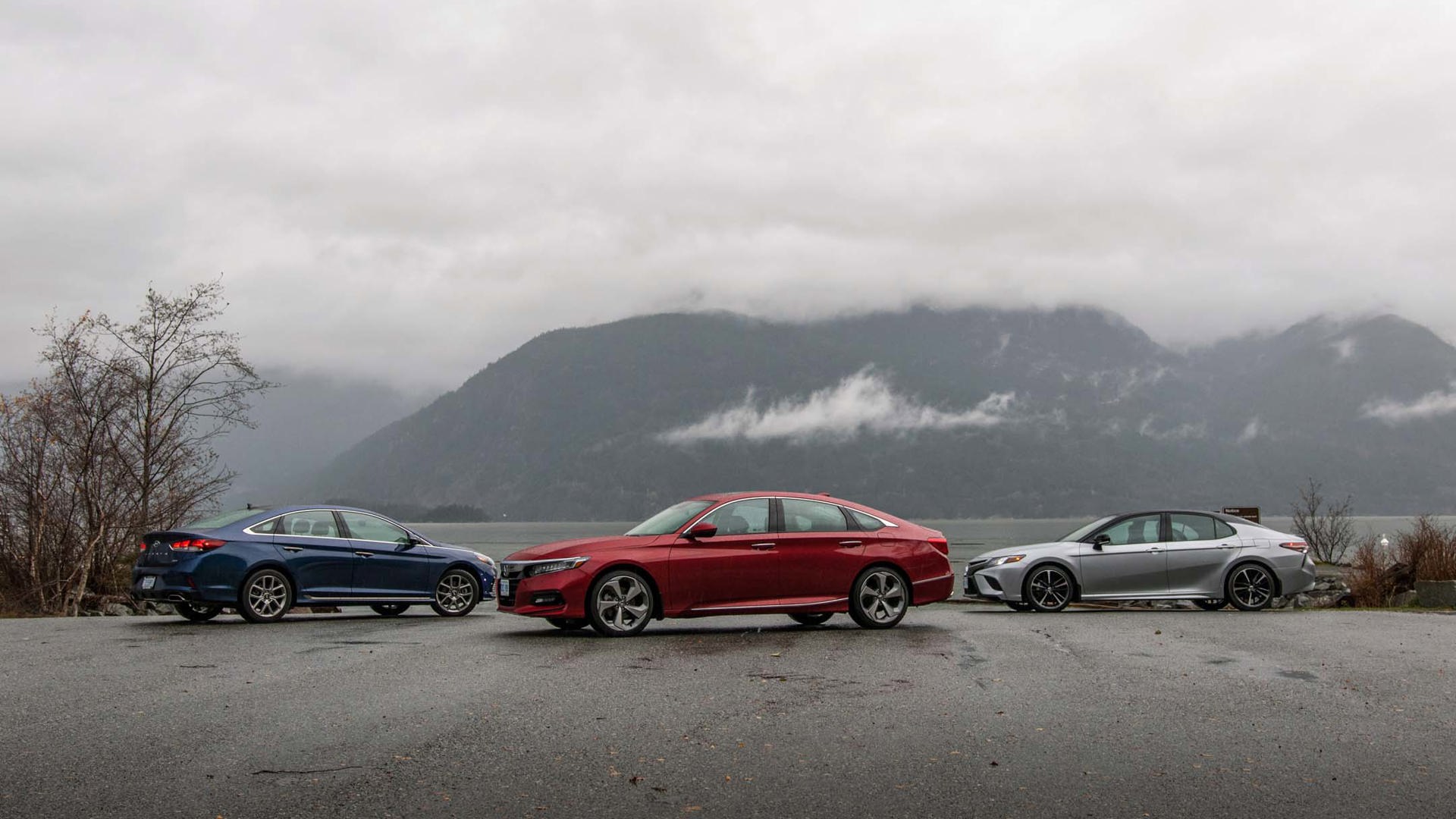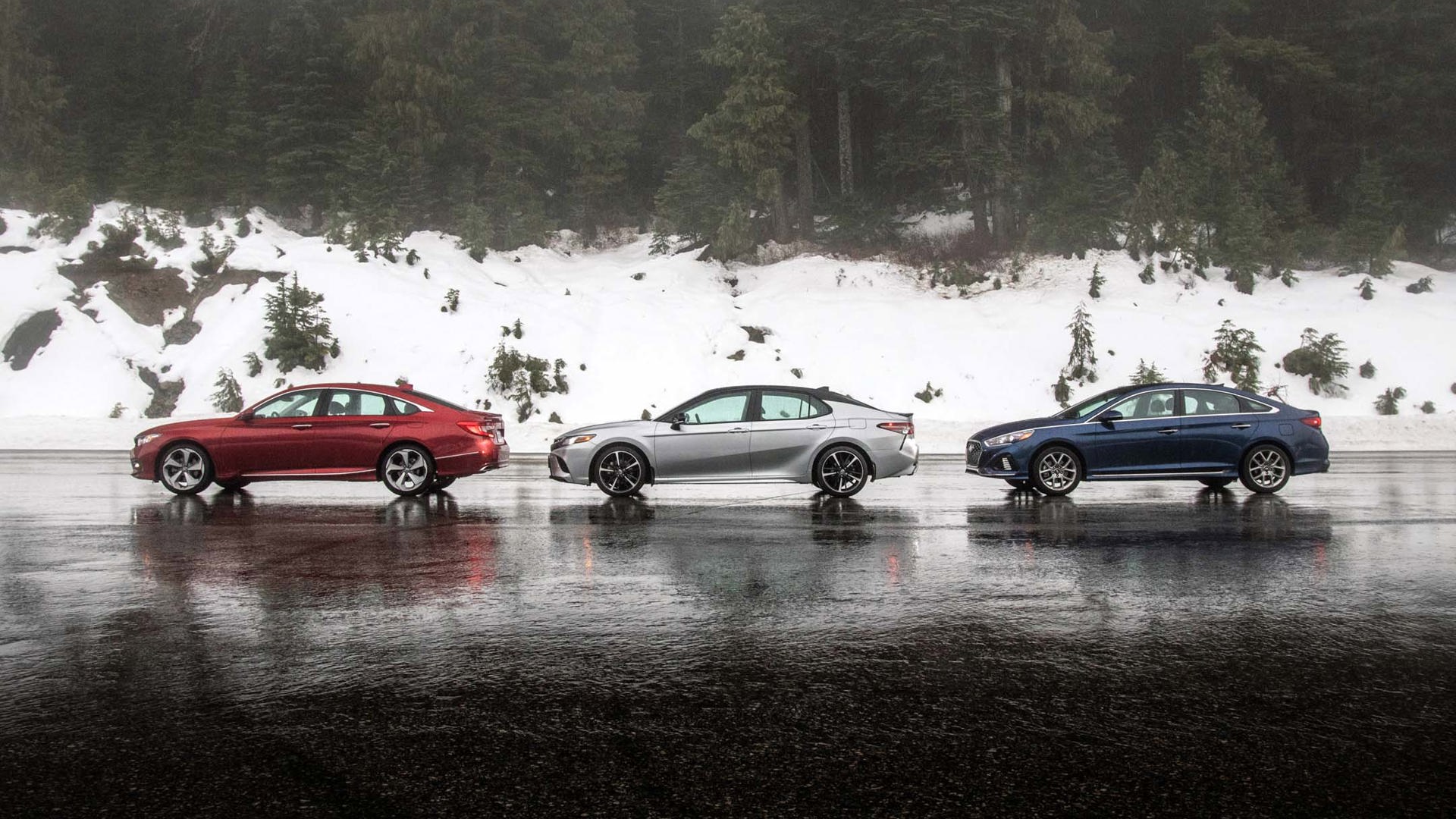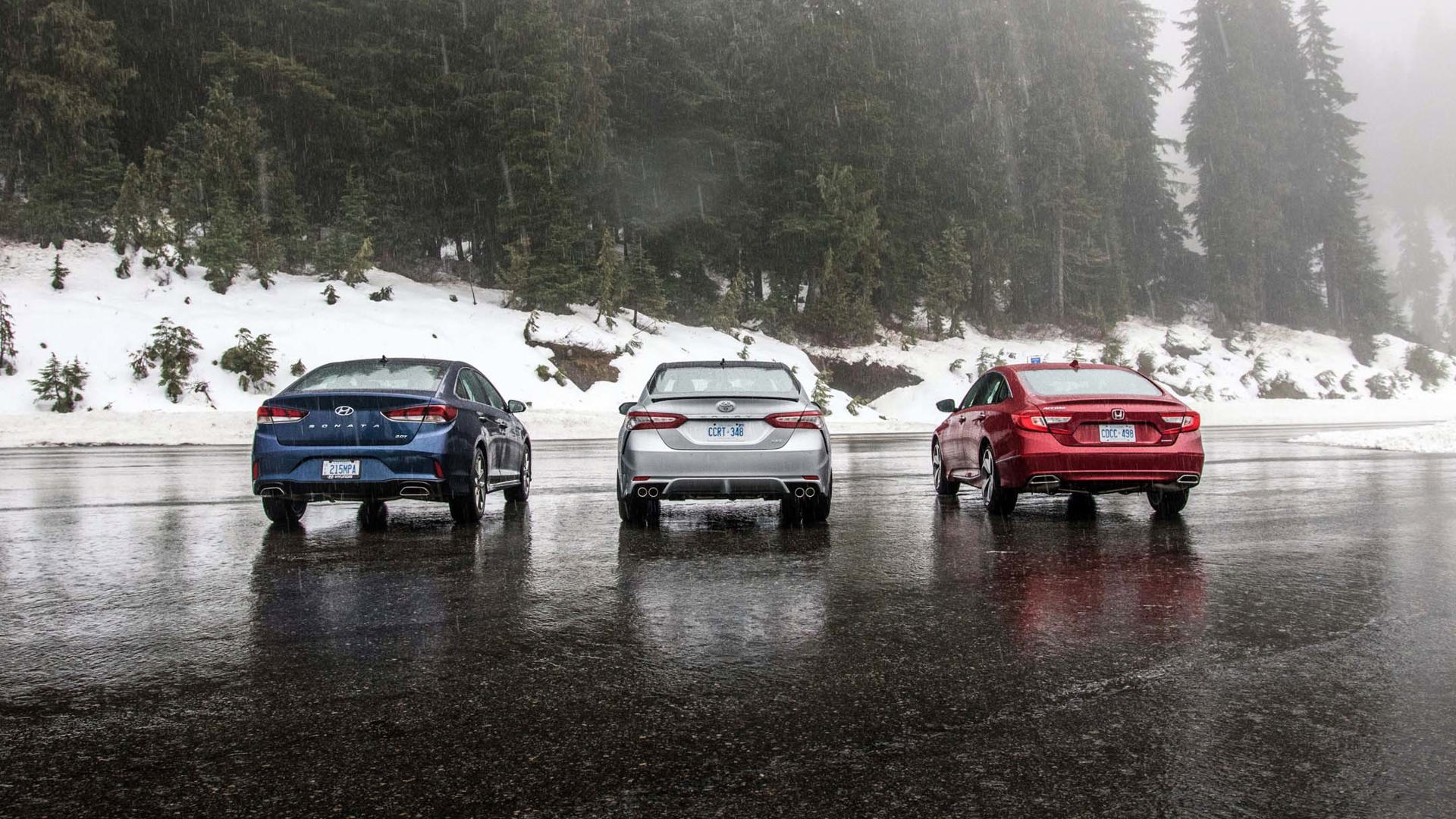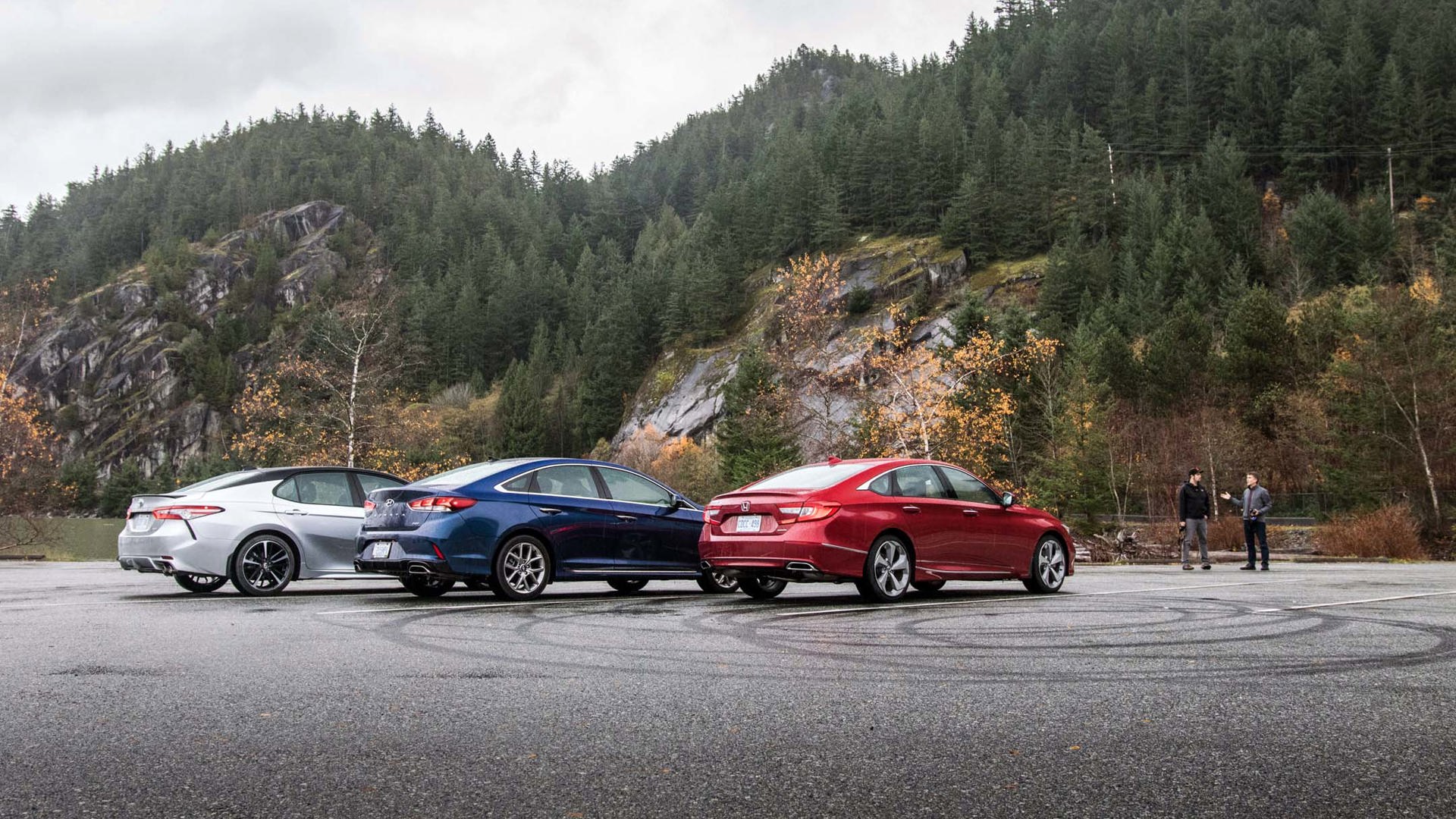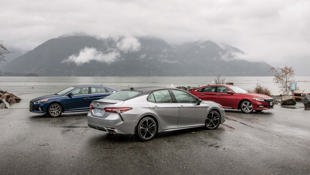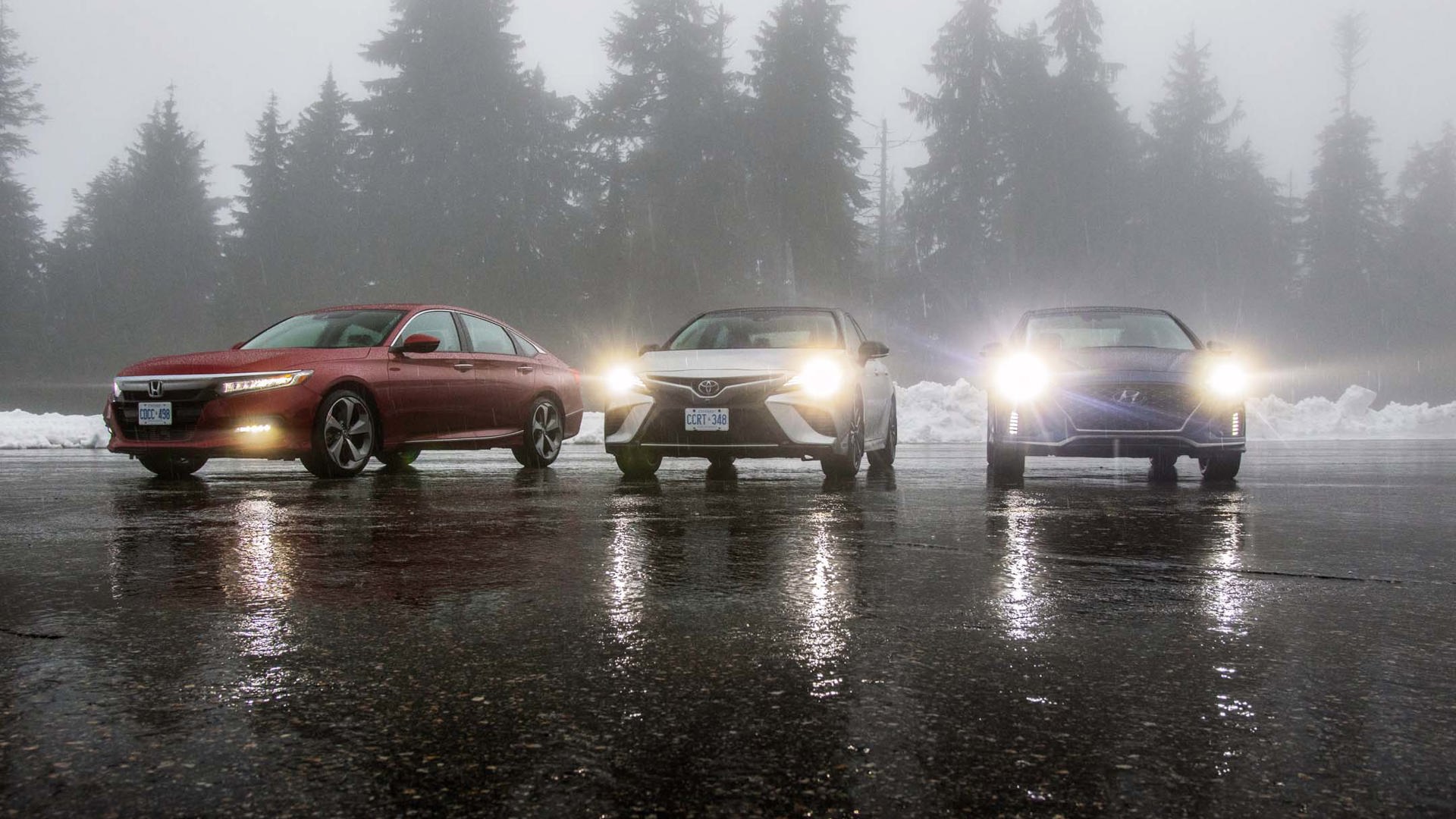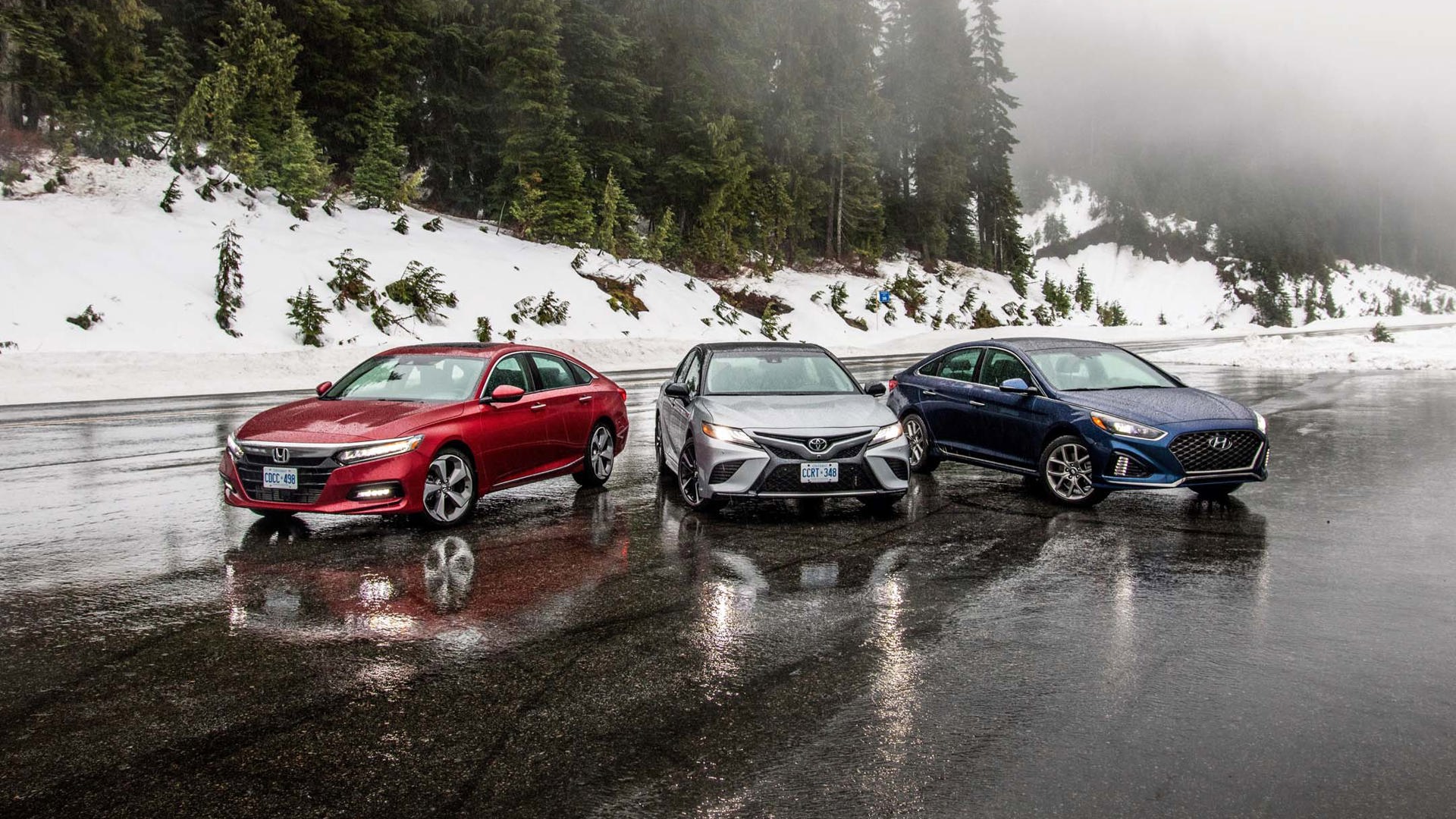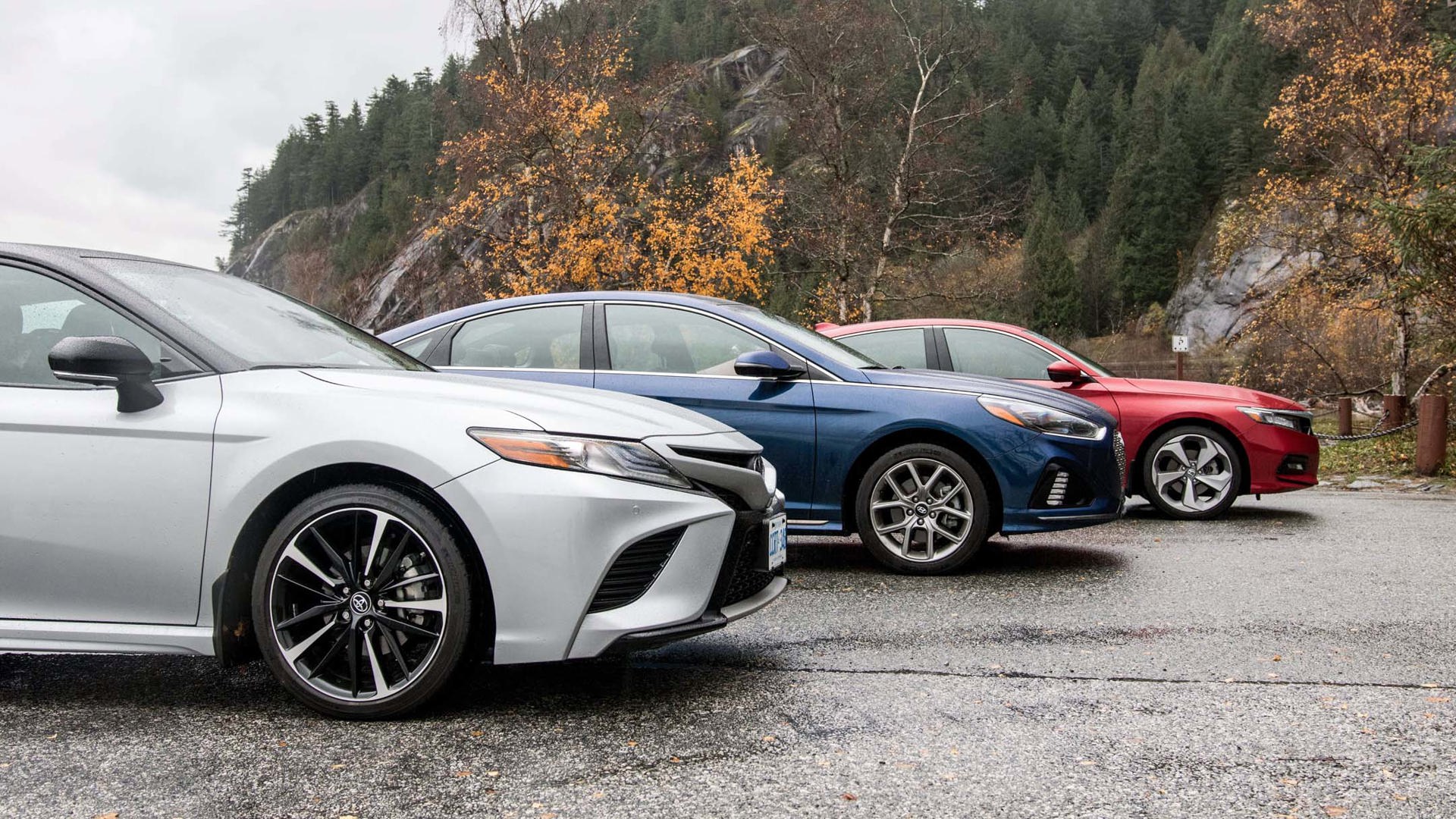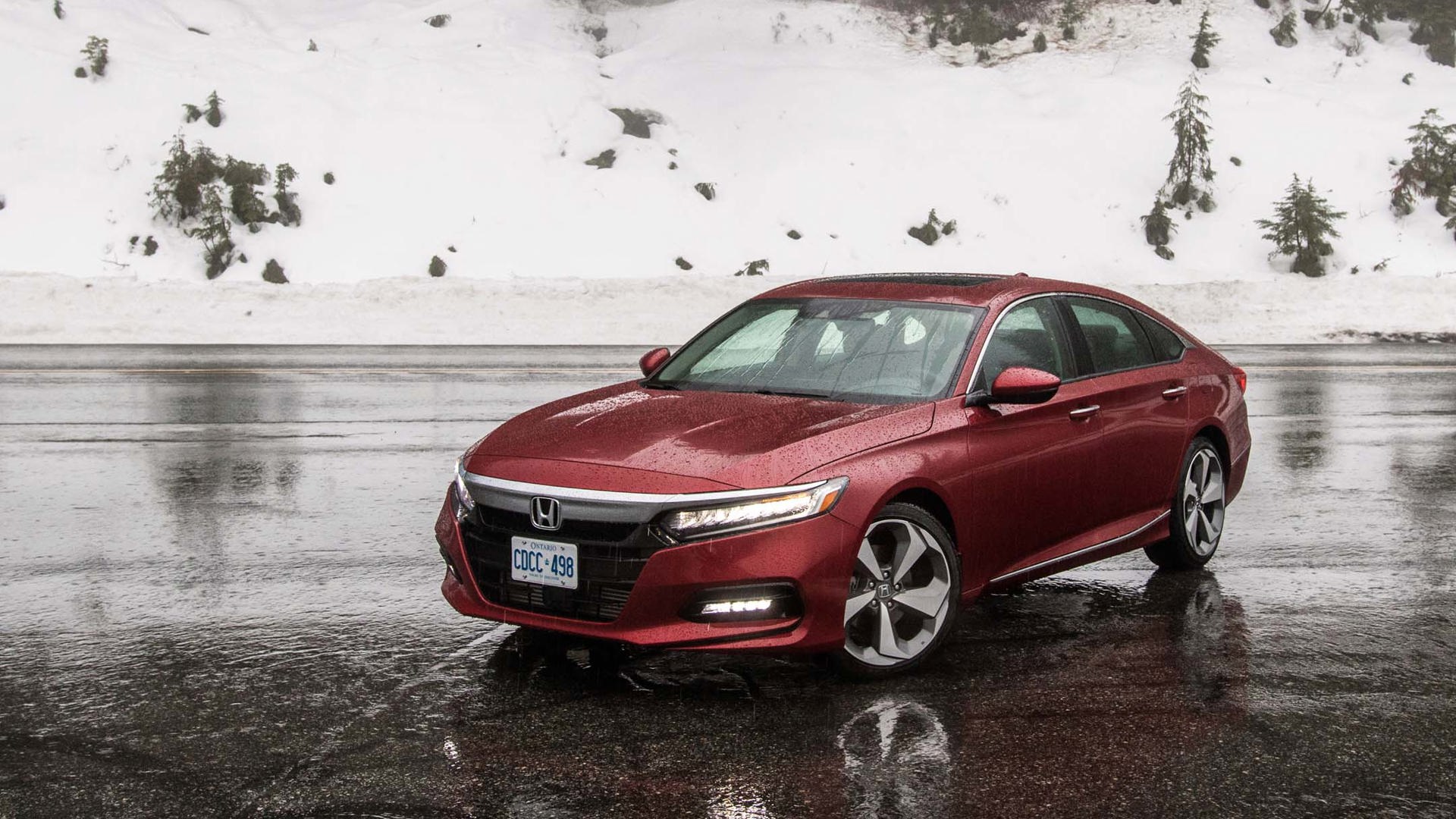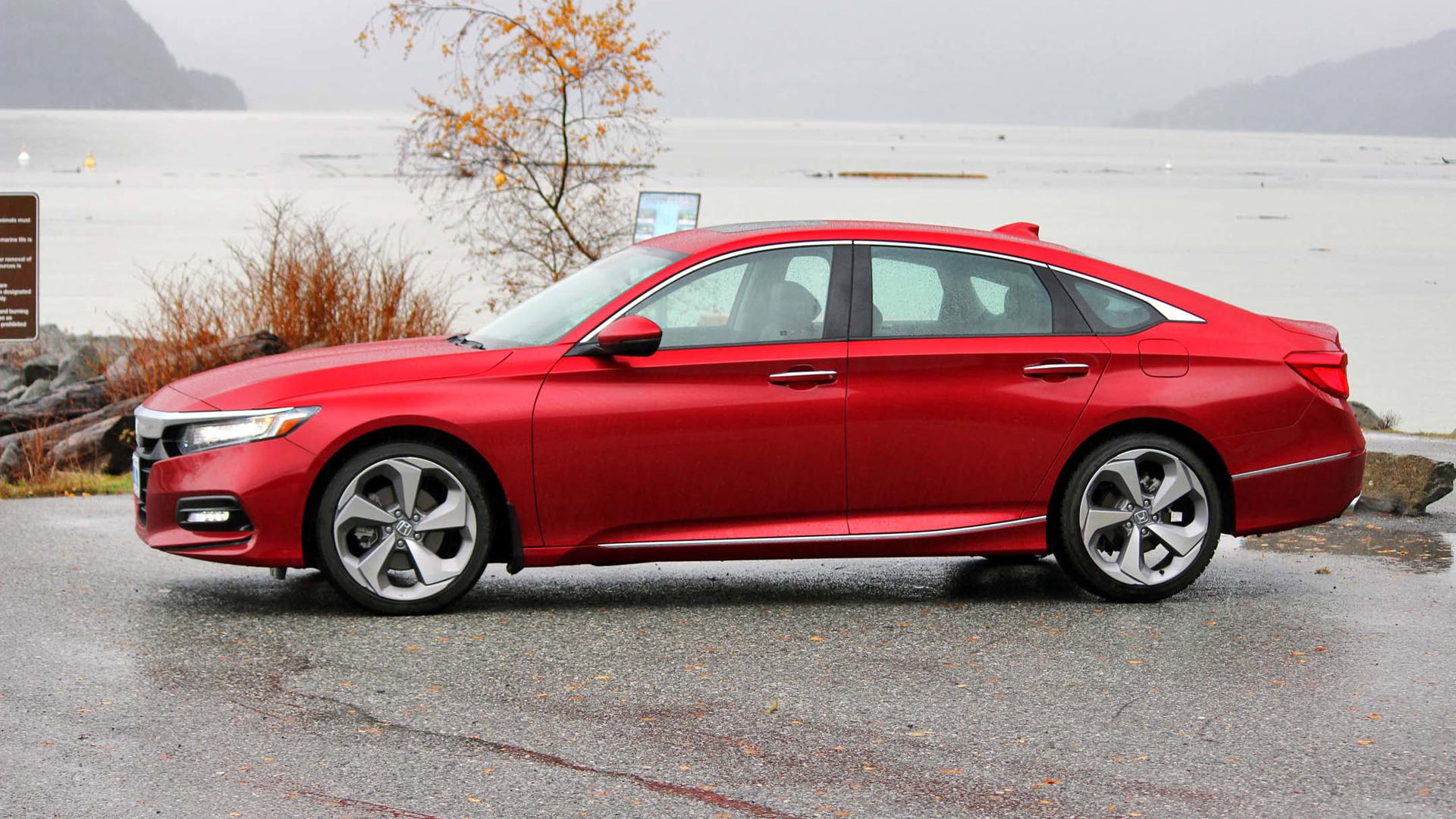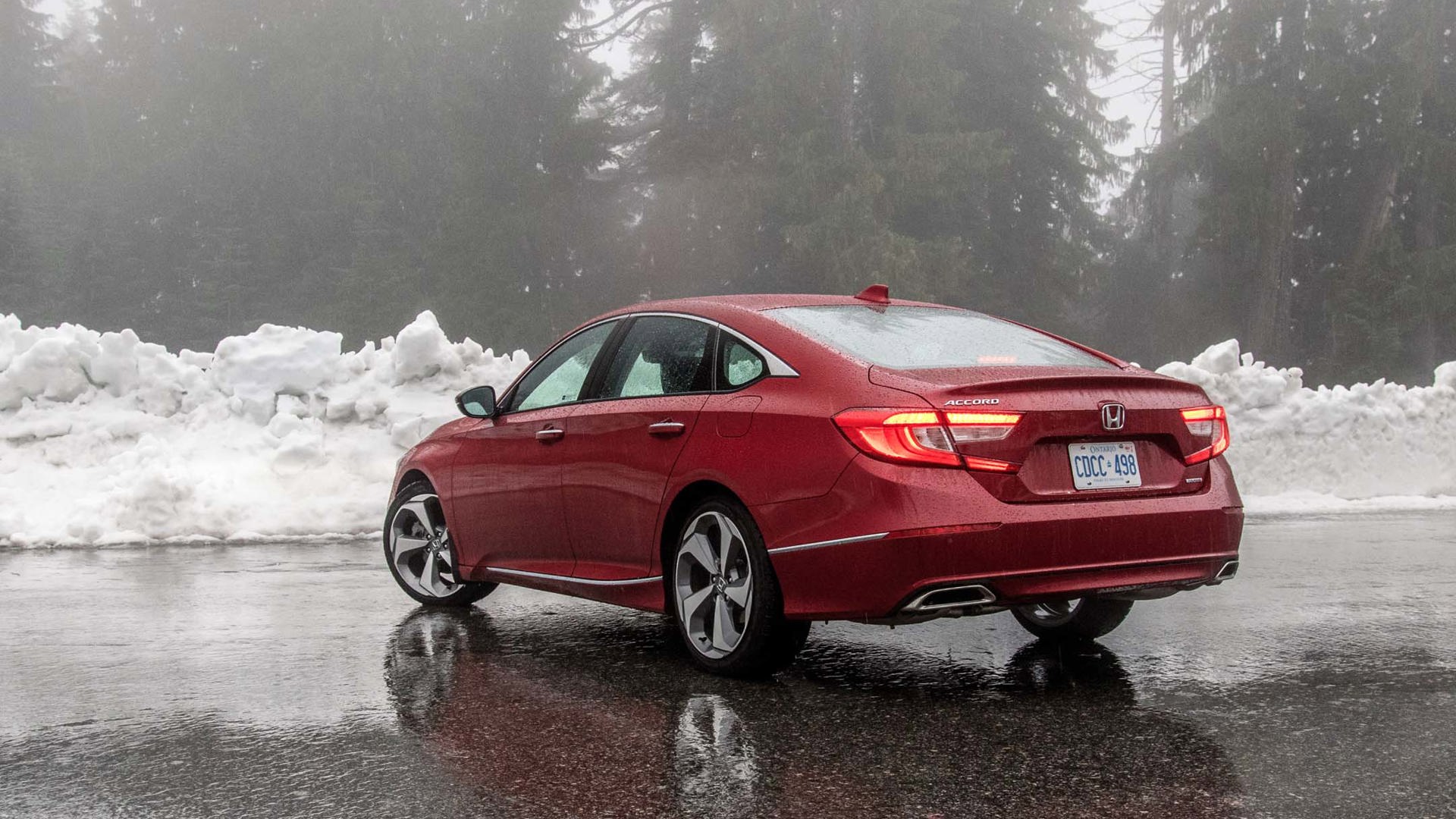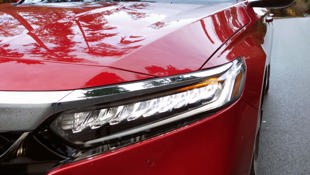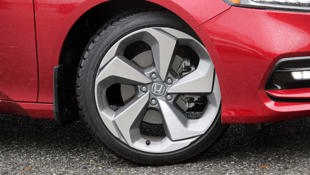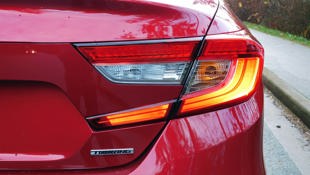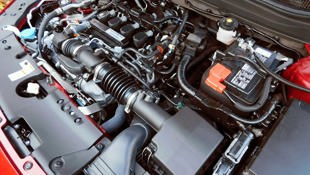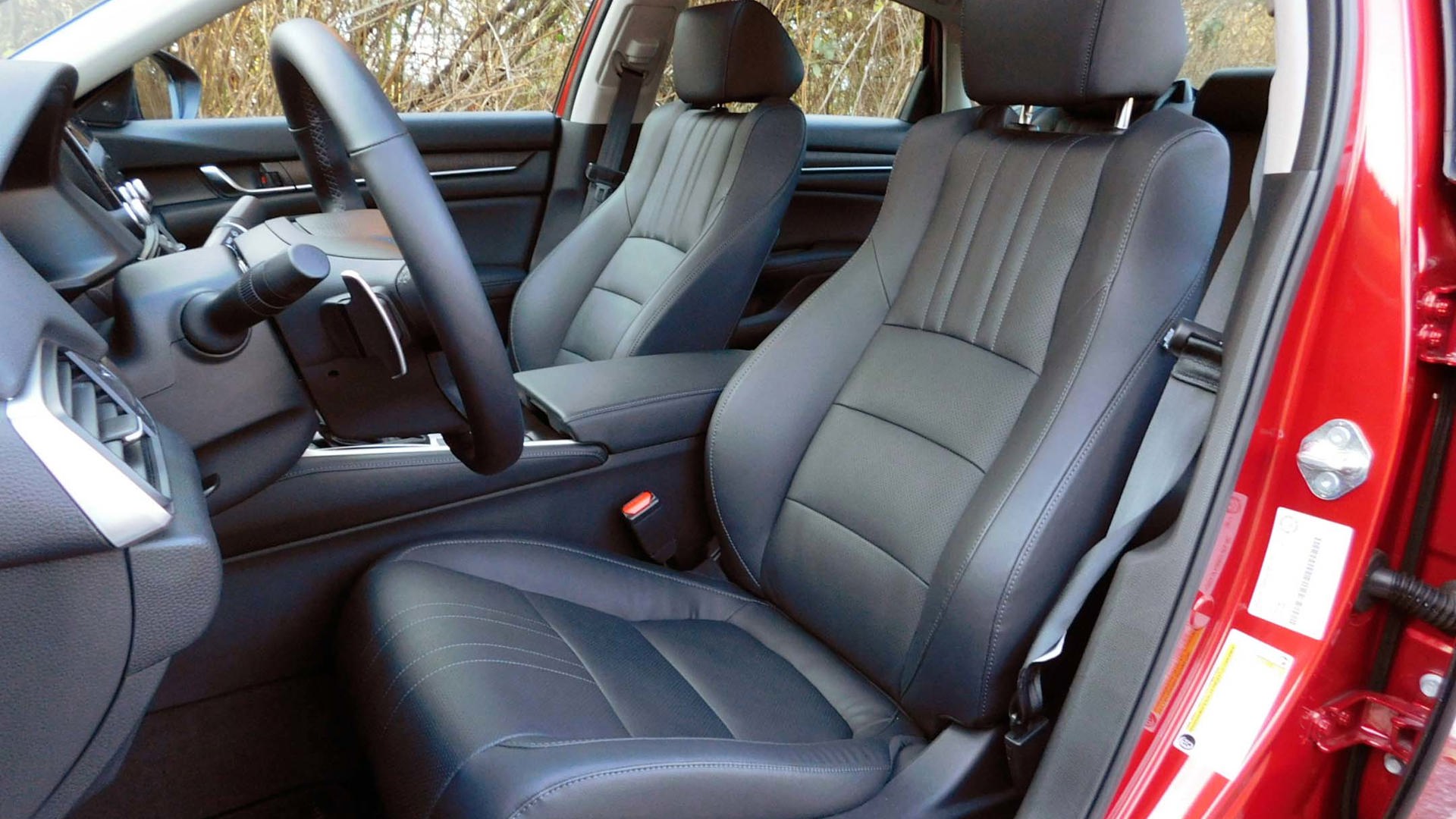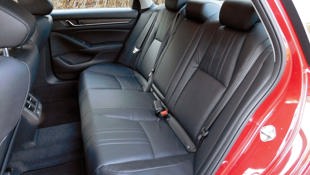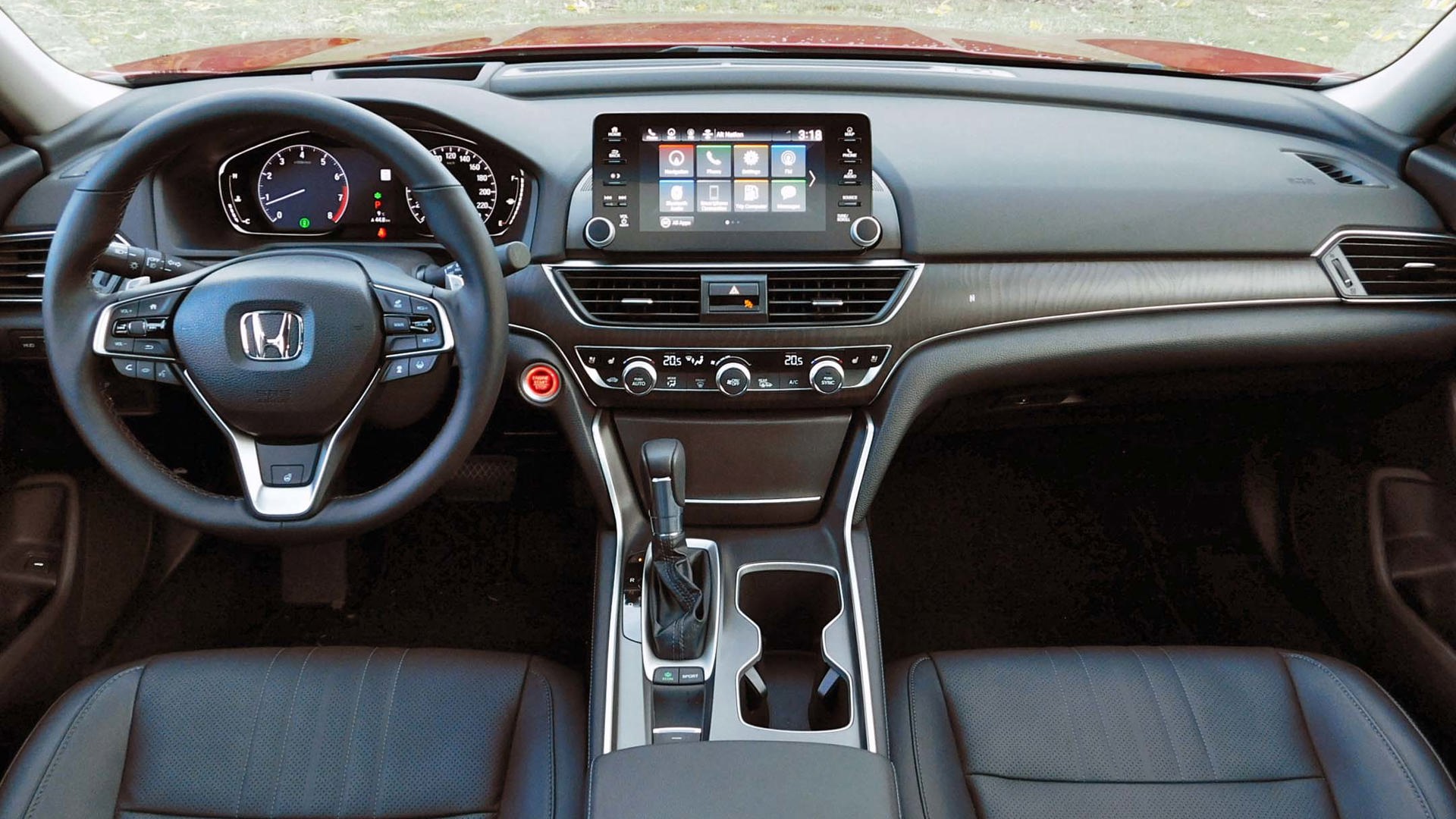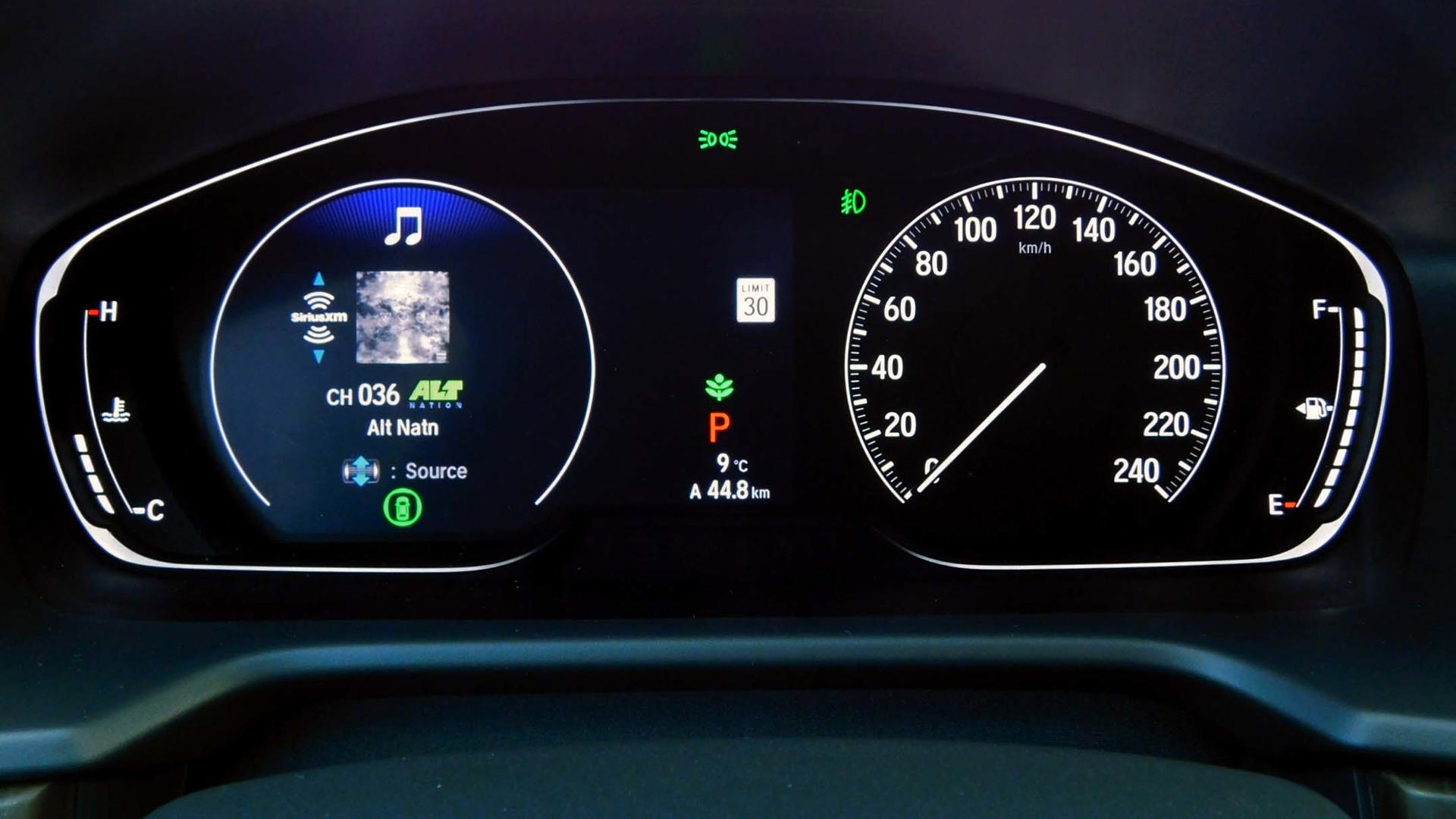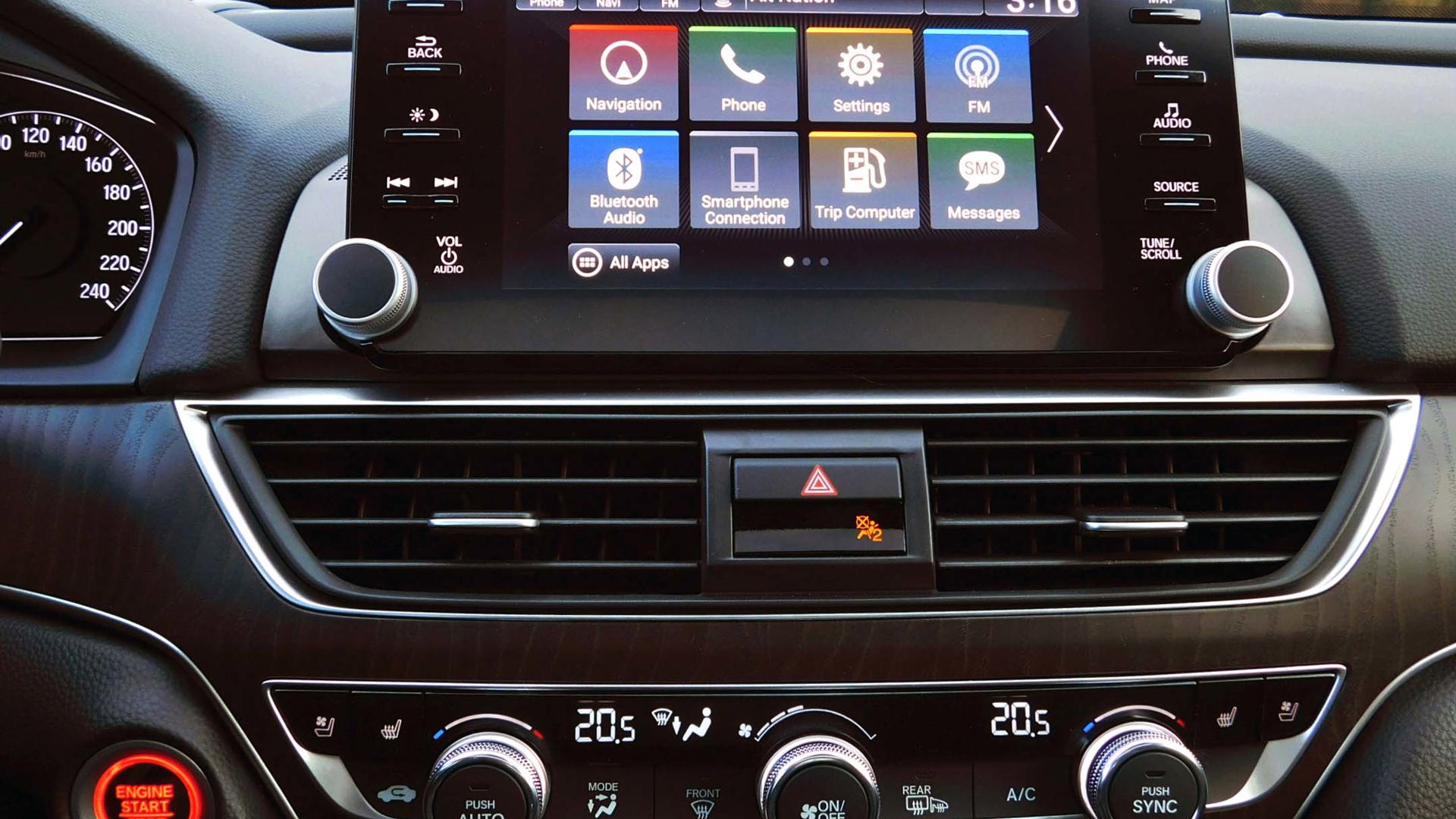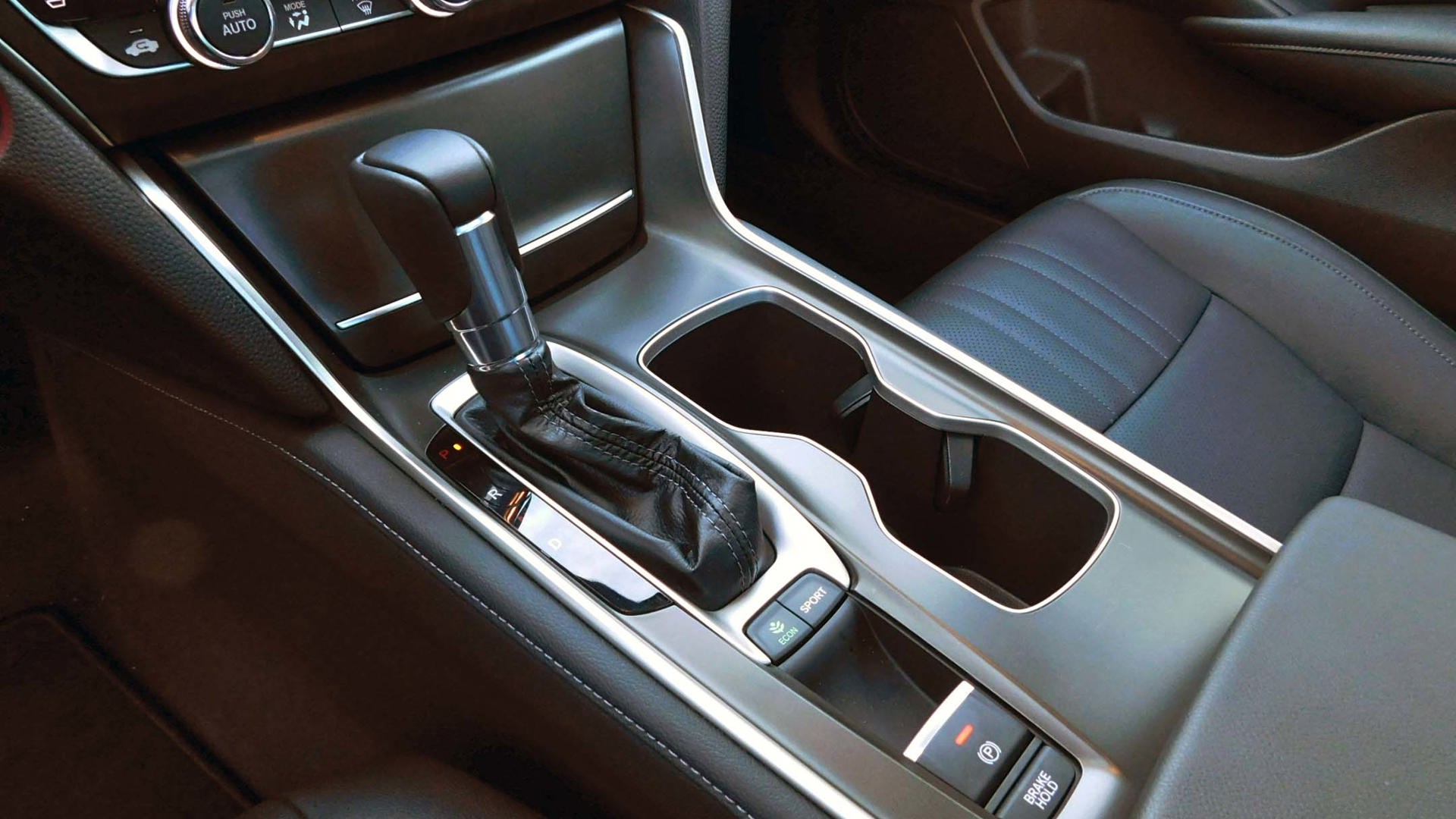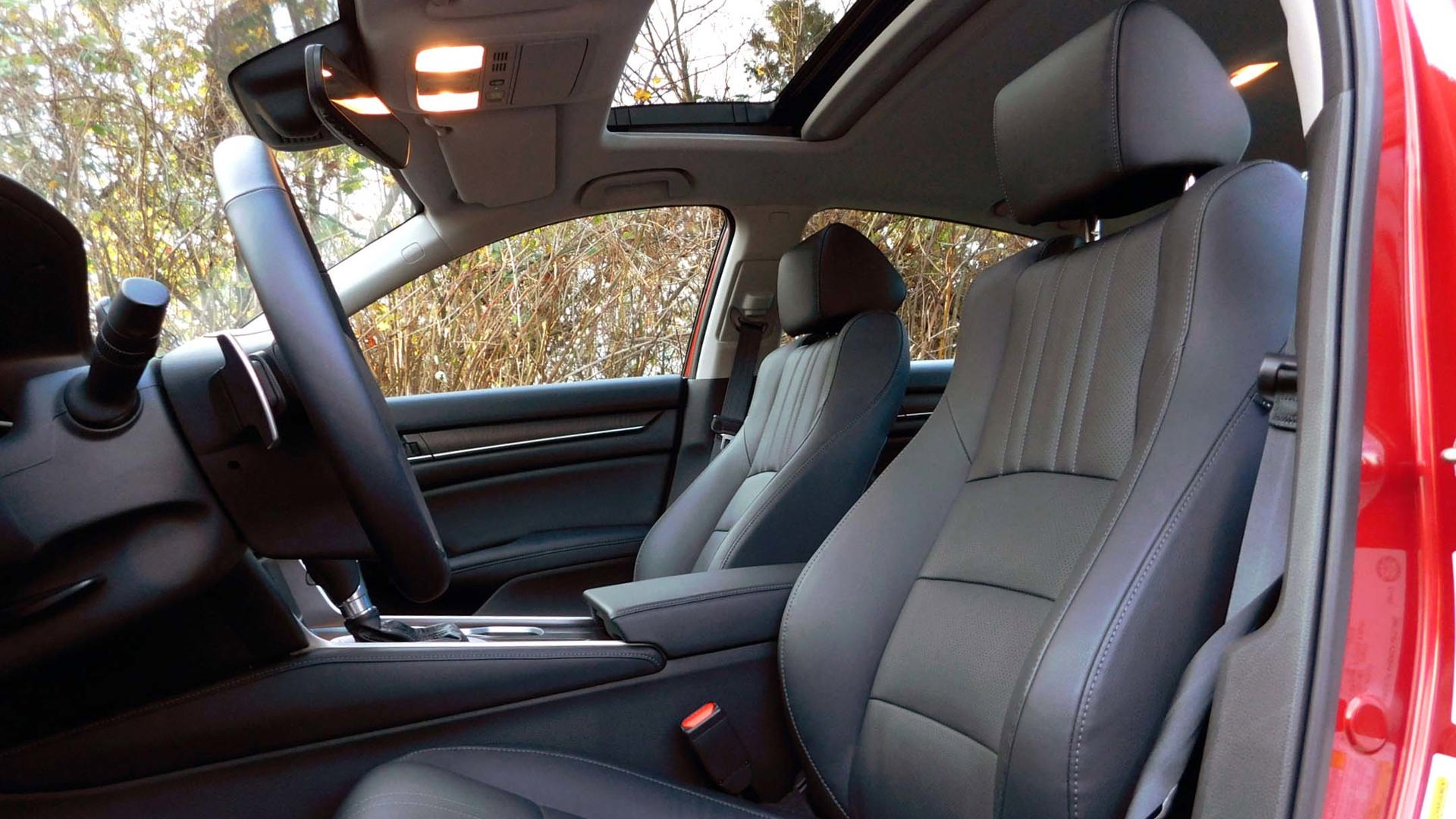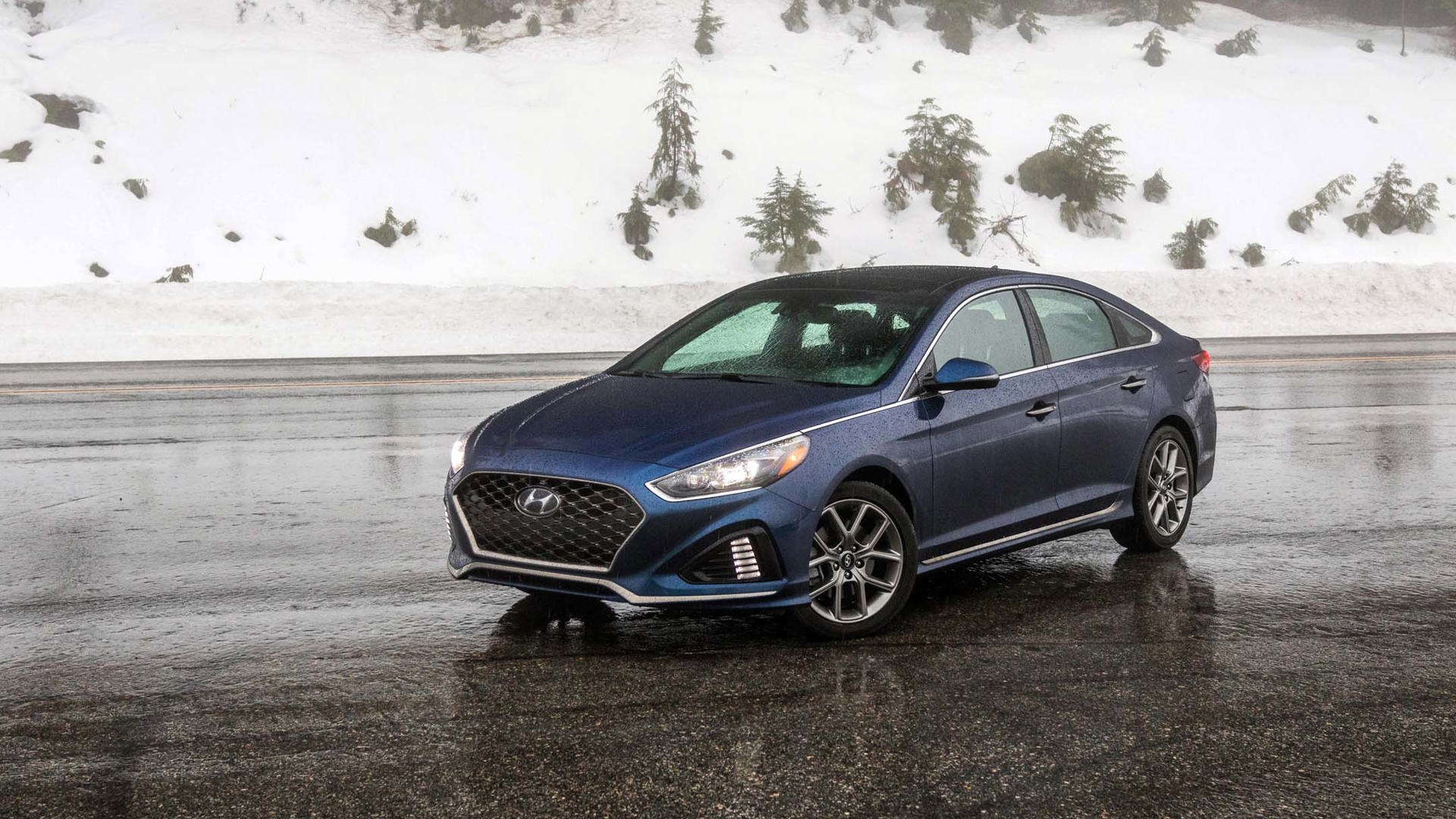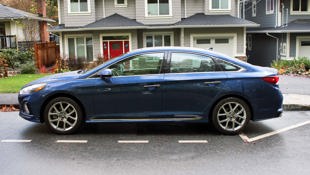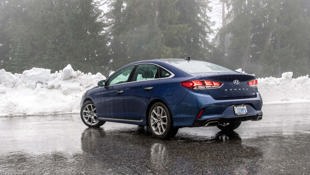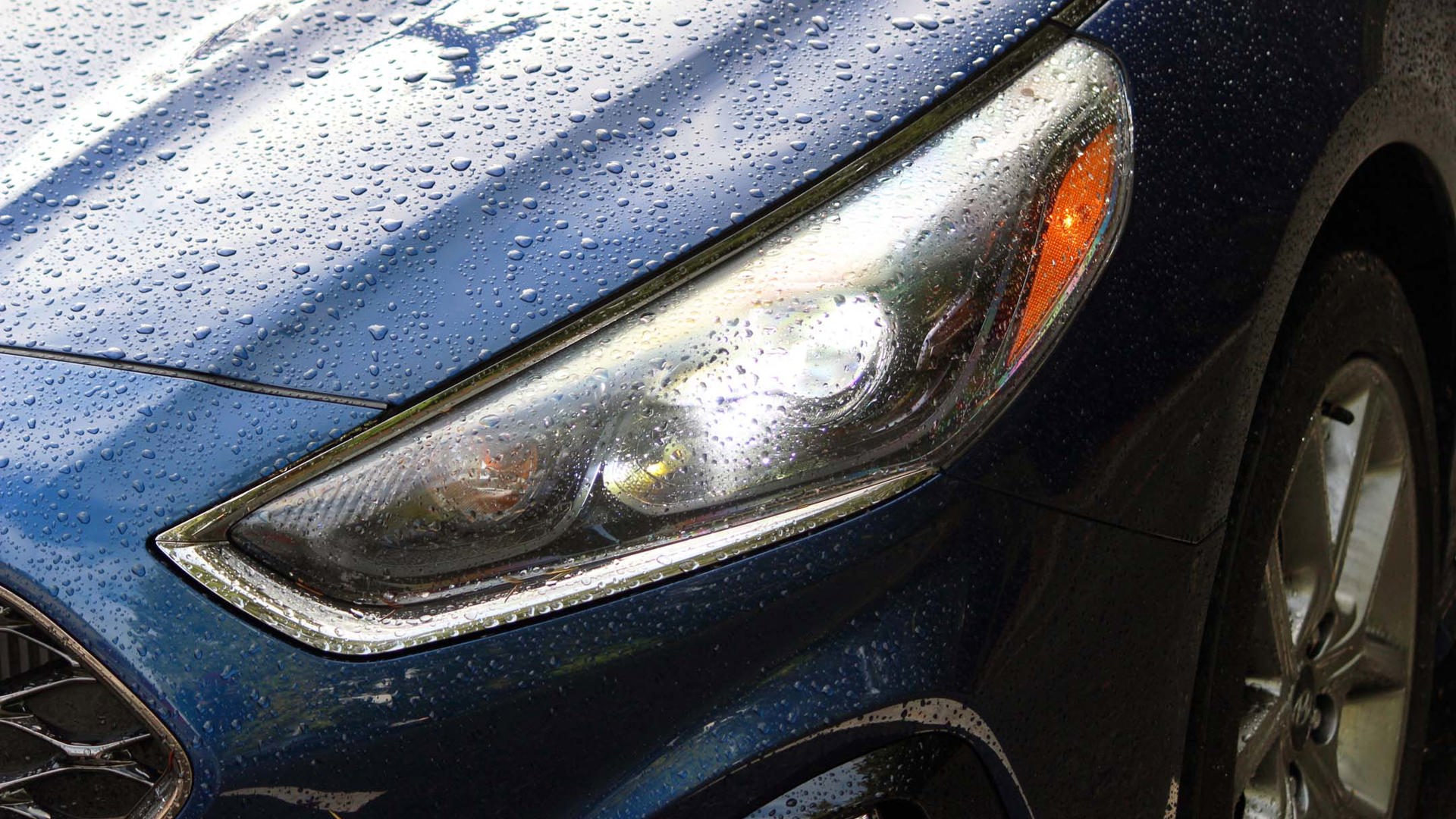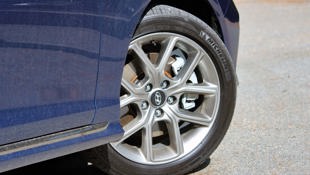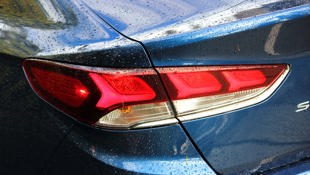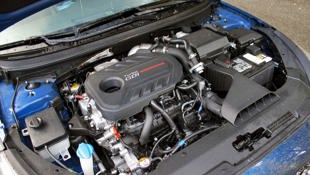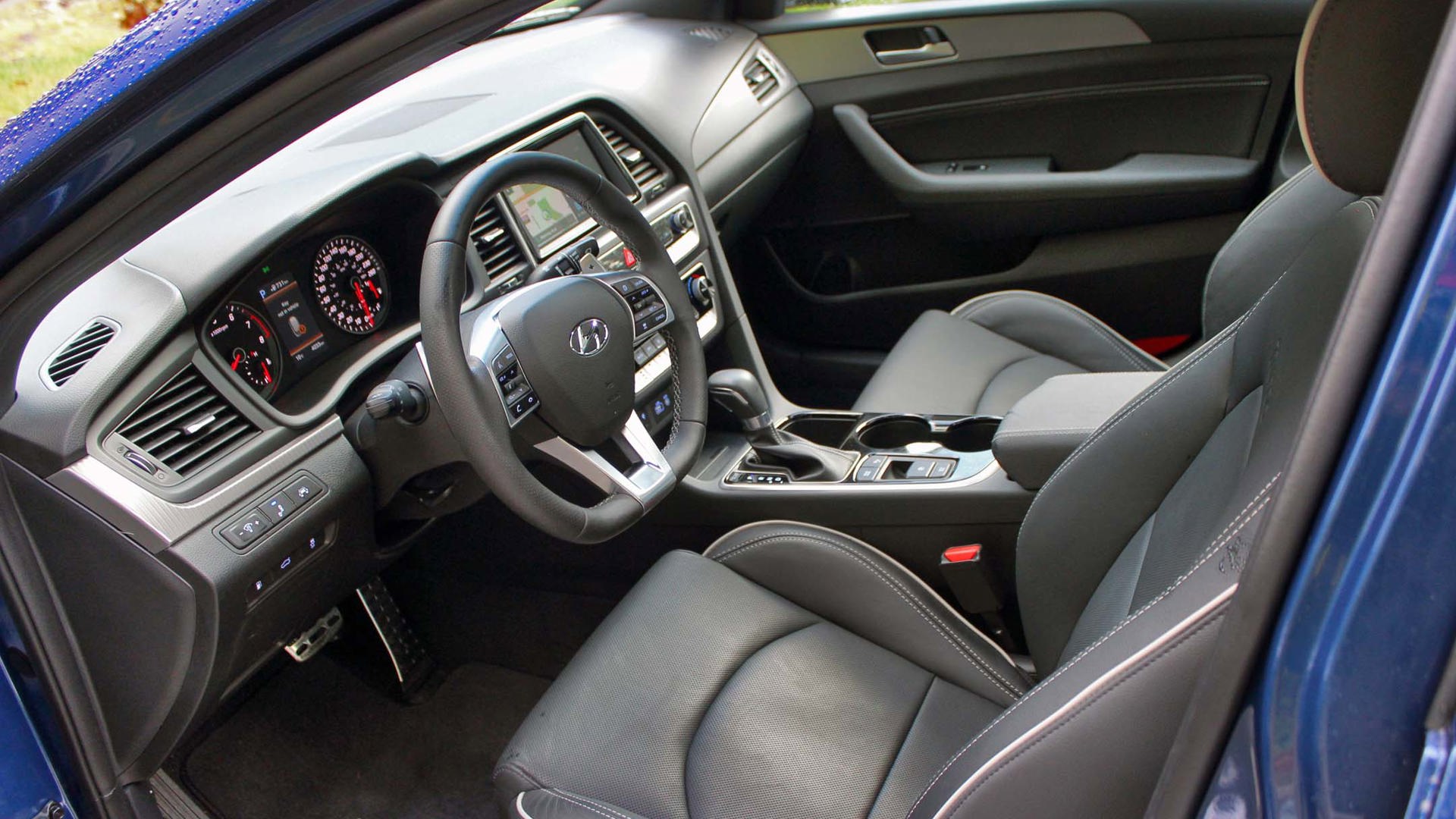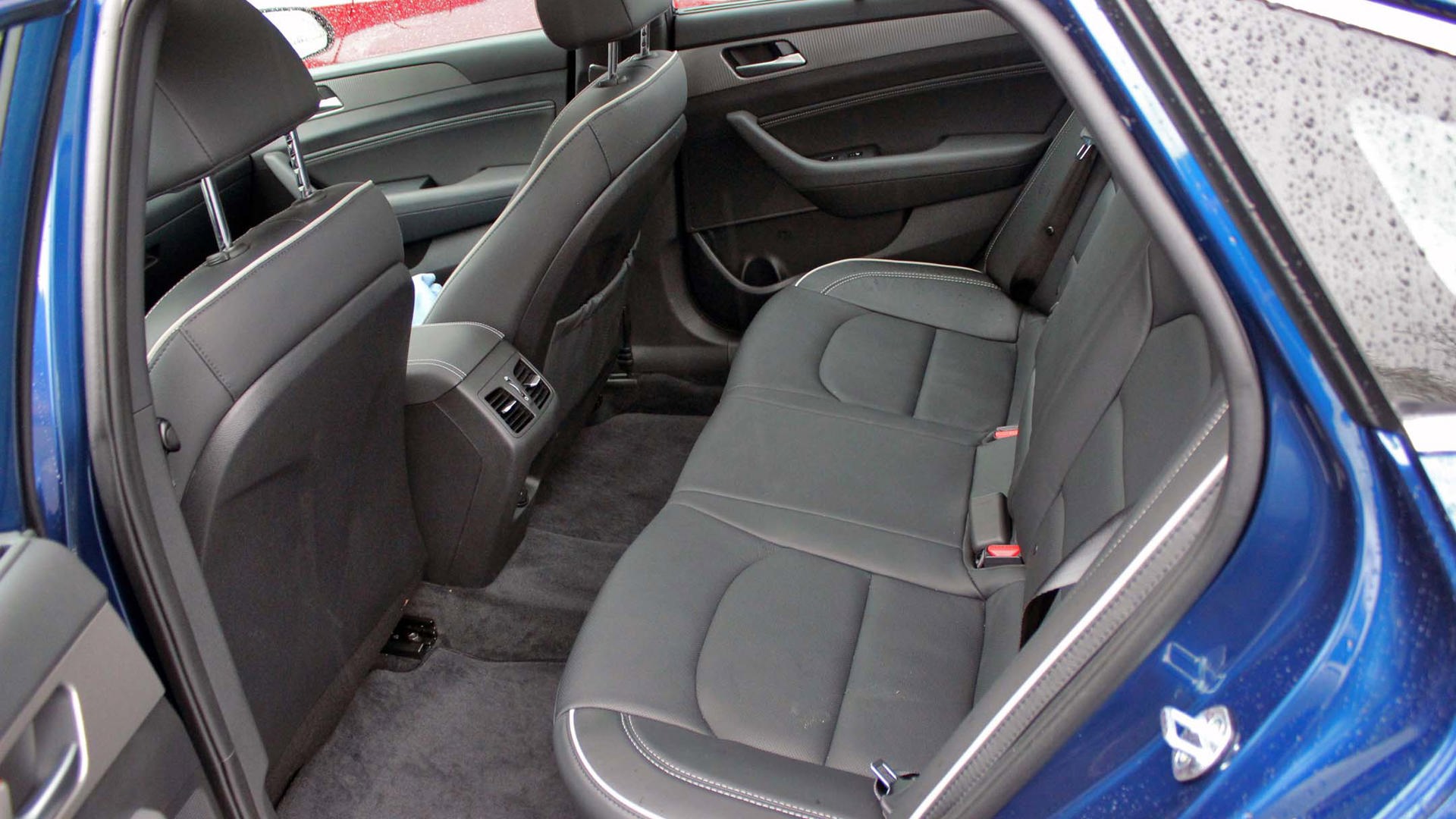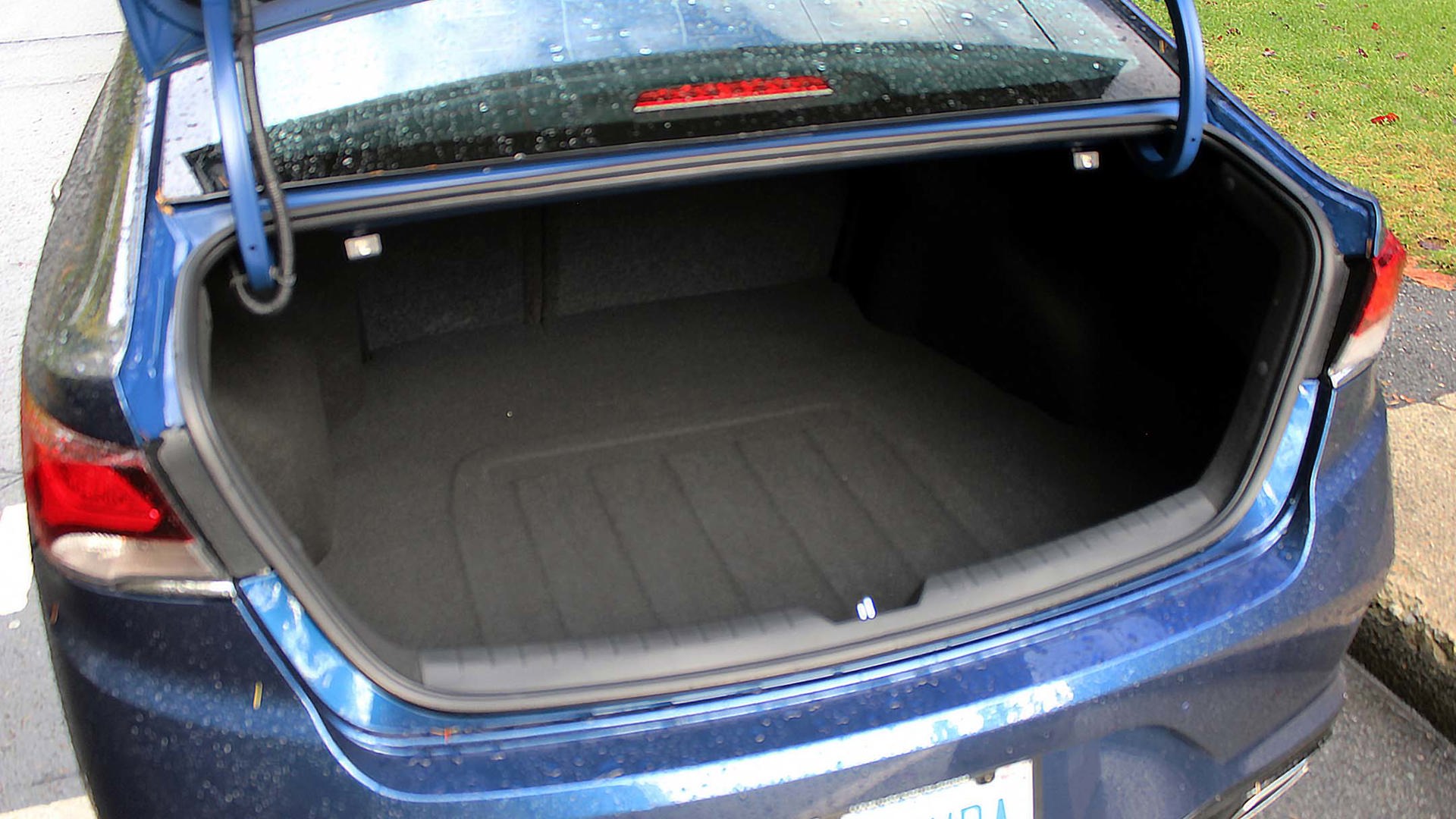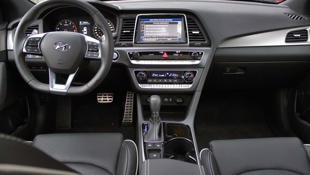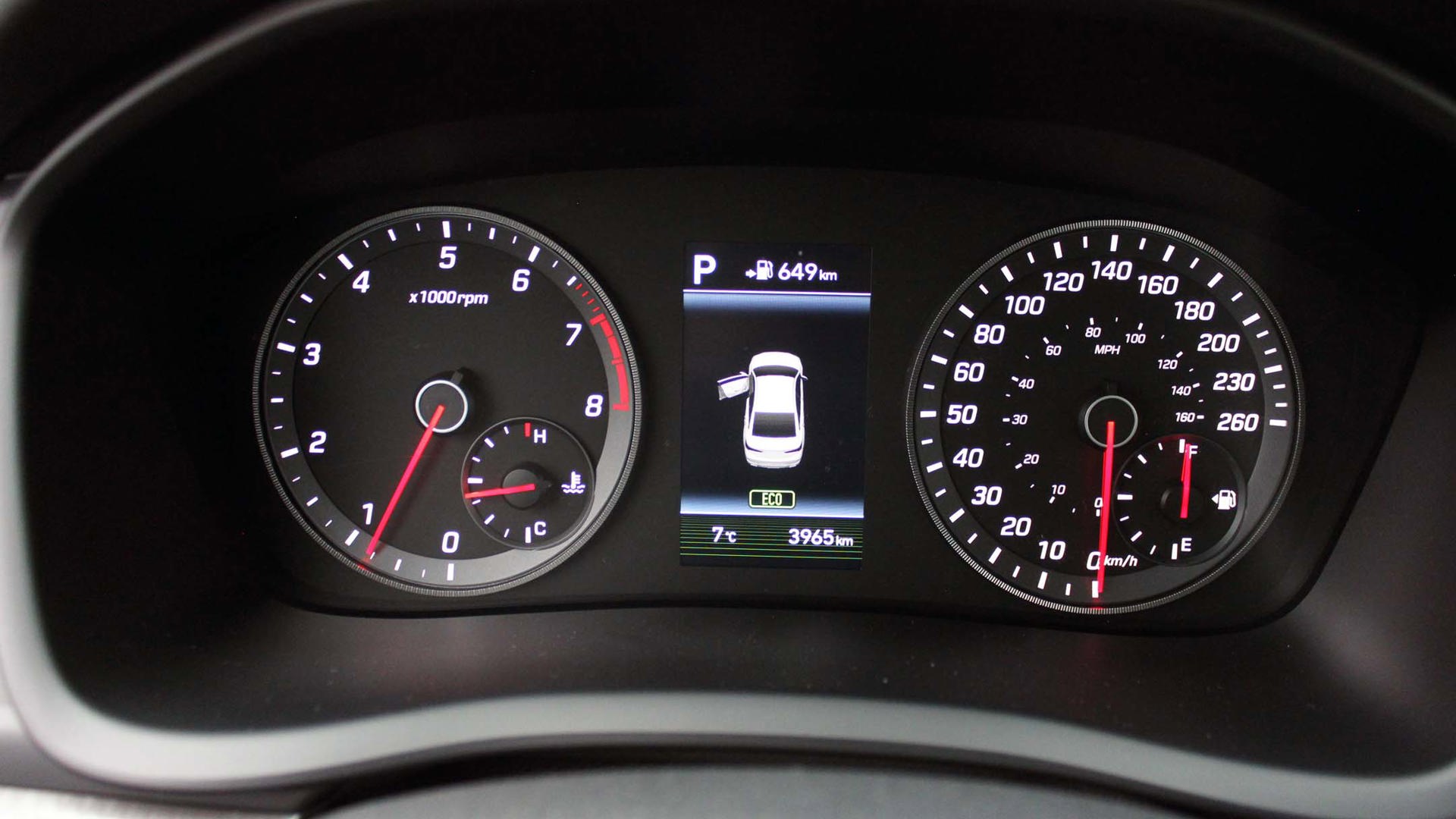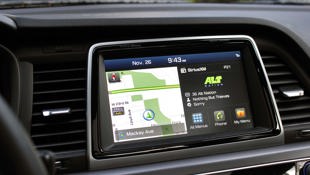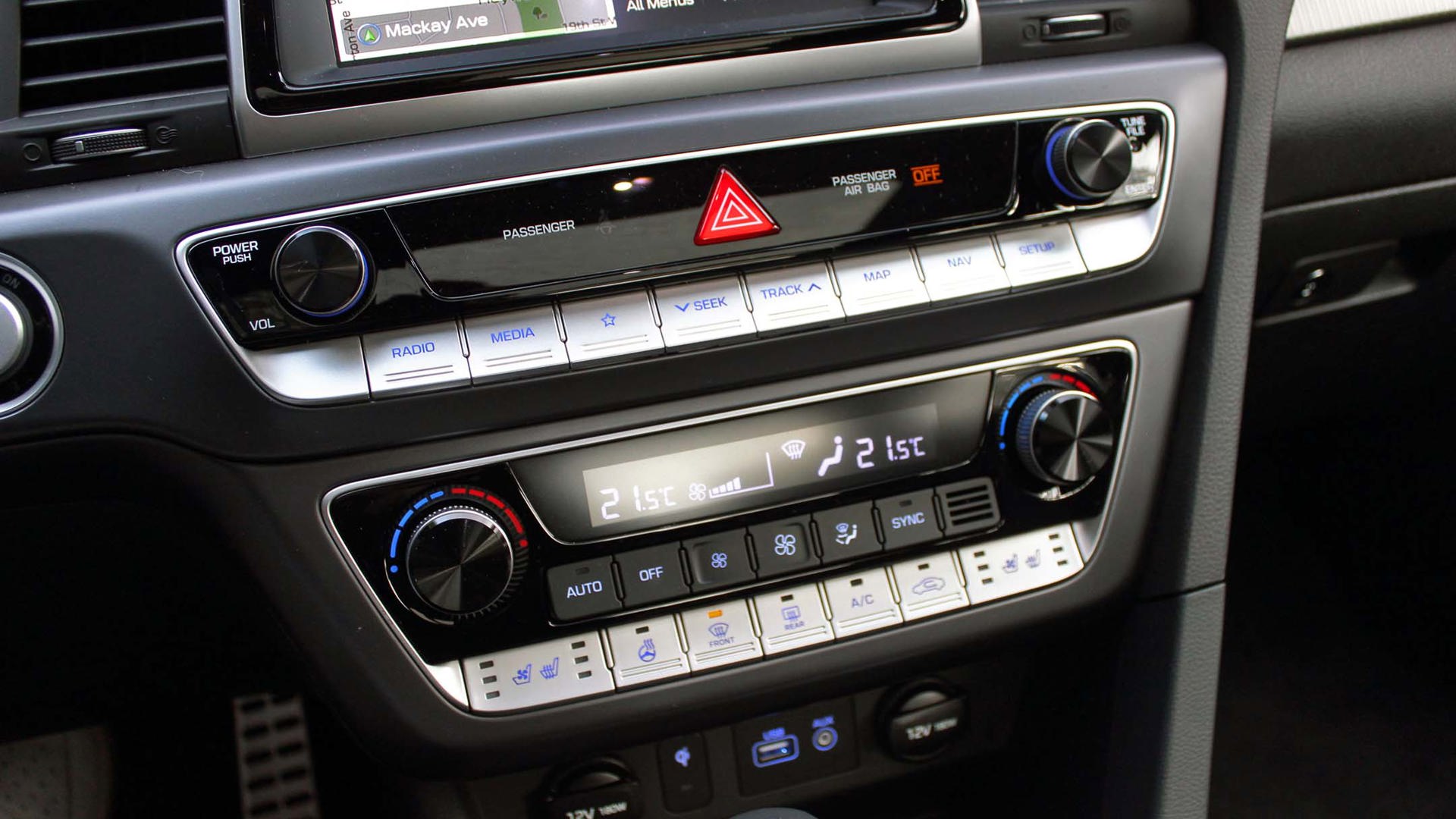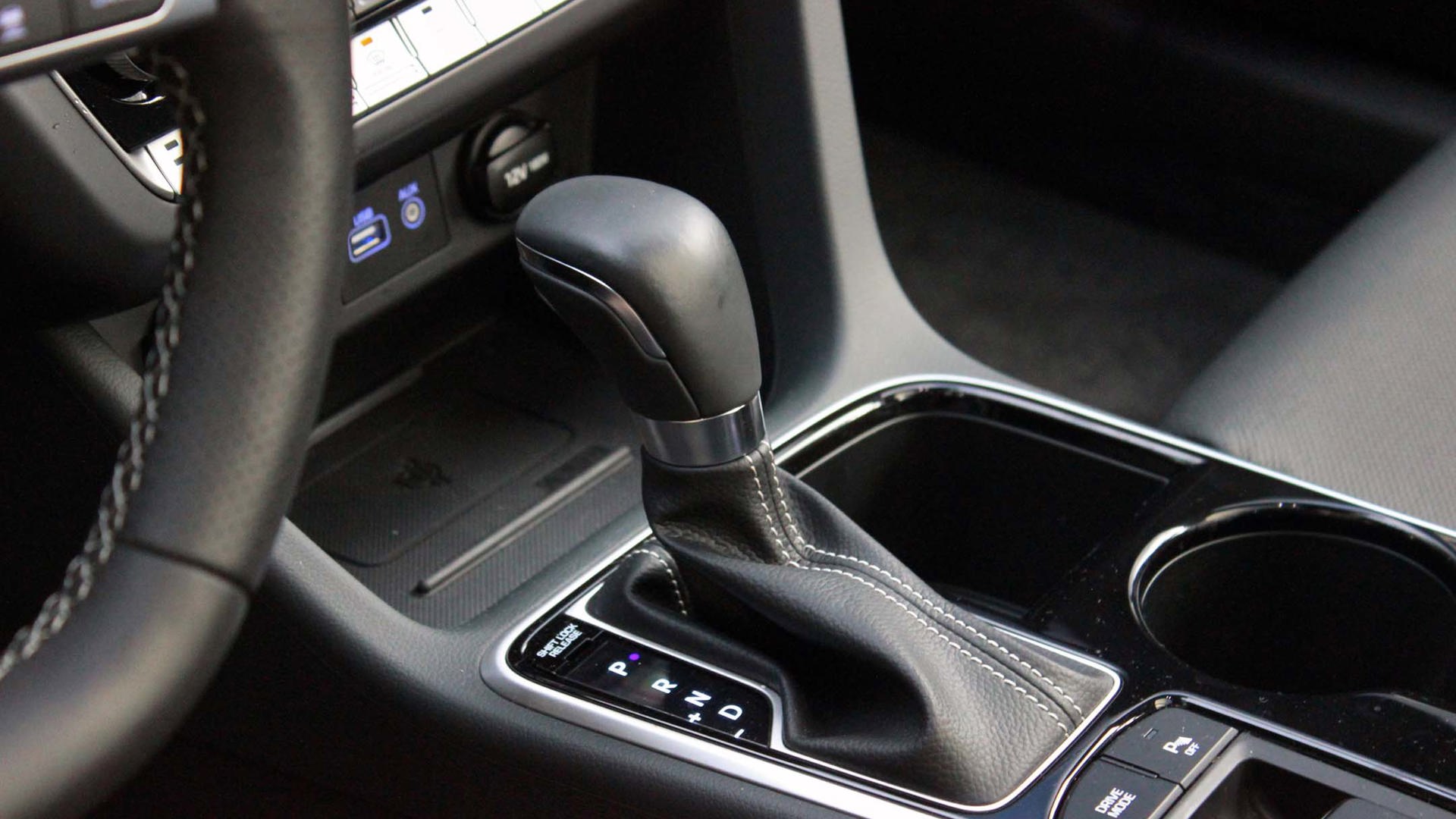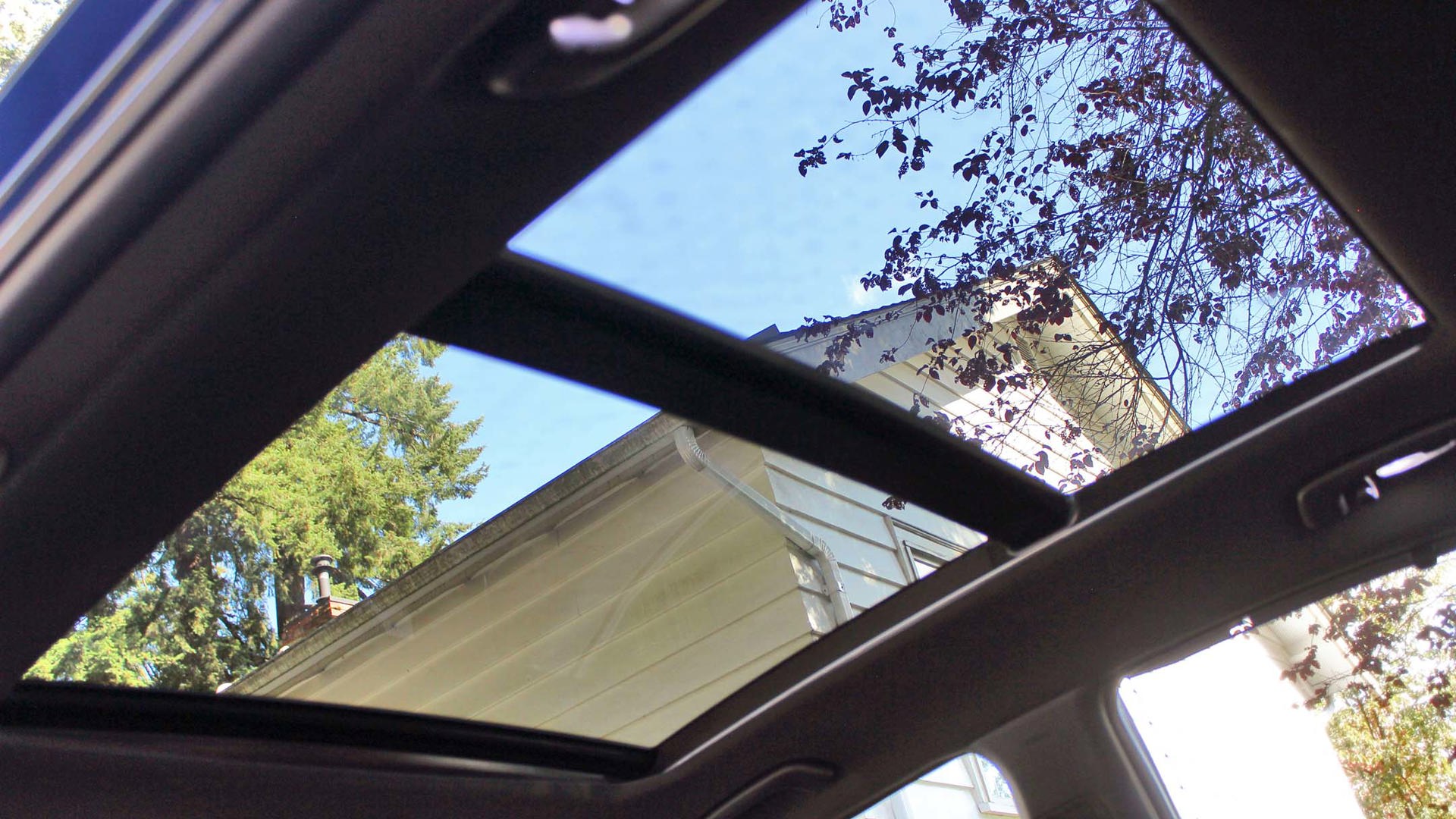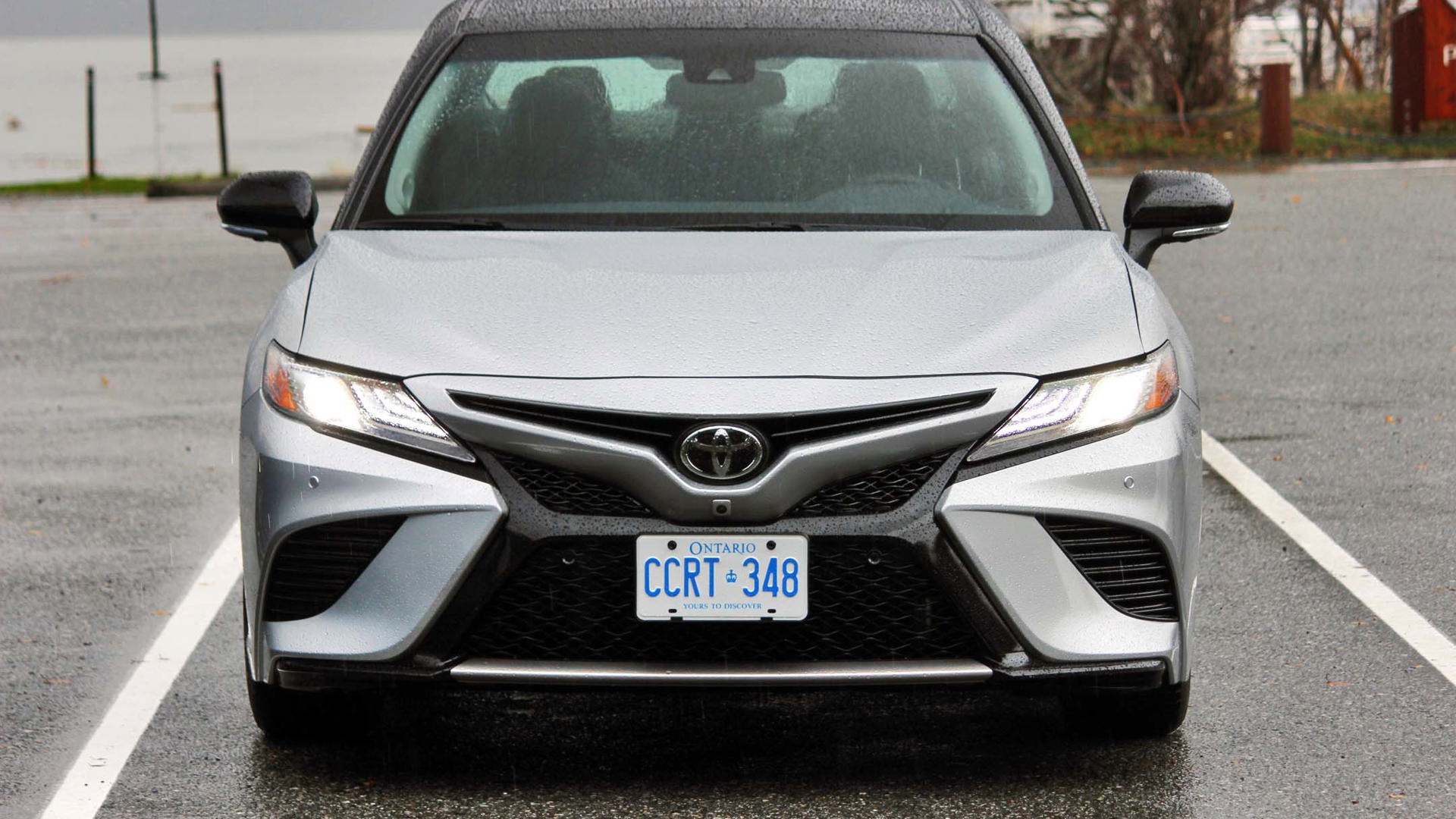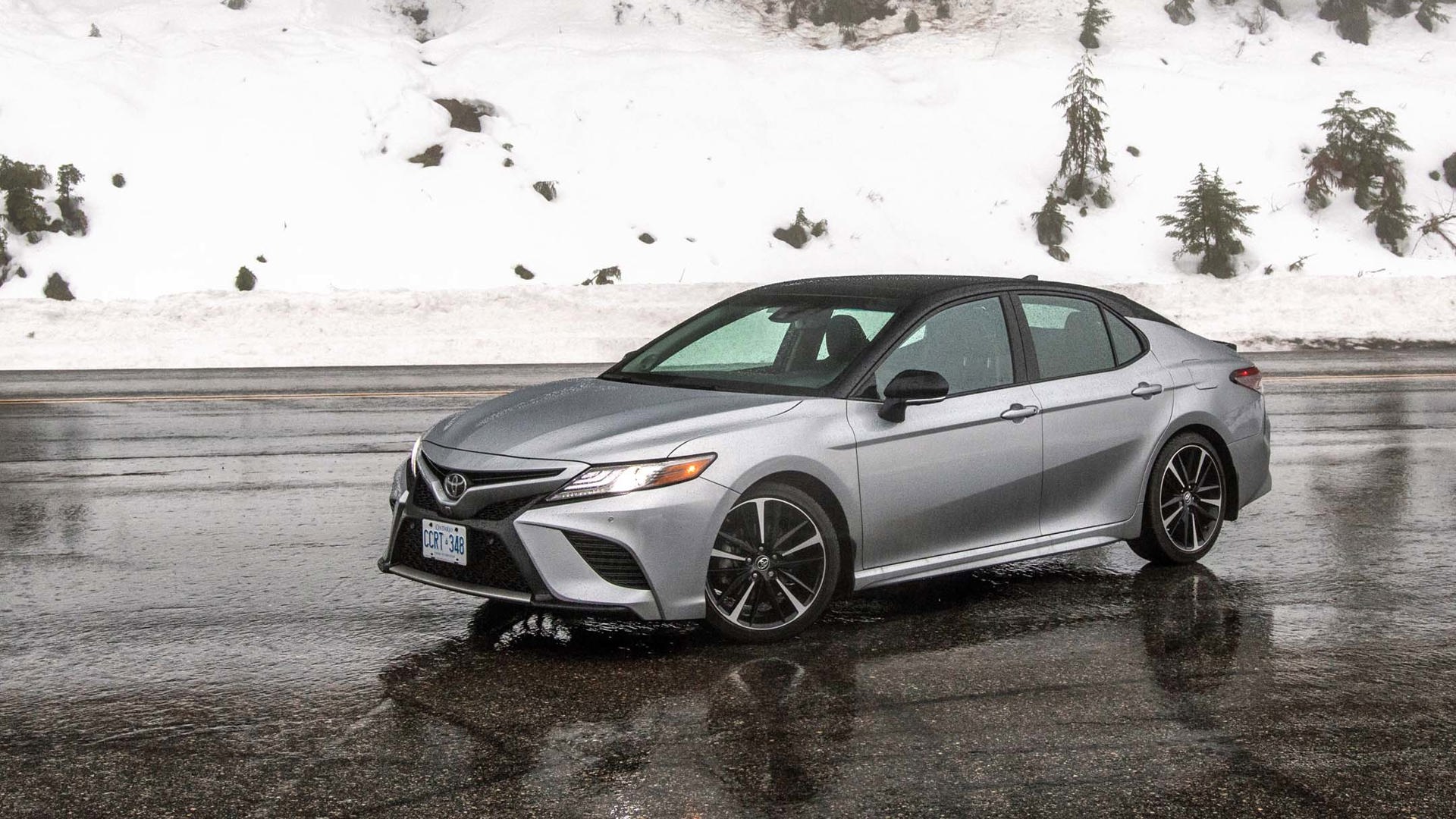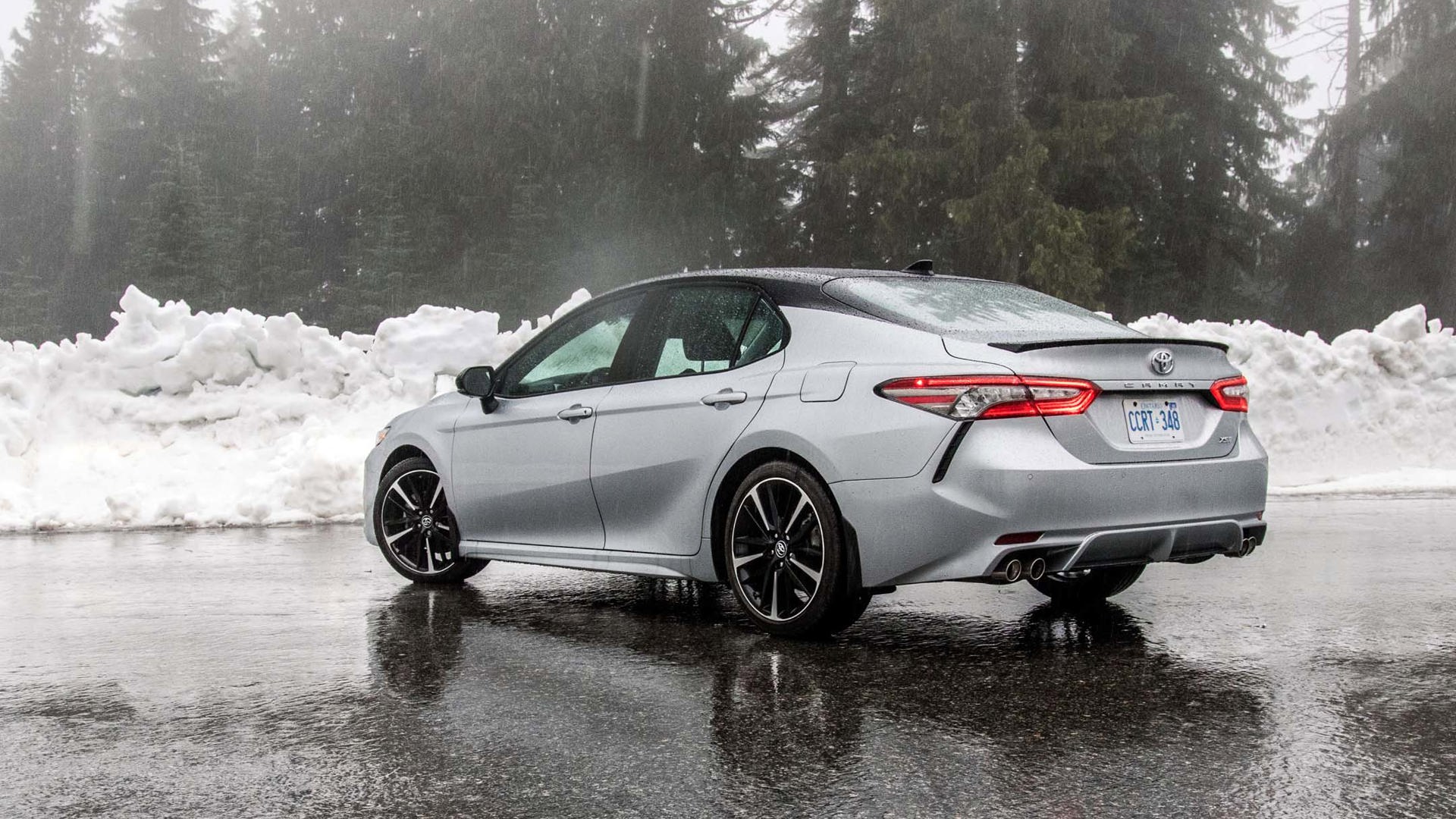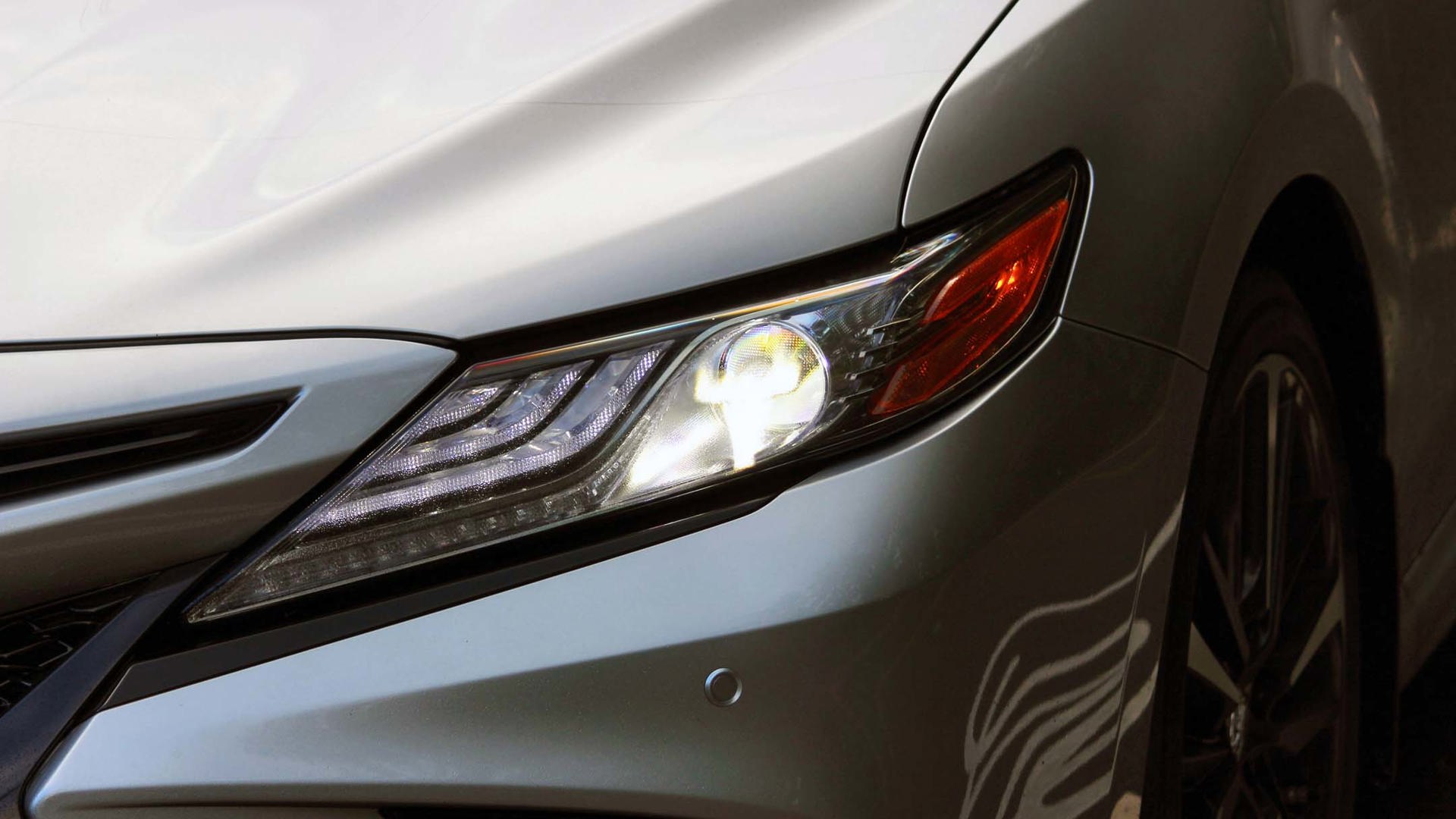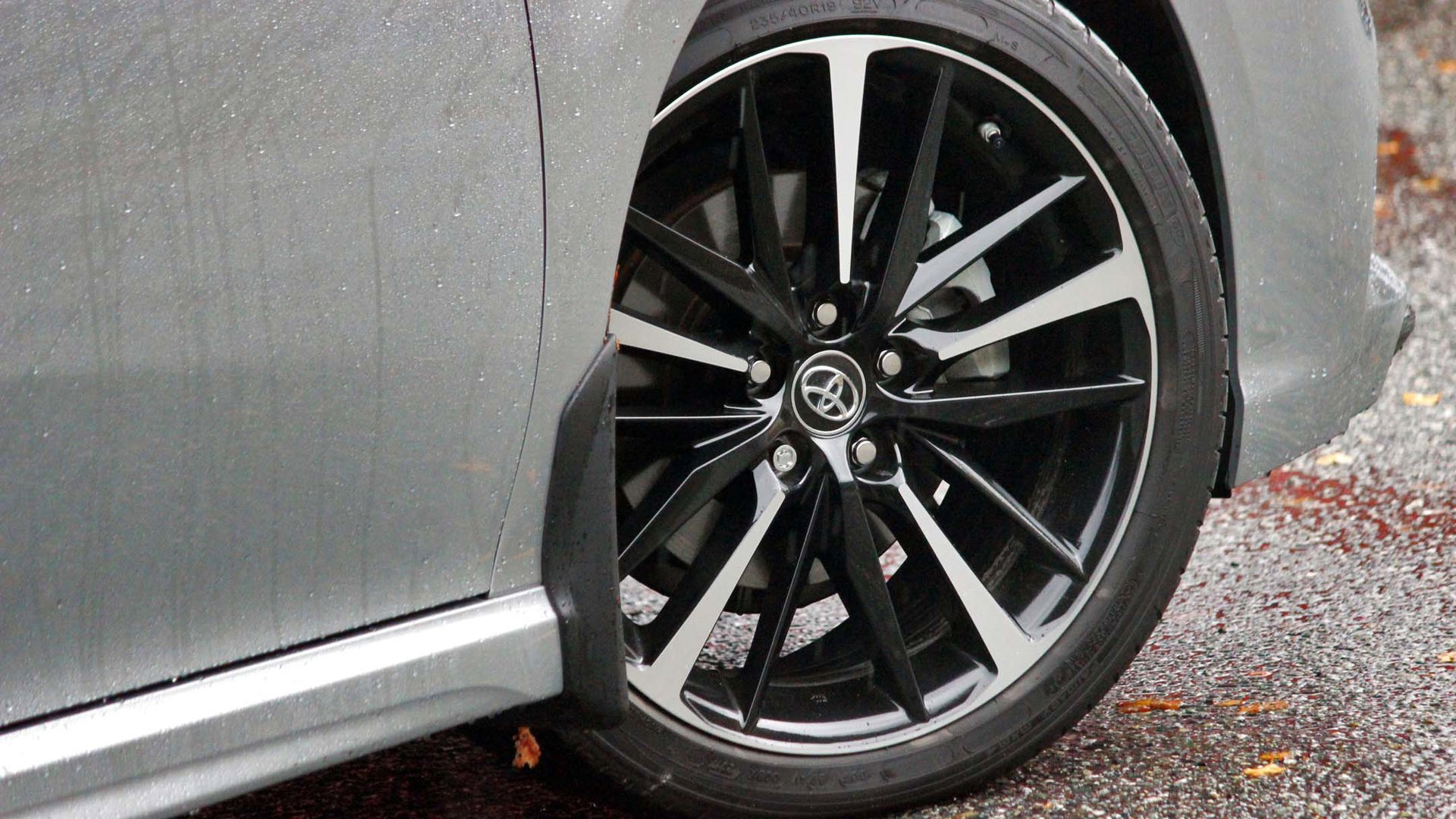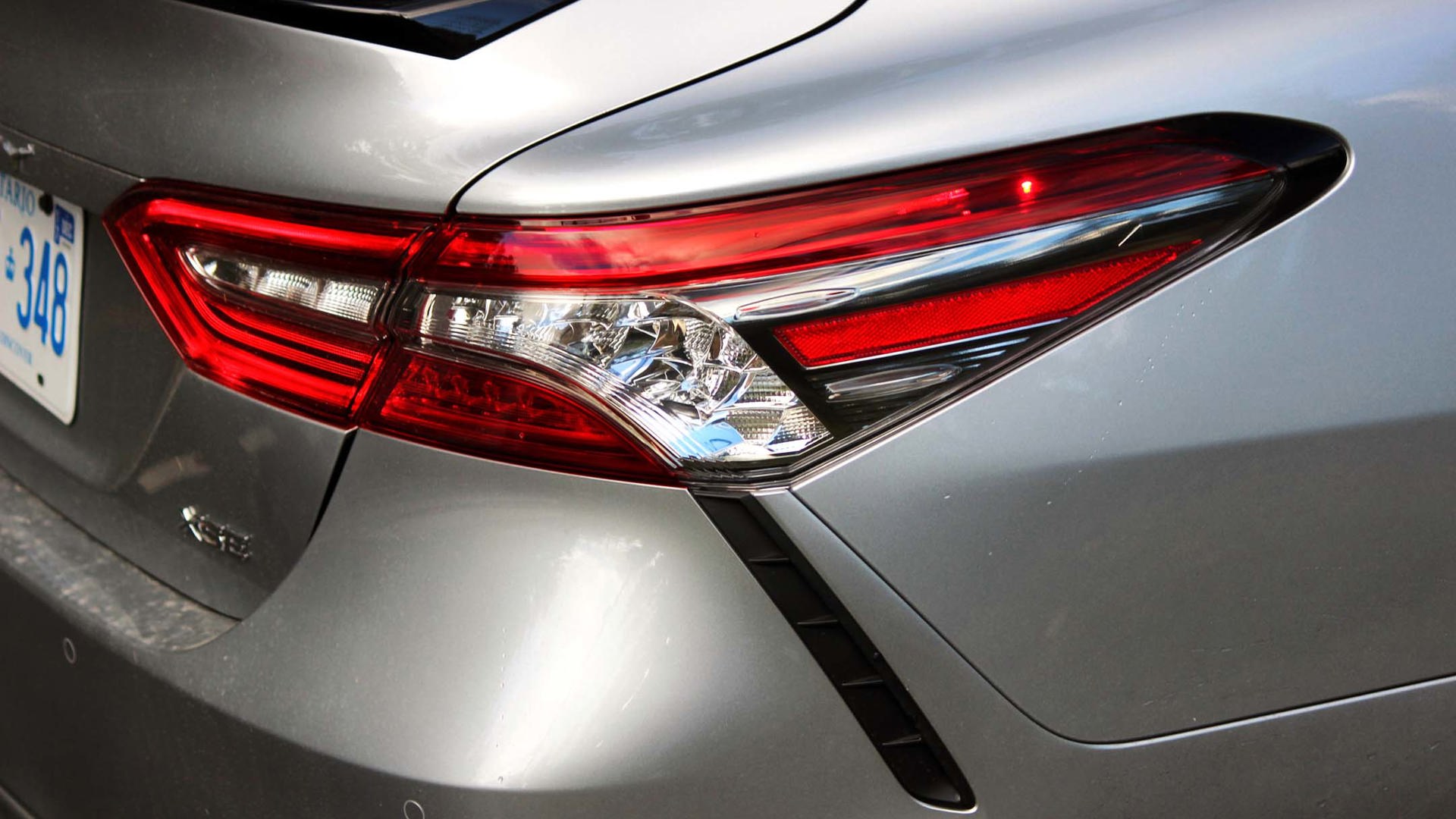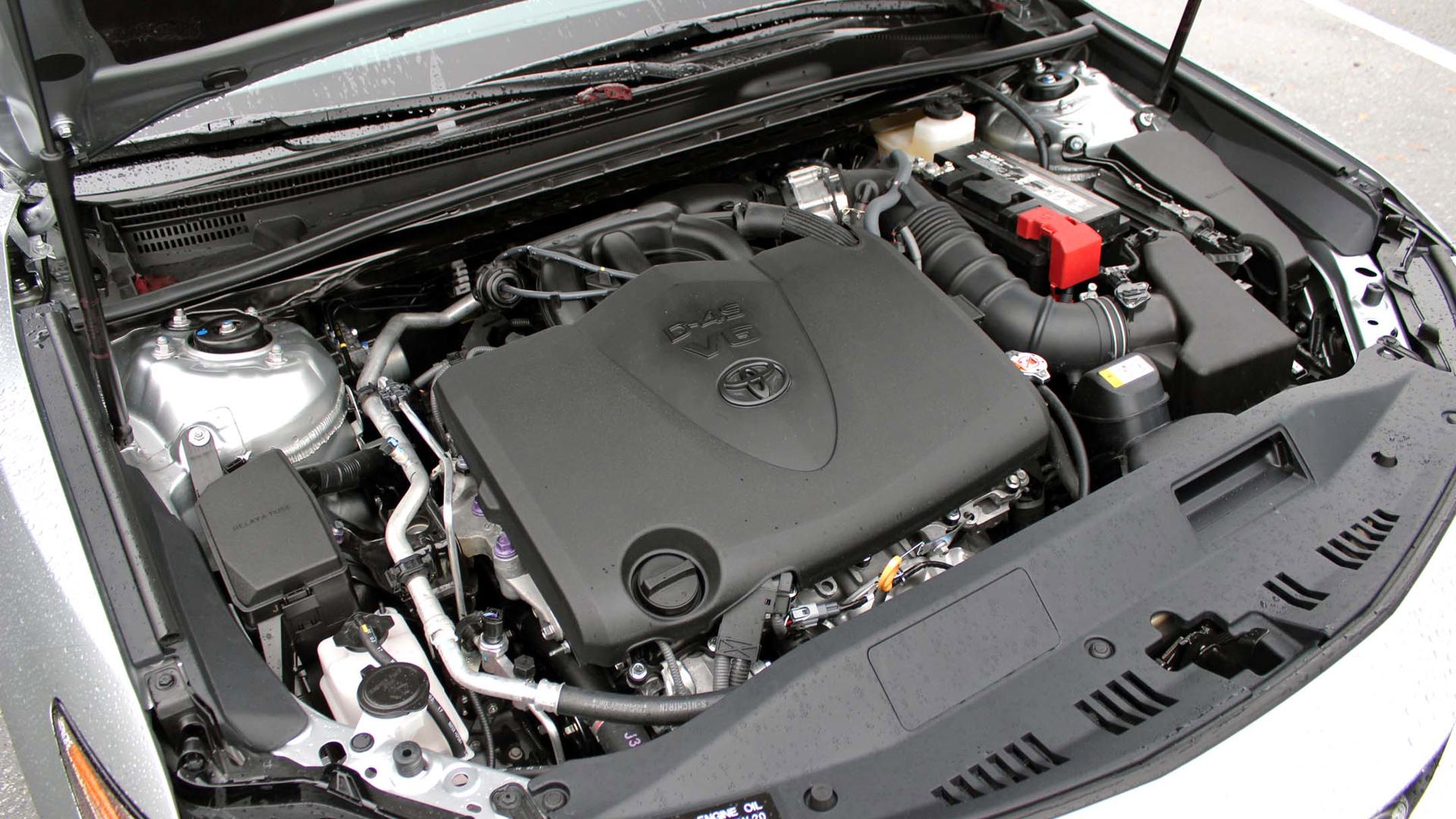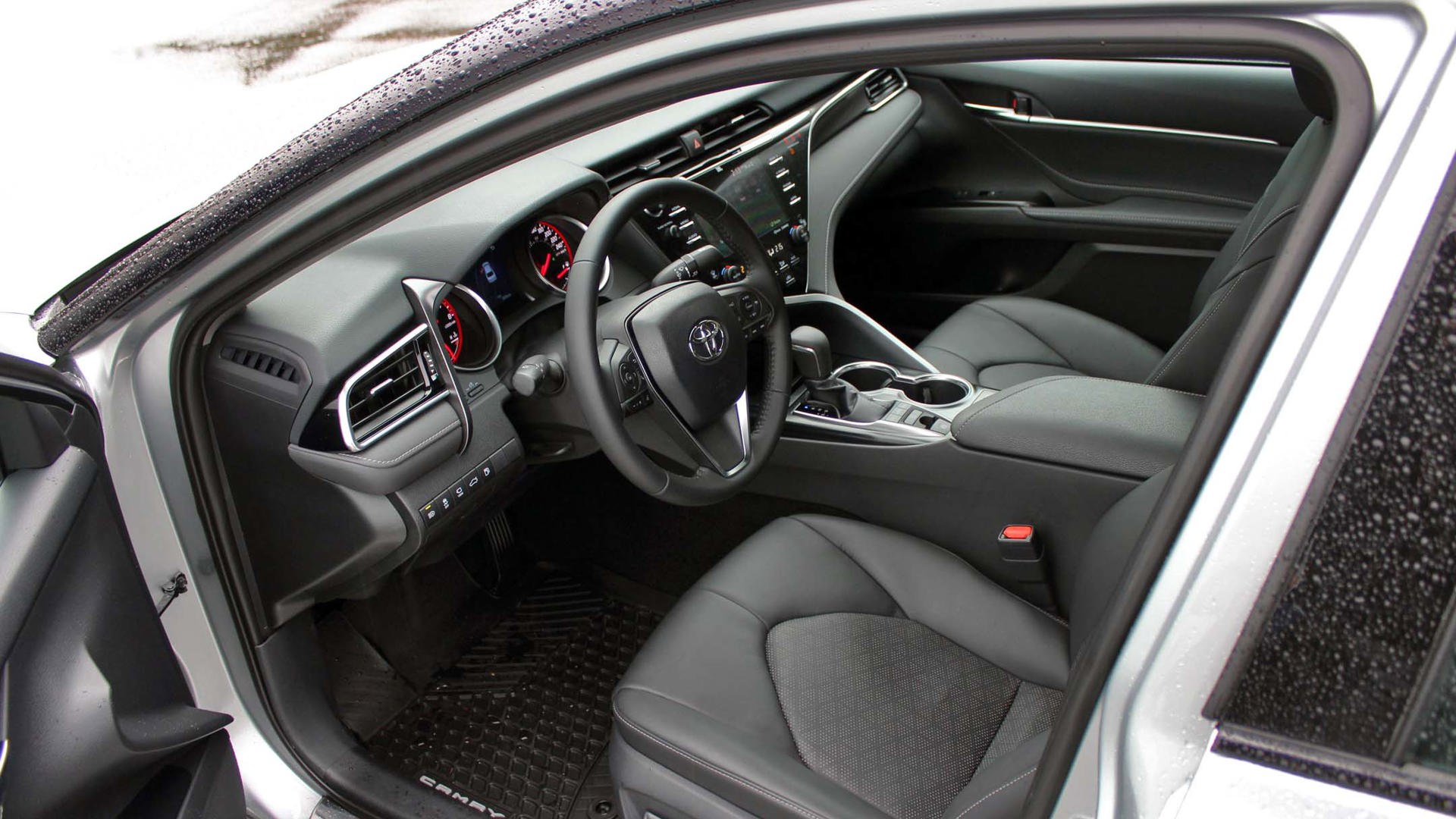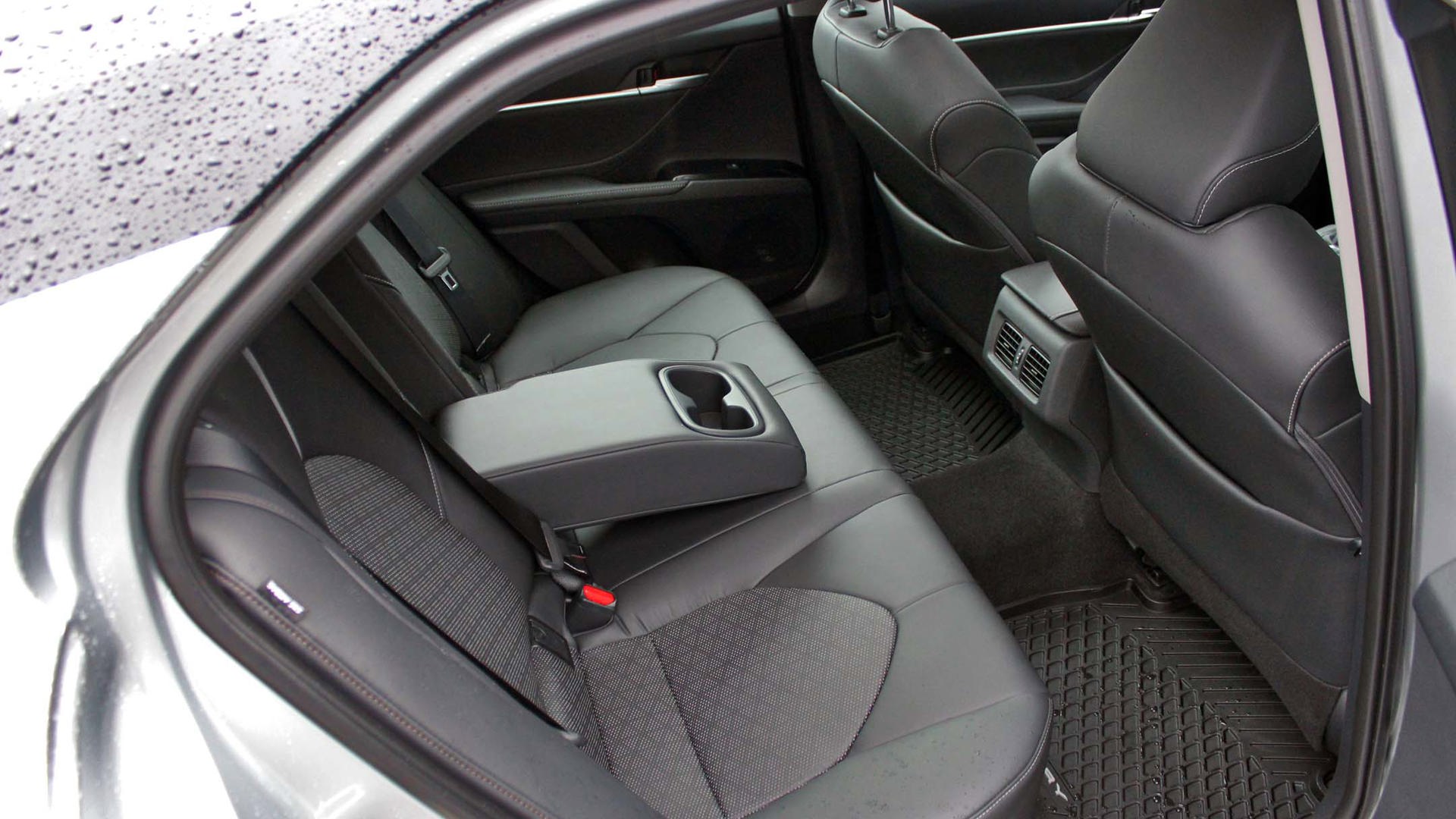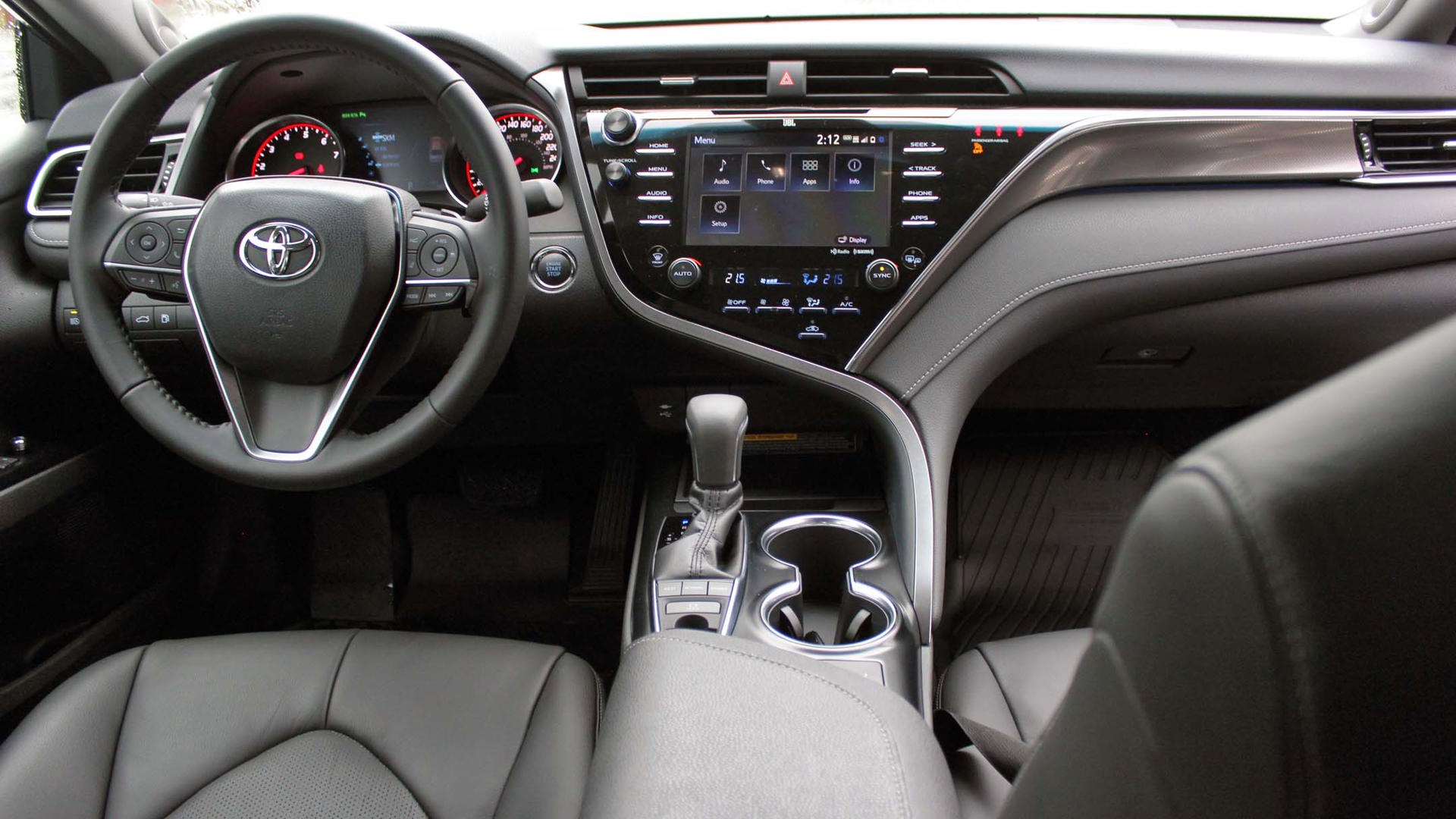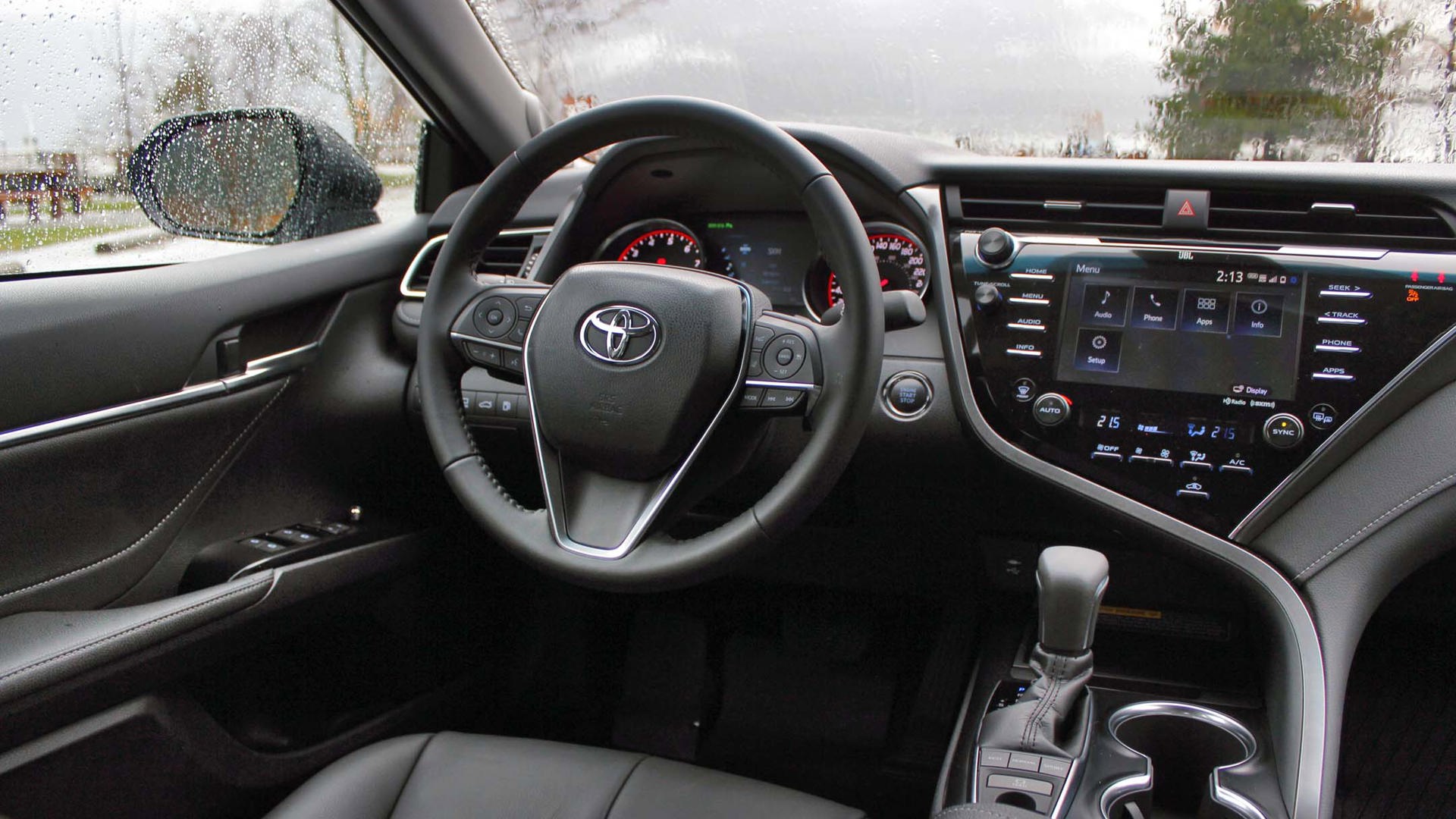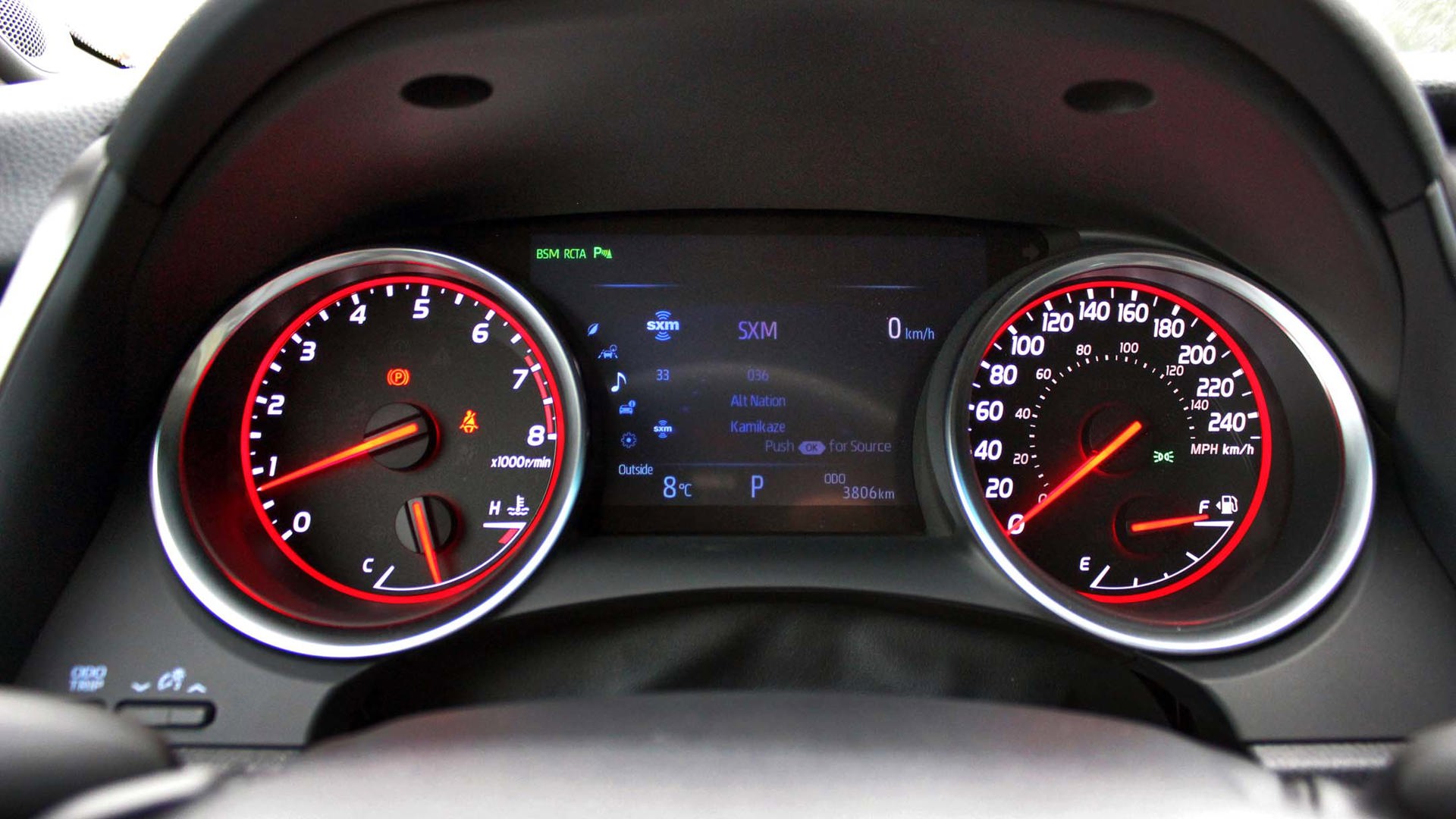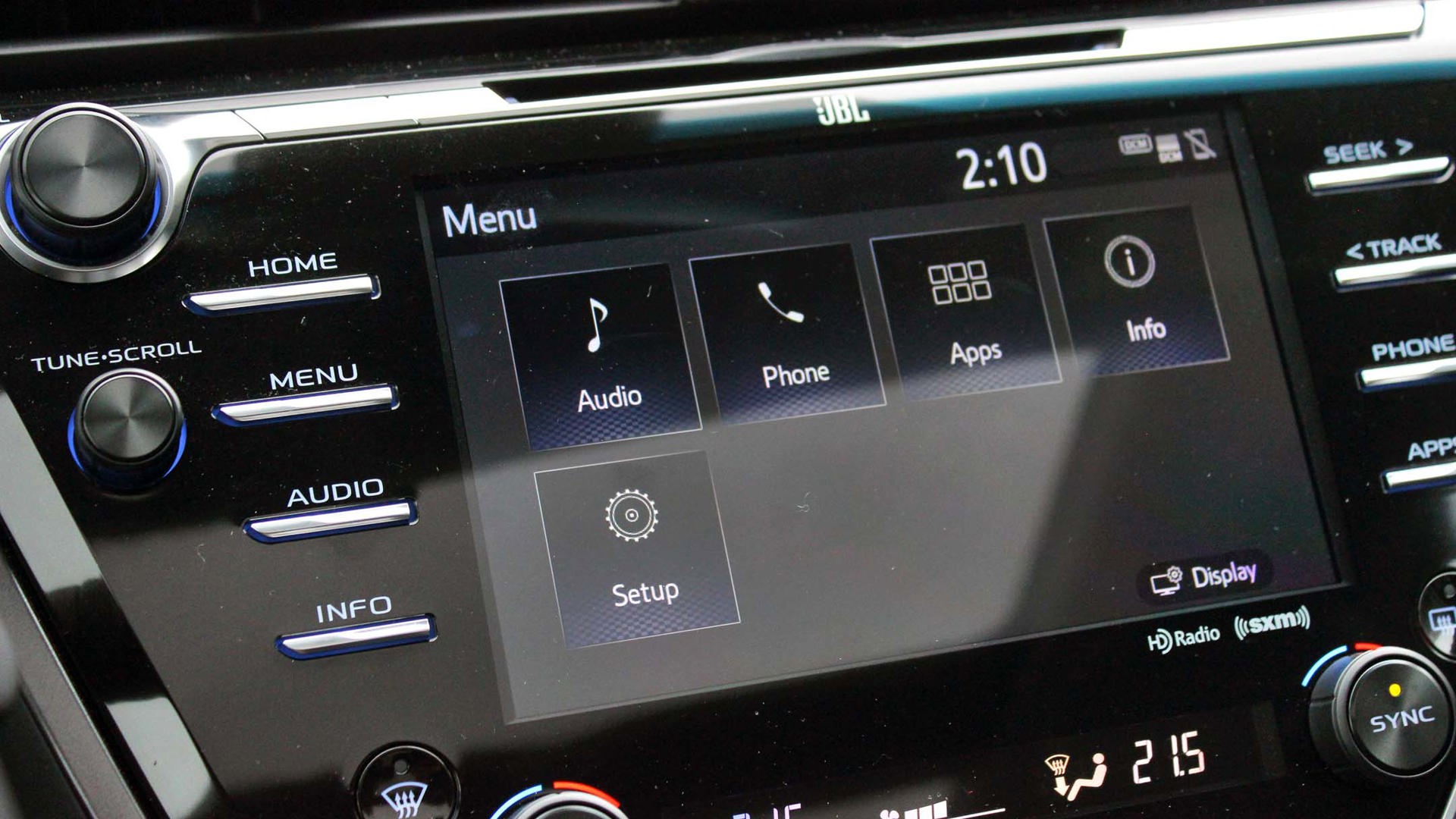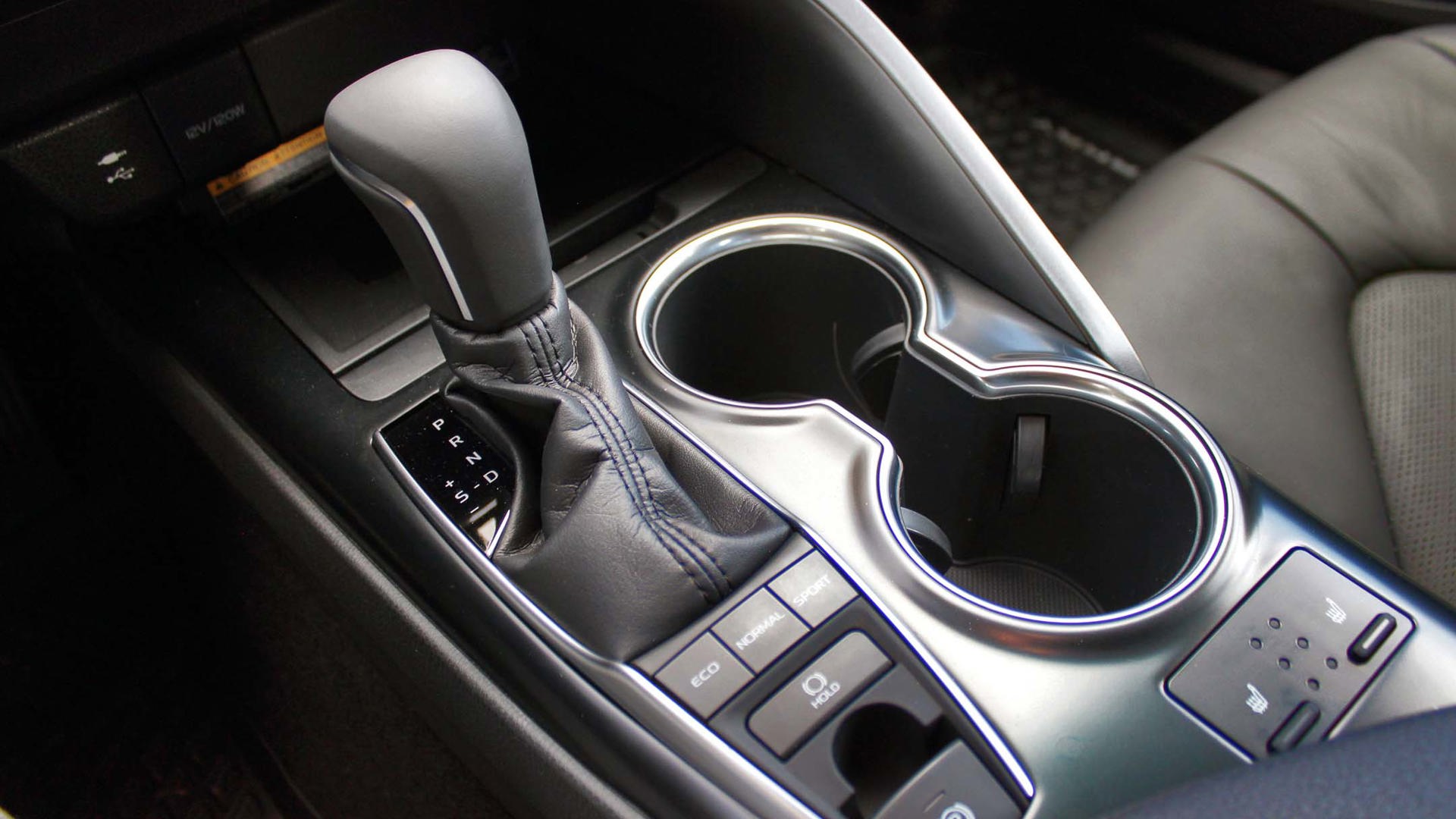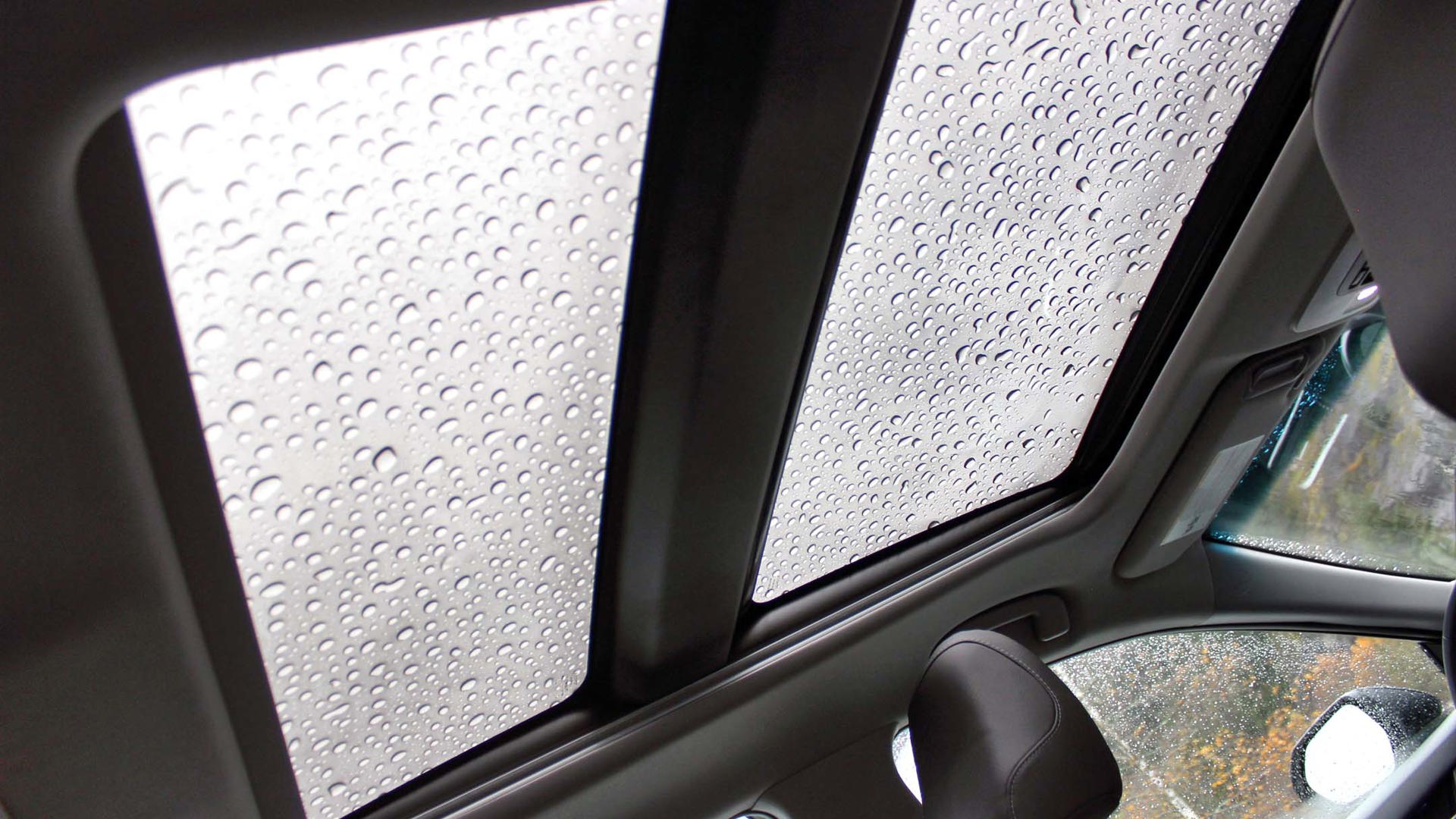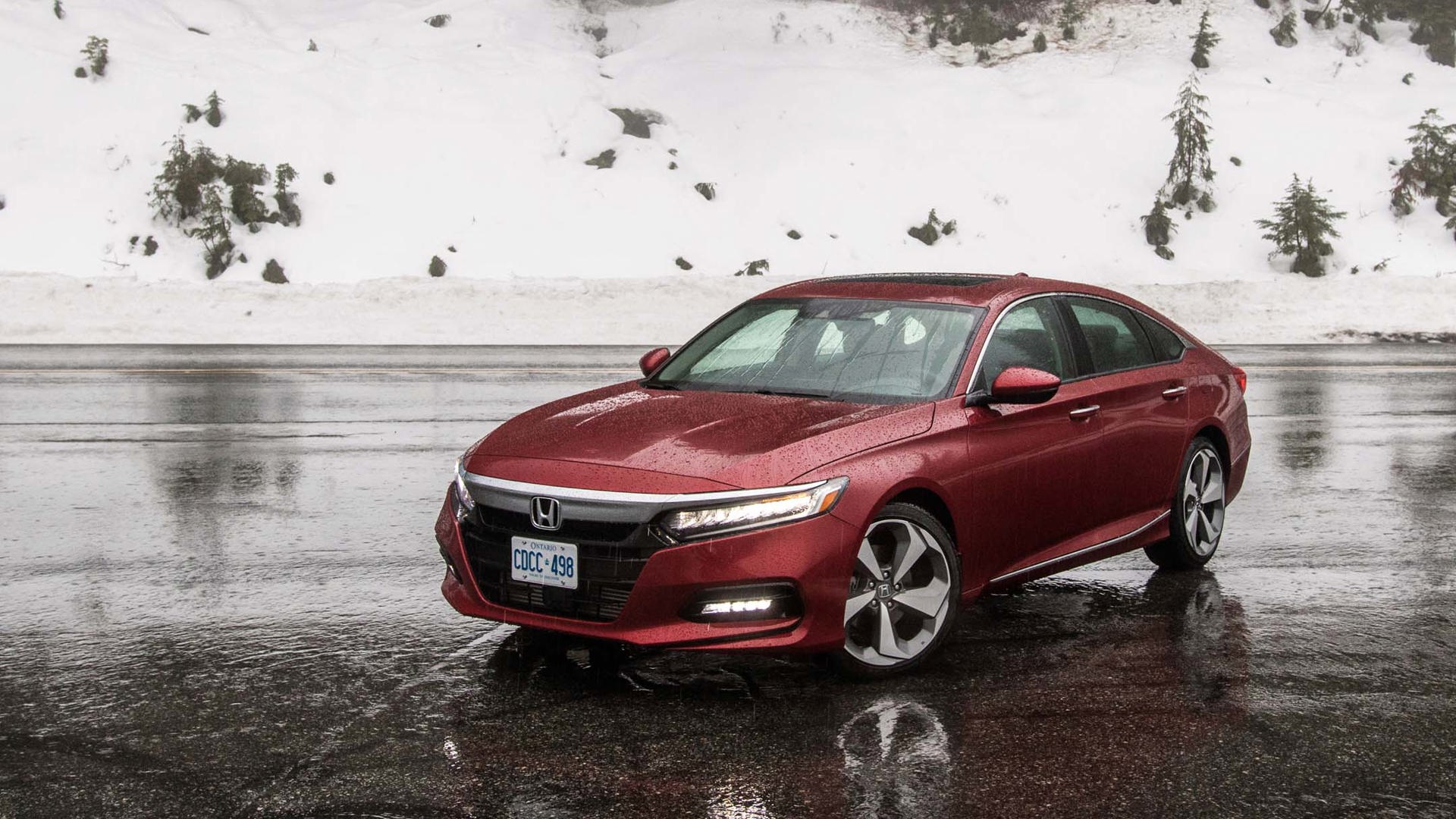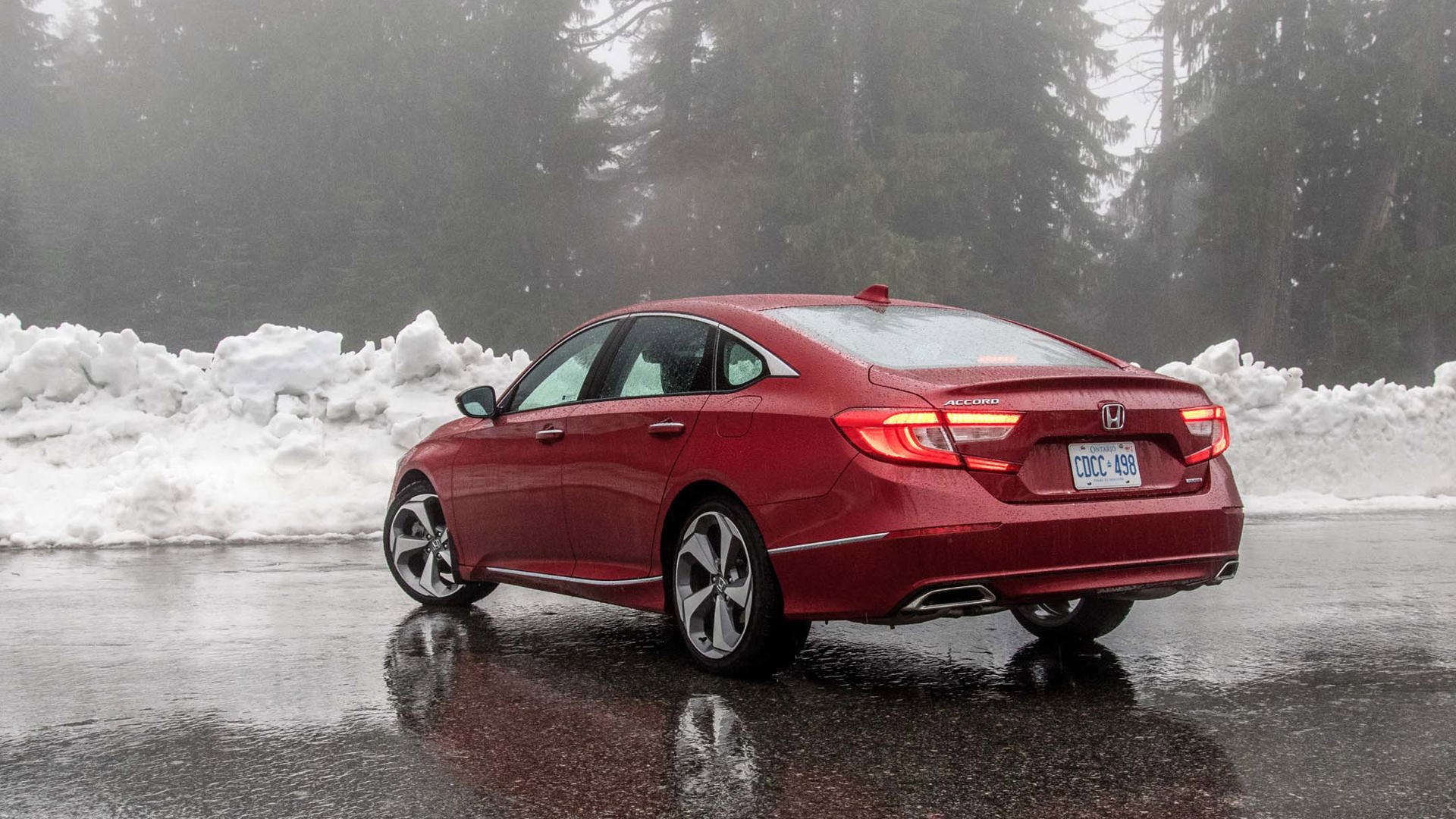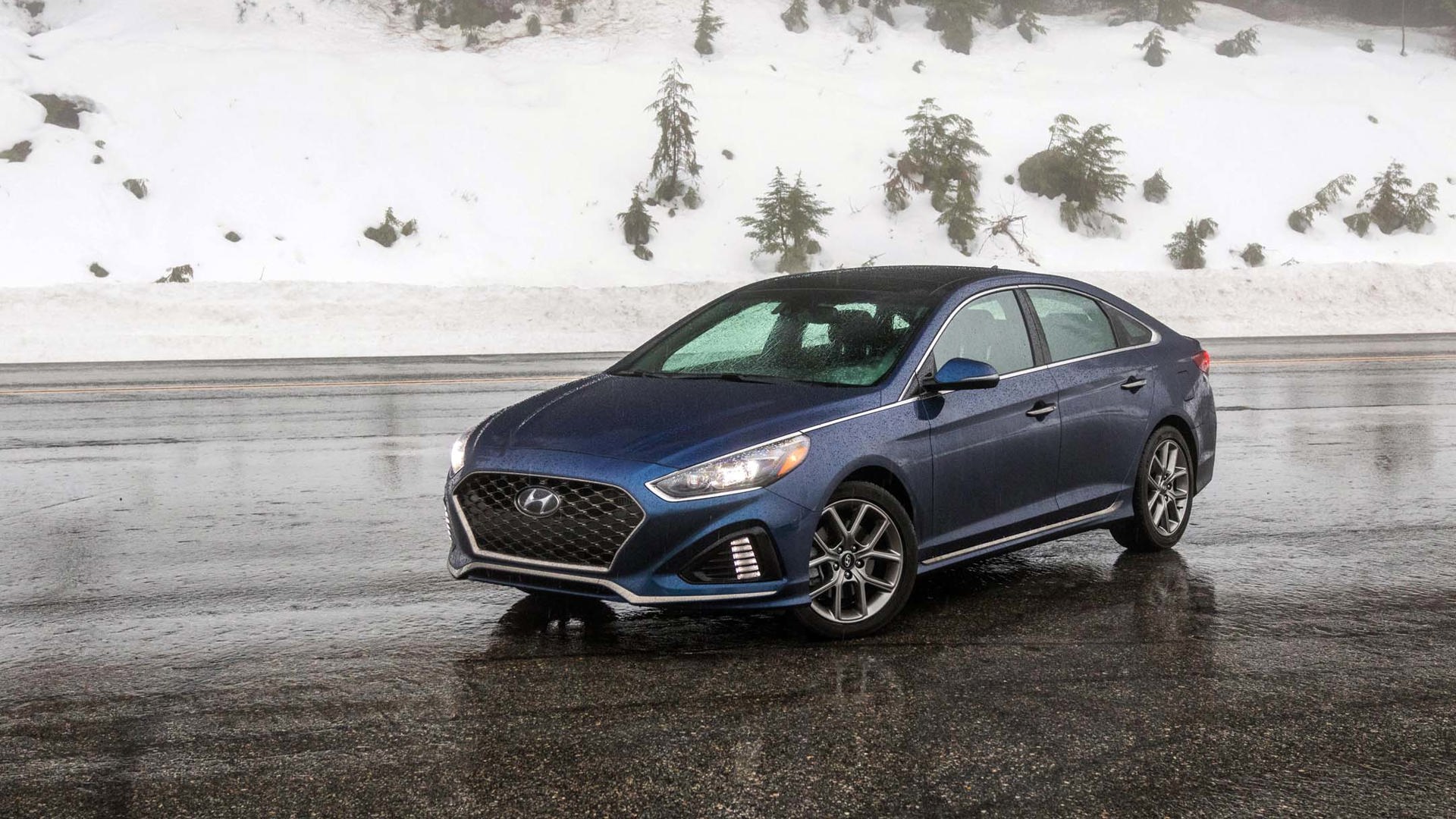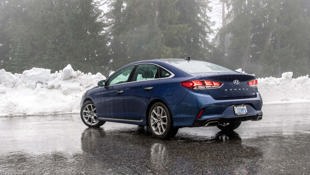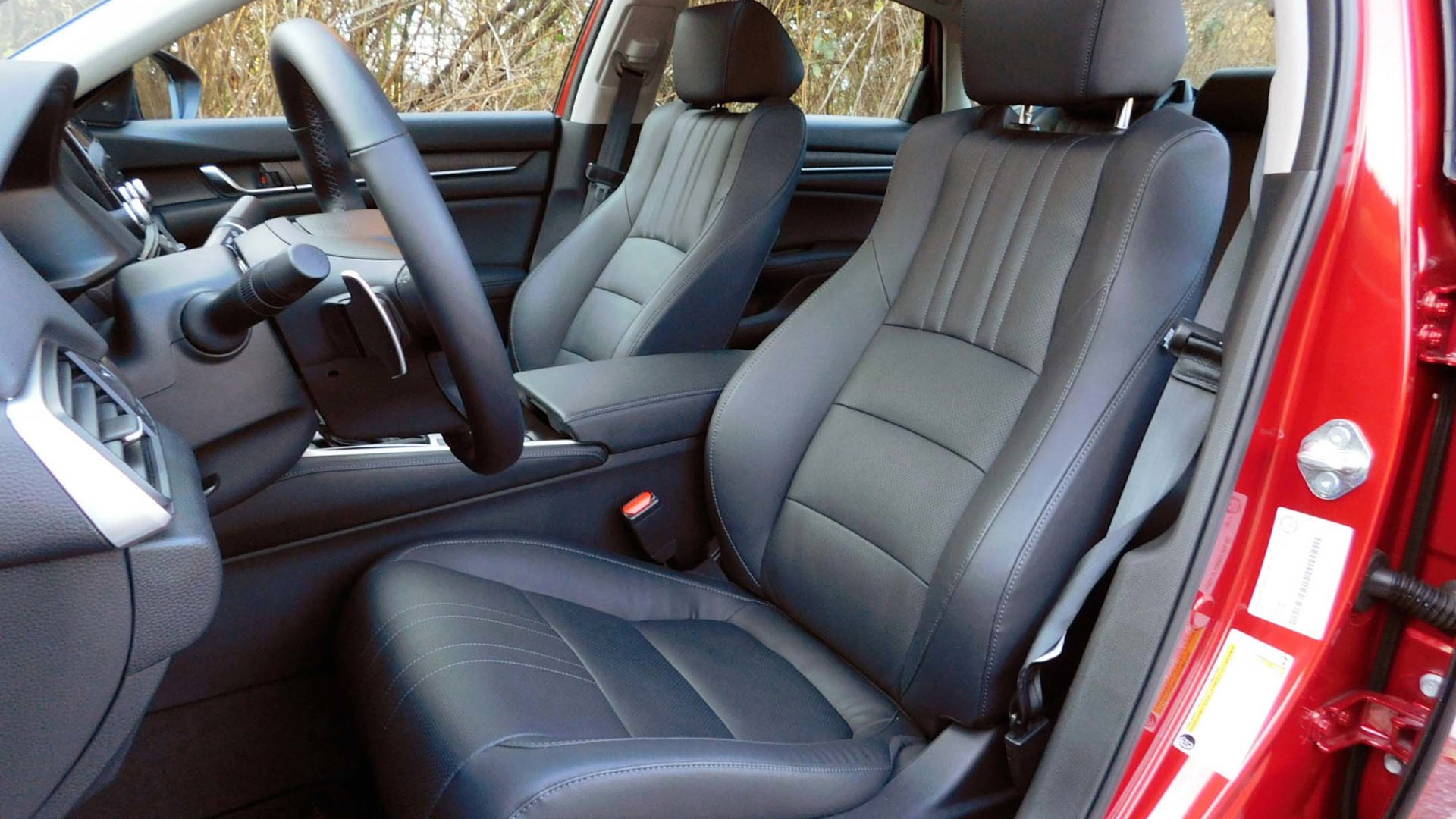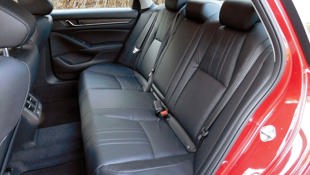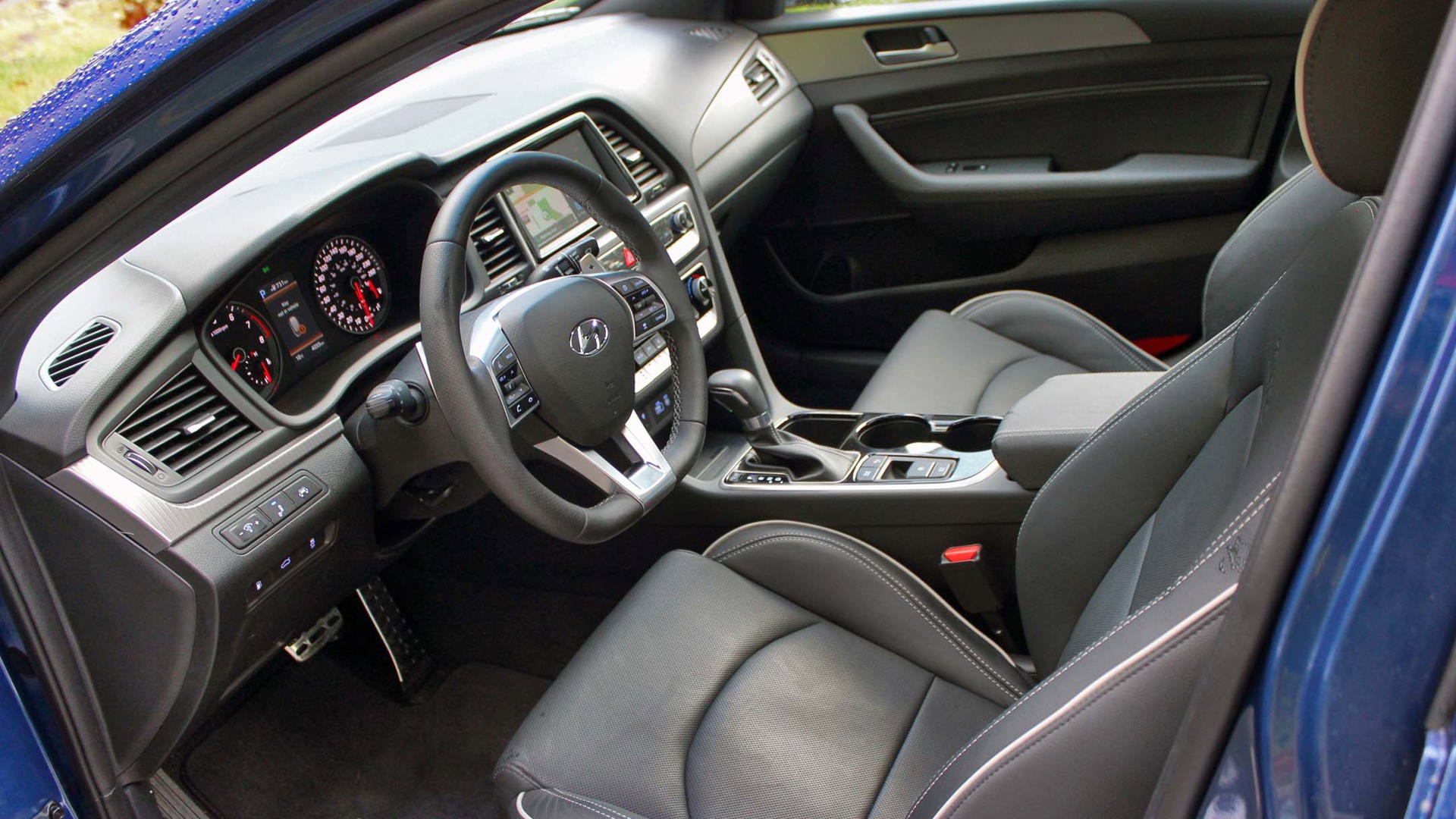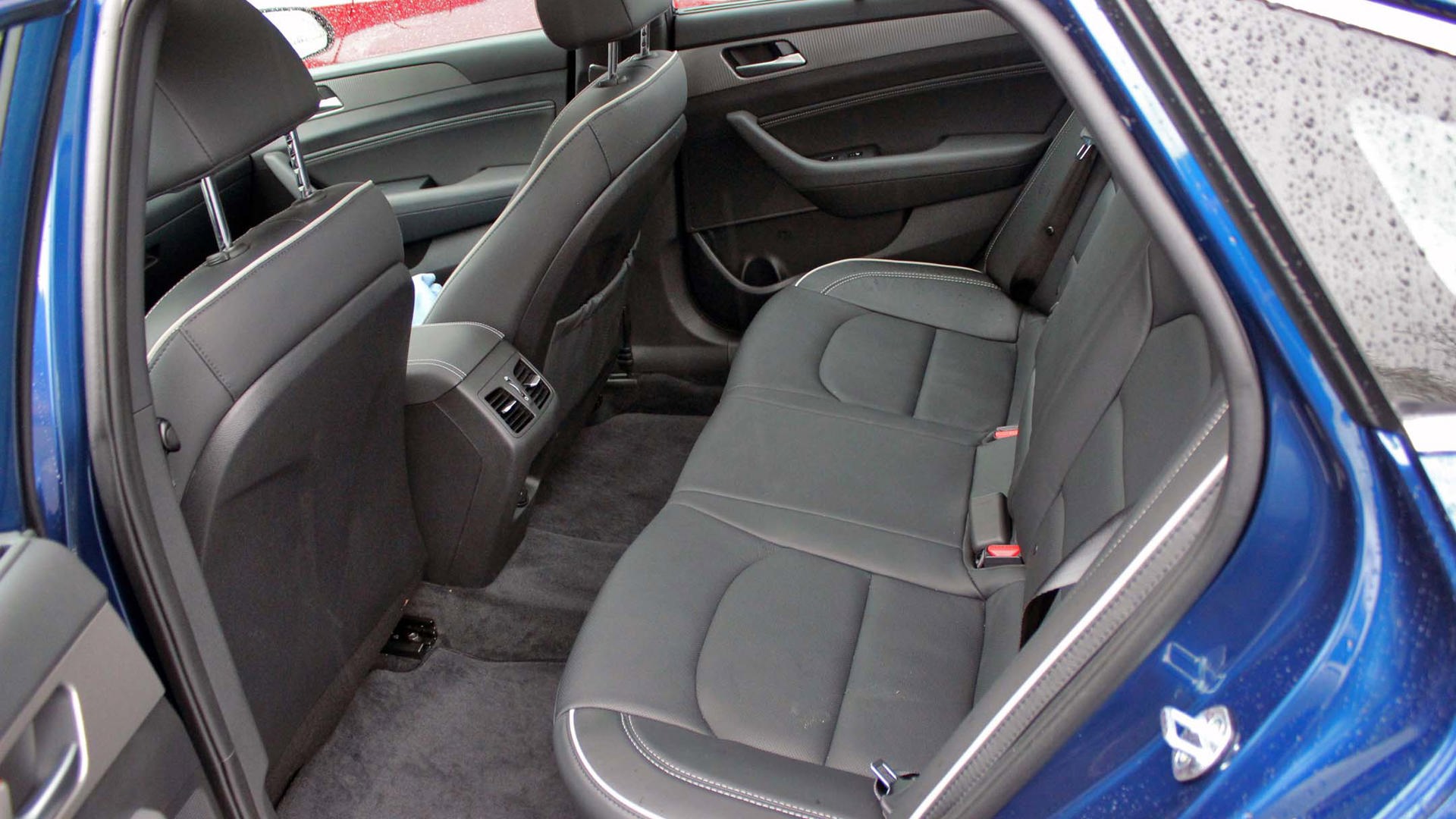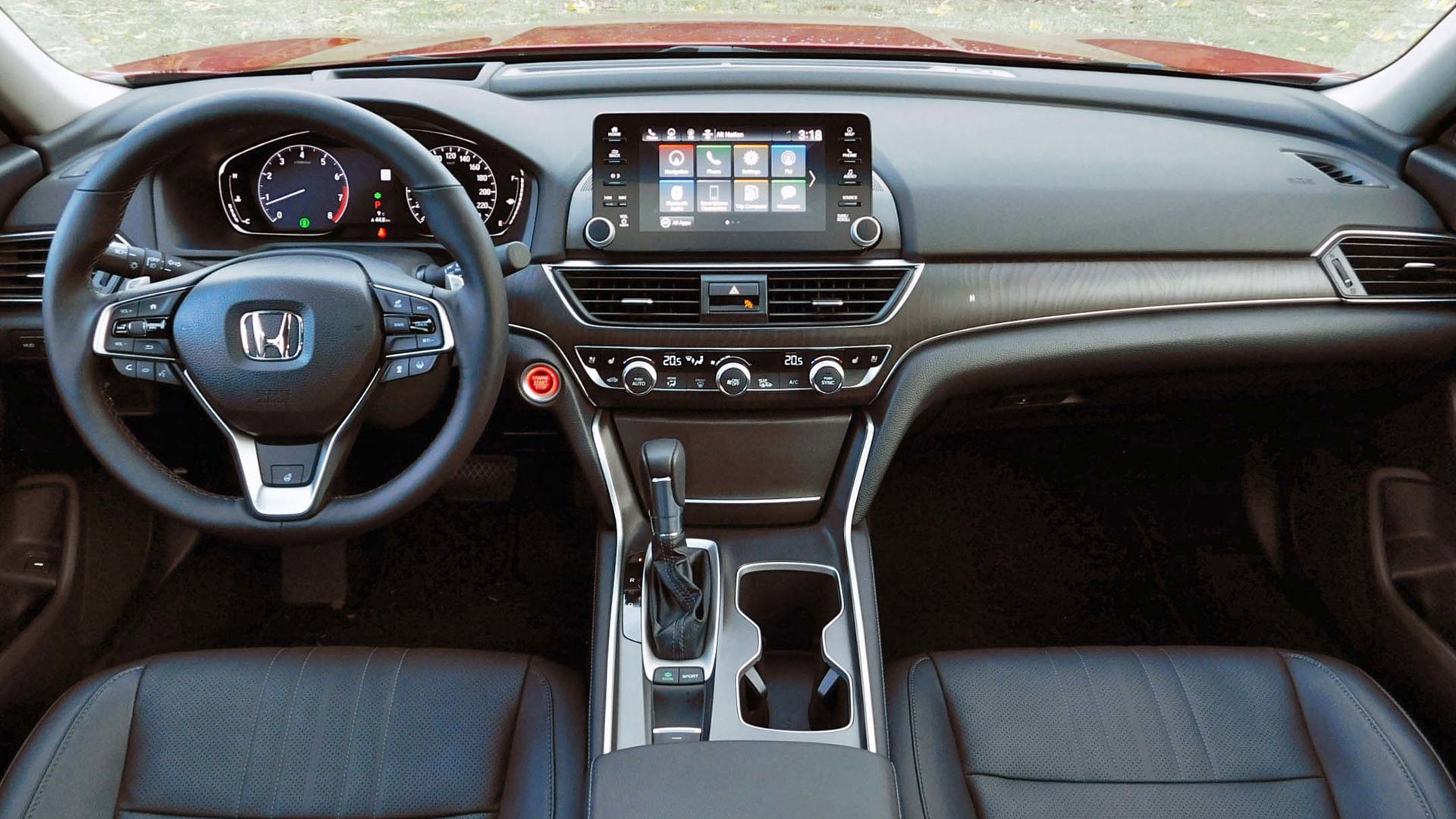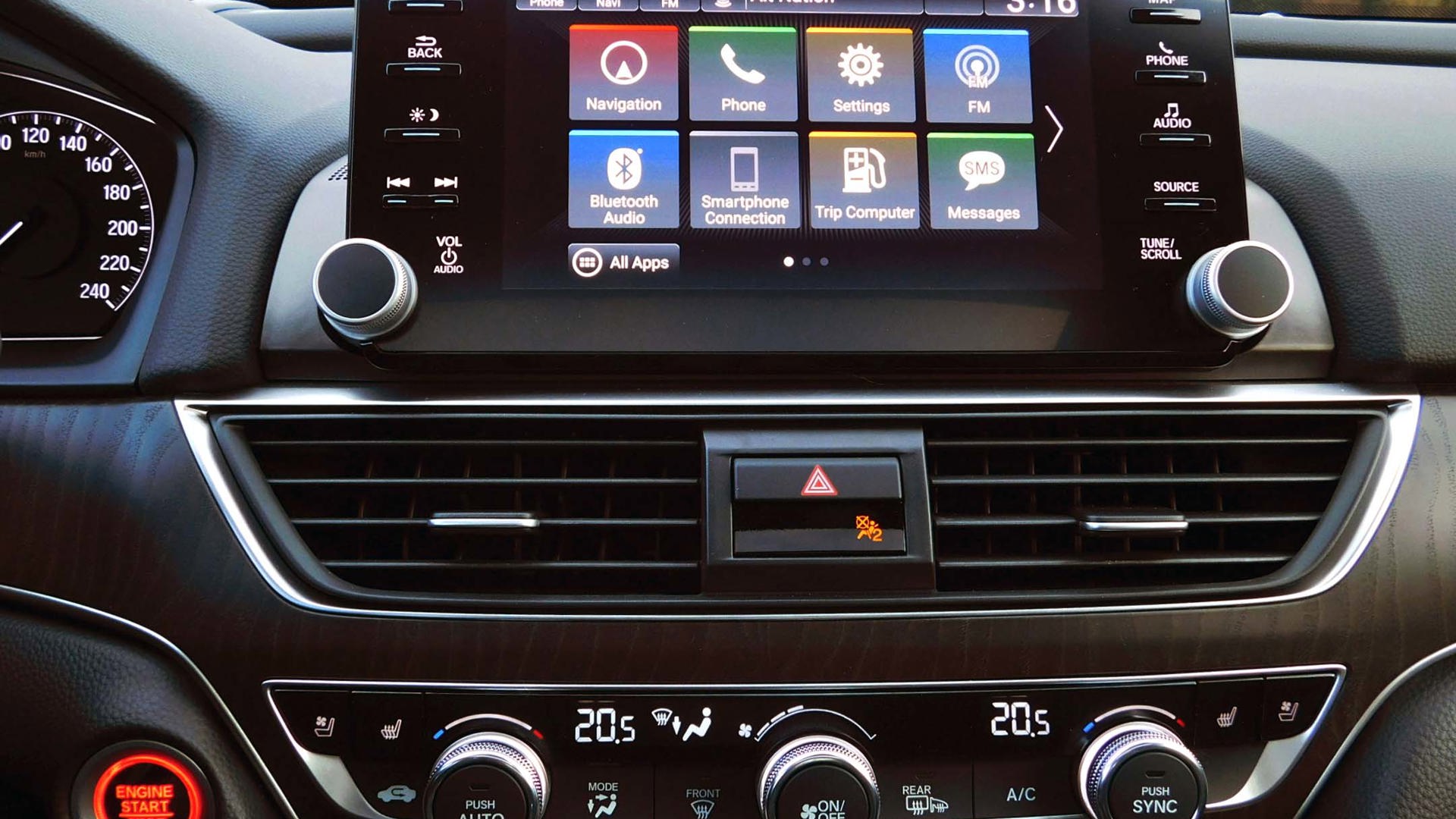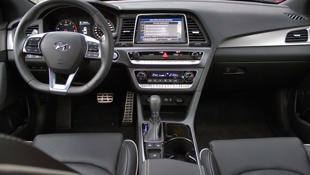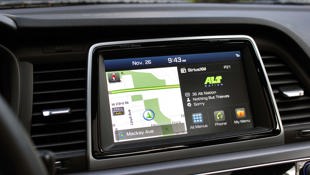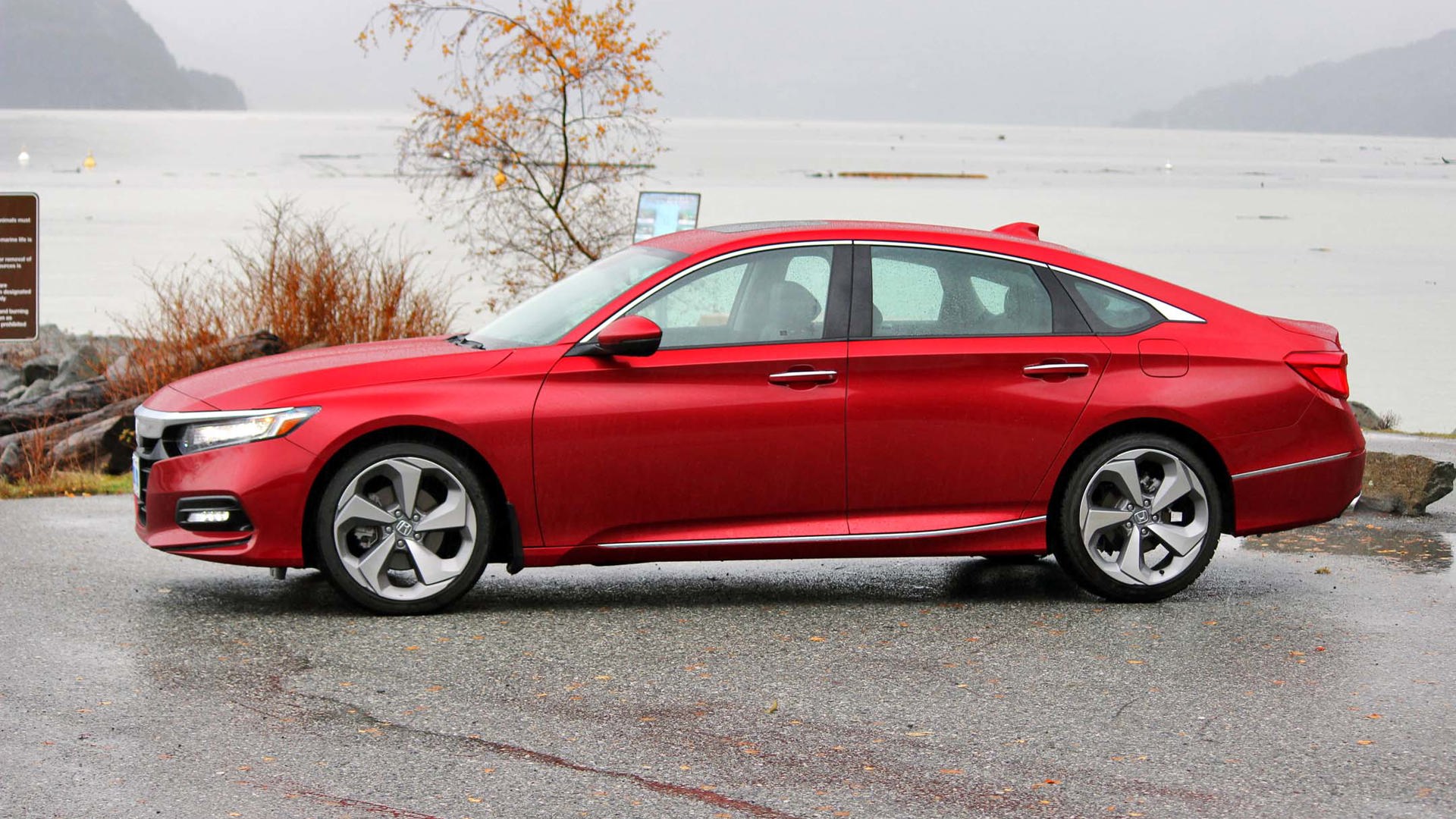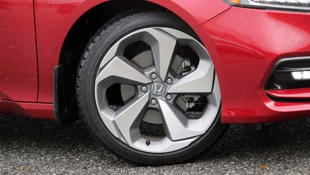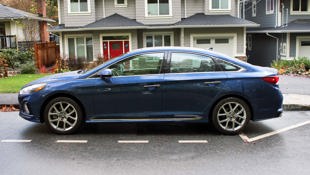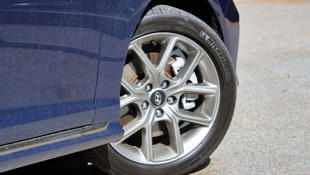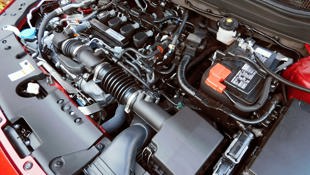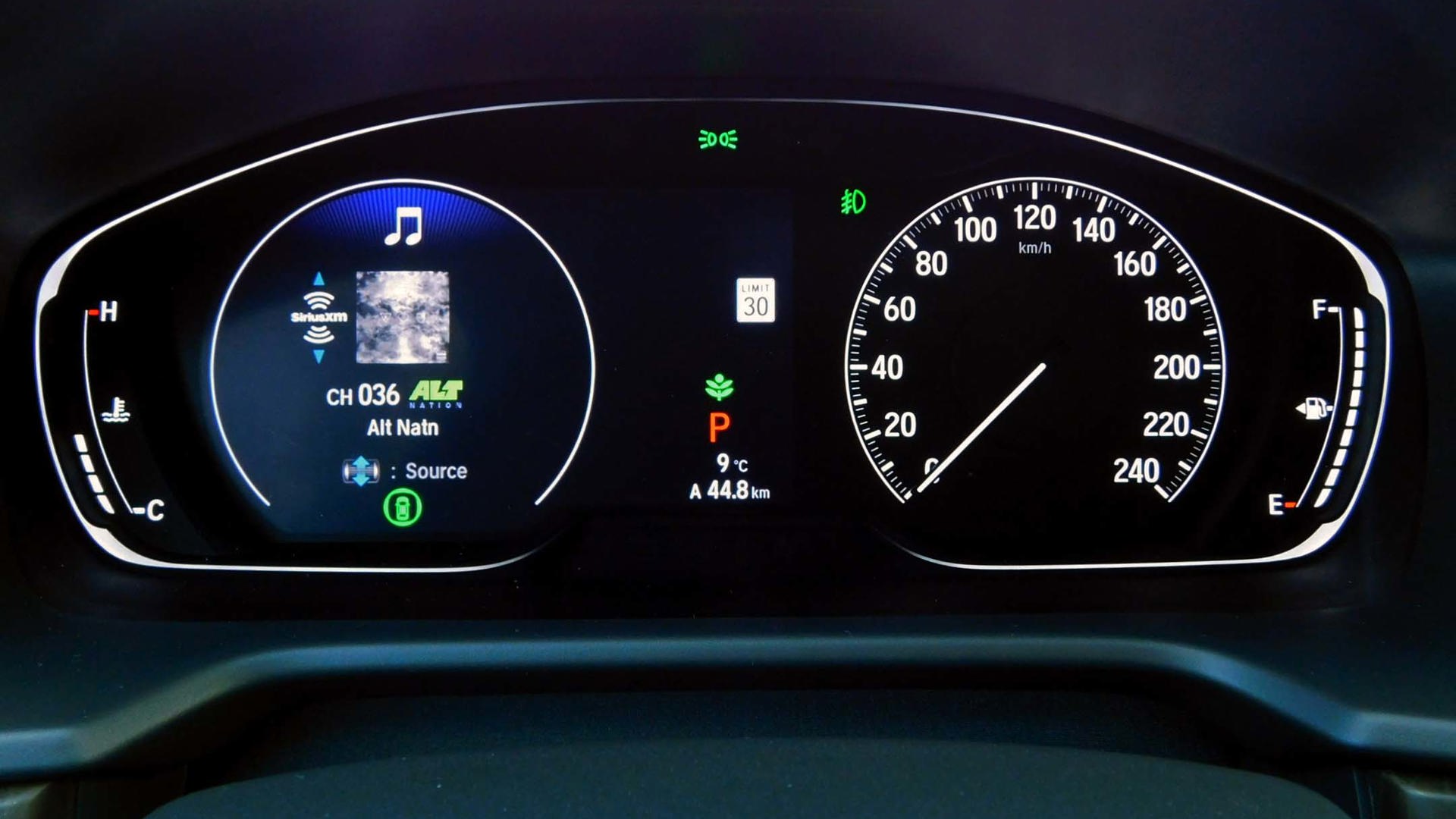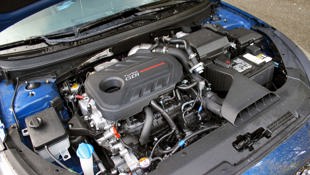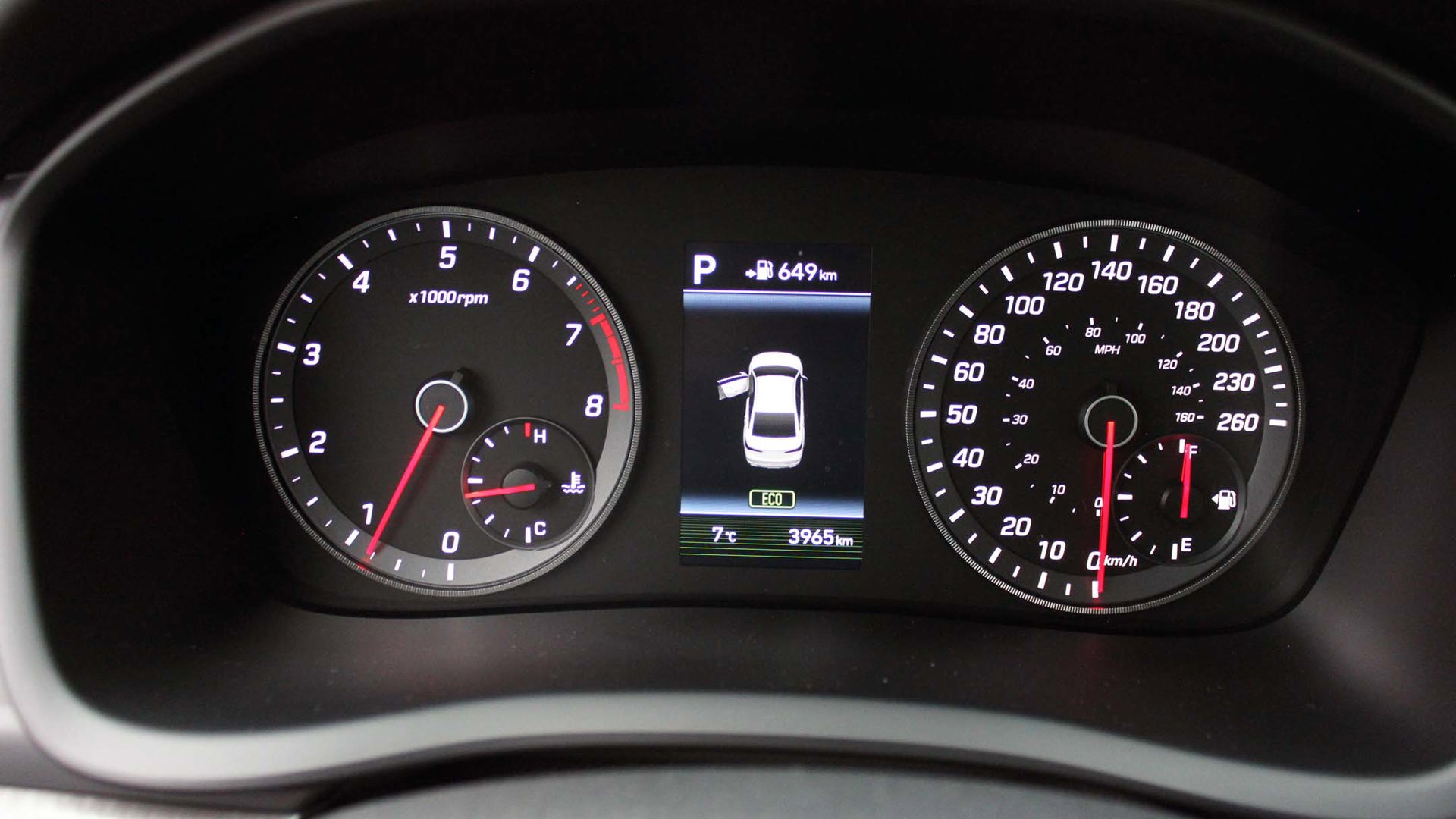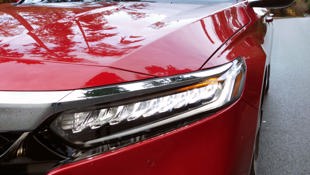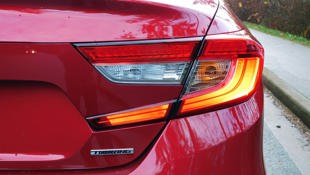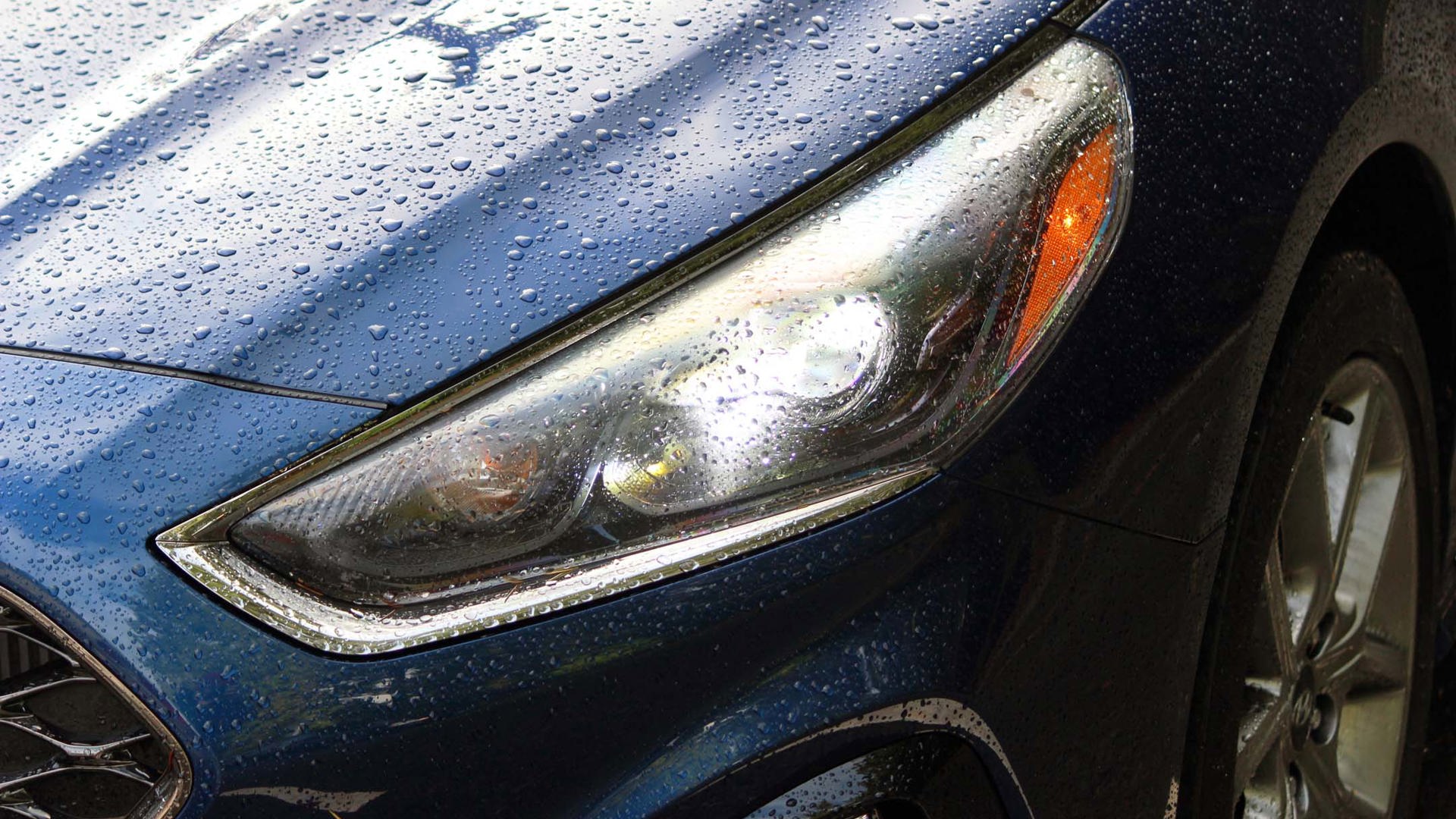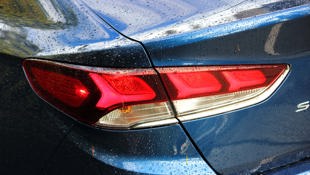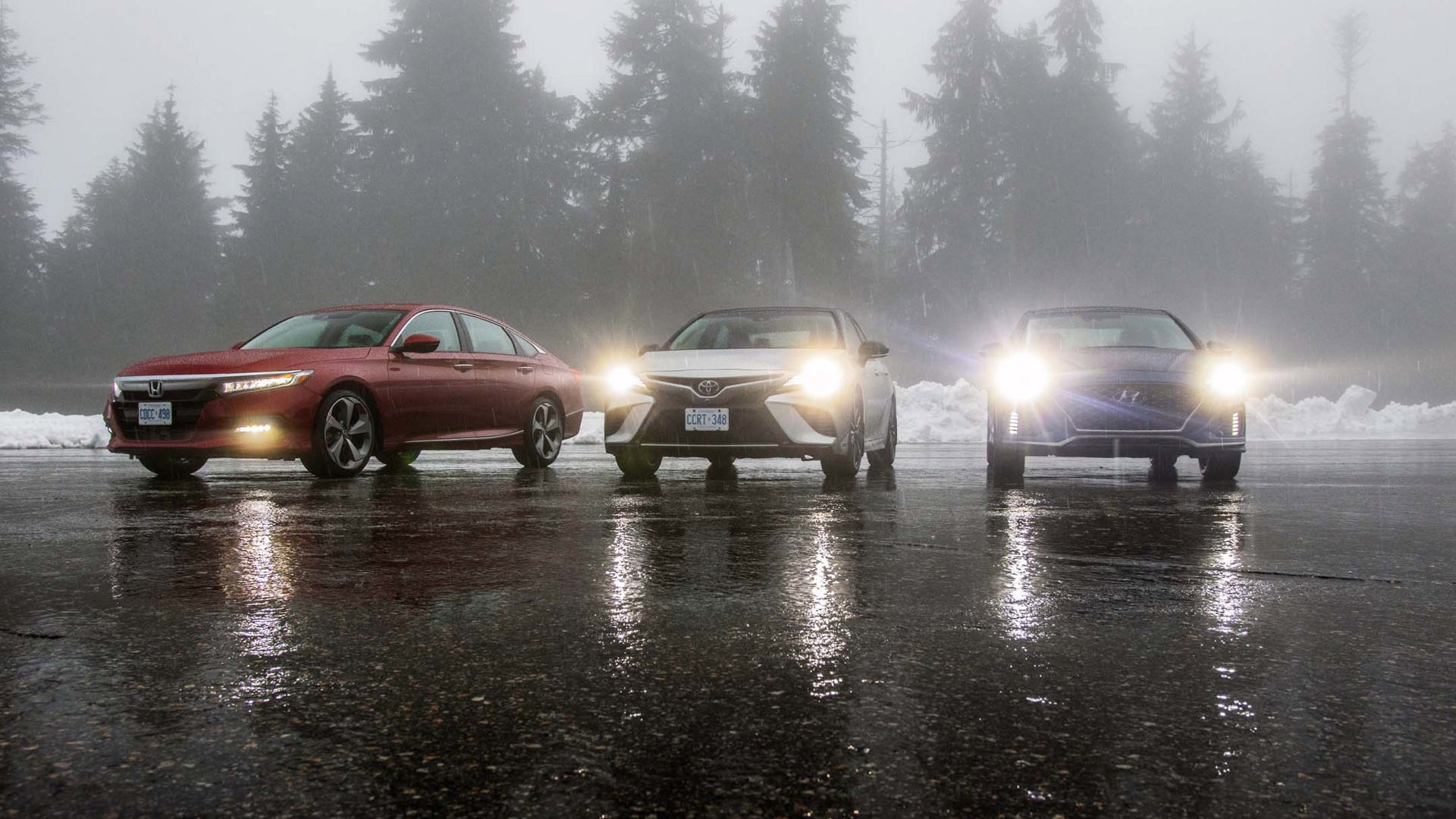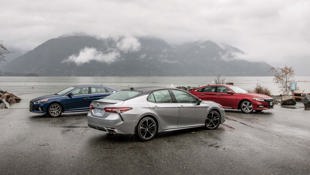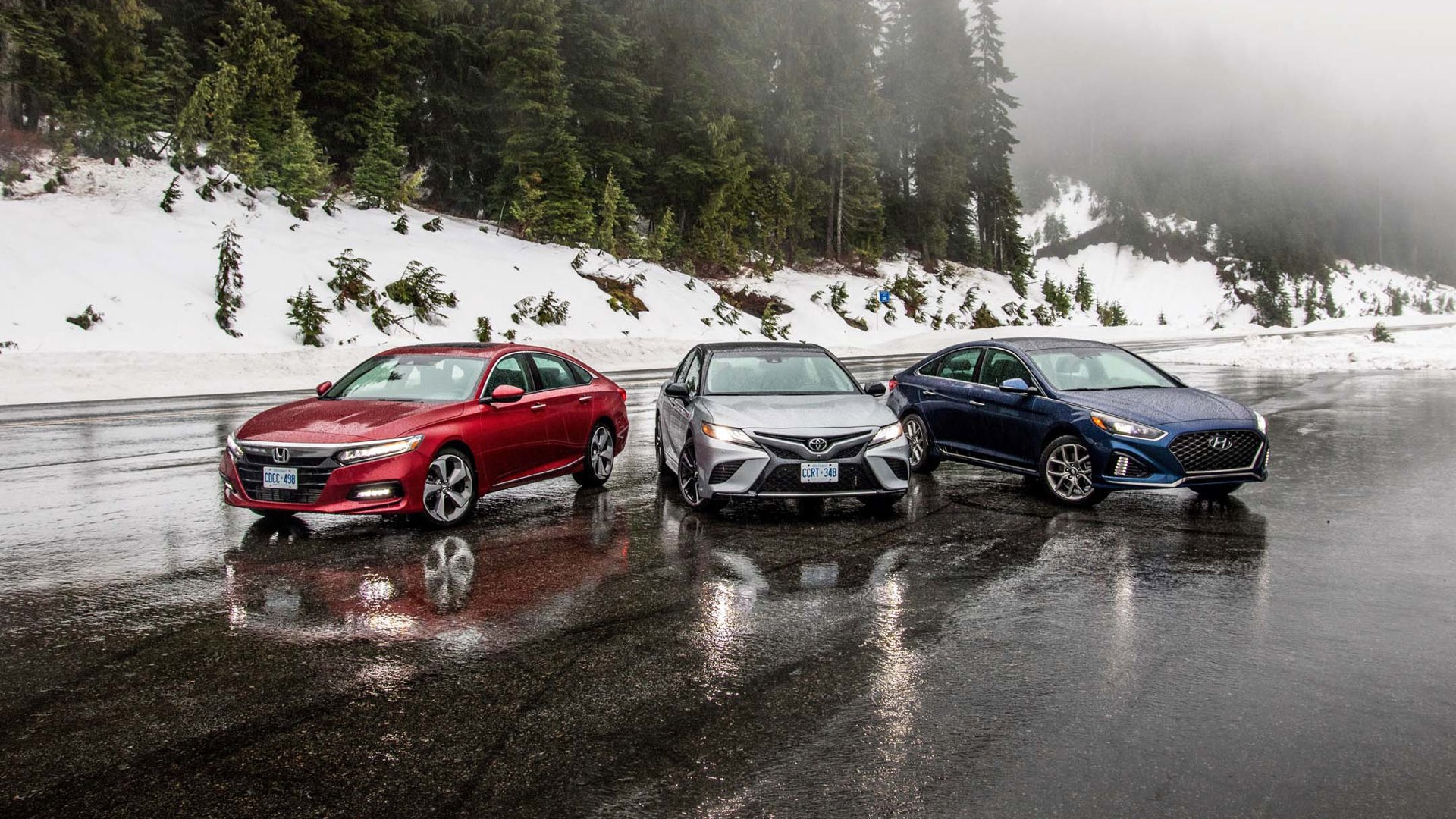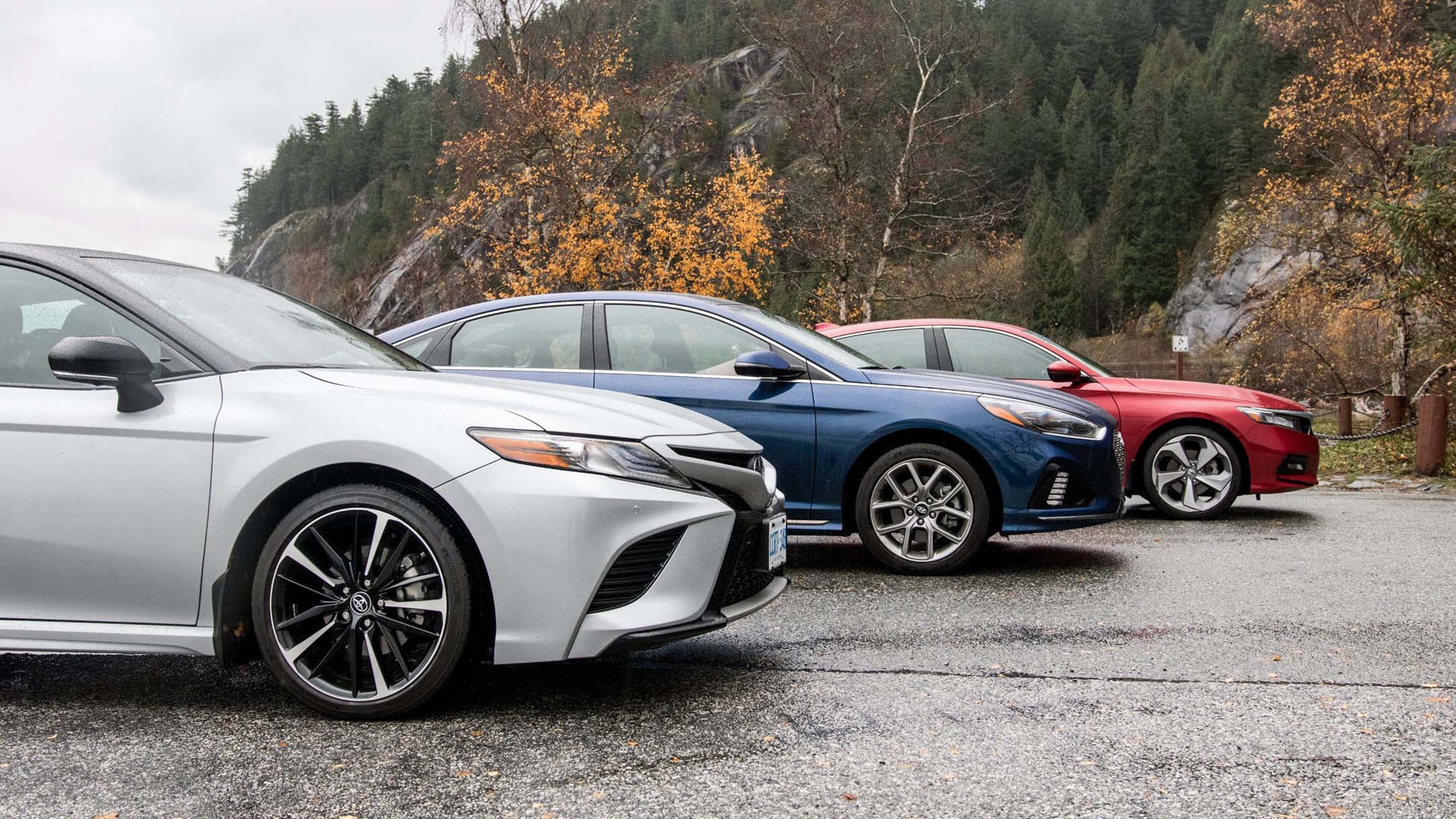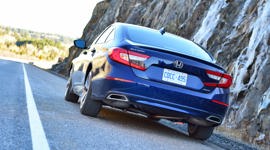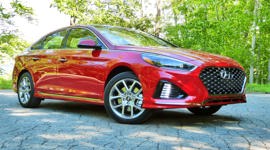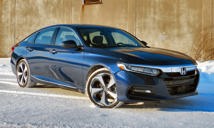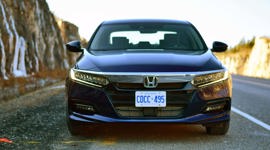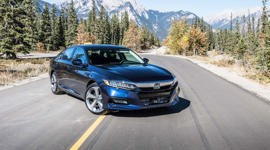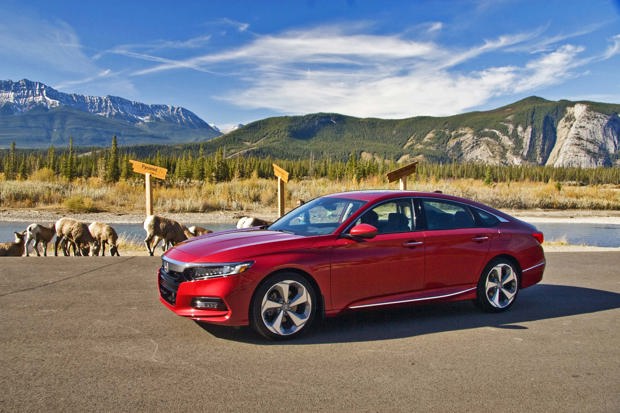Comparison Data
|
2018 Honda Accord Touring
|
2018 Hyundai Sonata 2.0T Sport
|
2018 Toyota Camry XSE V6
|
|---|---|---|
|
Engine Displacement
1.5L
|
2.0L
|
3.5L
|
|
Engine Cylinders
I4
|
I4
|
V6
|
|
Peak Horsepower
192 hp @ 5,500 rpm
|
245 hp @ 6,000 rpm
|
301 hp @ 6,600 rpm
|
|
Peak Torque
192 lb-ft @ 1,600–5,000 rpm
|
260 lb-ft @ 1,350–4,000 rpm
|
267 lb-ft @ 4,700 rpm
|
|
Fuel Economy
8.2/6.8/7.6 L/100 km city/hwy/cmb
|
10.4/7.4/9.1 L/100 km city/hwy/cmb
|
10.7/7.4/9.2 L/100 km city/hwy/cmb
|
|
Cargo Space
473 L
|
462 L
|
427 L
|
|
Base Price
$35,790
|
$36,999
|
$39,690
|
|
A/C Tax
$100
|
$100
|
$100
|
|
Destination Fee
$1,655
|
$1,805
|
$1,715
|
|
Price as Tested
$38,165
|
$38,904
|
$42,045
|
|
Optional Equipment
$620 – Silver grille $620
|
None
|
$540 – Two-tone paint $540
|
Dan Heyman, Simon Hill, and Brendan McAleer
While it may not be quite as popular a segment as it once was in Canada, 2018 is nevertheless looking like the year of the midsize sedan if our three competitors in this test are any indication. Hyundai was first to the table this year with the Sonata, which managed to beat both the 2018 Honda Accord and 2018 Toyota Camry to the sales floor by just a couple of months.
We’ve got three robot basking sharks having a grille-off. The last time there was this much macho posturing going on, a rap battle was about to break out.
Having said that, you won’t see the words all-new in any literature surrounding the Sonata as it has undergone more of a mid-cycle refresh as opposed to the Camry and Accord, which are both all-new for 2018, hence their being a little slower out of the gate.
So it’s an open-and-shut case then, right? No way the “old” Sonata has a chance in this company, right? Well, as you’ll see here, it’s not as simple as that.
Styling
Dan Heyman says:
On styling alone, what we have here are three very distinct sedans, all with their own unique features that help set them apart – making for a compelling three-horse race.
The 2018 Hyundai Sonata has been given a more muscular front end, punctuated with what Hyundai is calling a cascading grille, optional LED headlamps (being the 2.0T Sport trim, our car had these) as well as twin jeweled stacks of LED foglights nestled within larger front openings, and an aggressive front splitter. Out back, a big “Sonata” script across the rear deck is the main addition, sitting below the classic H logo that also houses the trunk release. The LED taillamps have also been redesigned for an edgier look overall.
I have to say, though: Hyundai can say all they want about added edginess or what have you, but that doesn’t change the fact that this is the most conservative-looking of the three. Its stance, its detailing – all of it. It’s not bad, but it won’t turn heads like the other two.
Which, of course, may be a good thing and may be what Hyundai’s after. Think about it: take your average car buyer aged, say, 45 or so. They’re considering a midsize sedan because maybe it’s a little classier than a compact or compact crossover. They look at the Camry with its wild new face, or the Accord with its space-age grille and squinting headlamps – not to mention those futuristic wheels – and then there’s the Sonata. It has a modicum of presence, a few neat touches of flair but it will never be that much of a head-turner.
For me, though, on style points alone, it’s the Accord, hands down. I wanted to give it to the Camry as Toyota seems to finally have done something to their sedan, but in the end, I just think it’s trying a little too hard, what with all its creases, flares, gaps, grille-that-doesn’t-really-look-like-a-grille, underbody diffuser (yes, you read that right), partially blacked-out B-pillar (an XSE-exclusive – borrowing a page from Nissan there, eh, Toyota?) and a pair of the weirdest faux-intakes you’ve ever seen, looking like two cracks in the bodywork below the tail lamps. Odd. Wheels are cool, though, and I’ll take that contrast-colour decklid spoiler, black grille, and smoked headlamp lenses, too.
The Accord is a sedan complete with a proper trunk, but it sure looks like a hatch with that ultra-sloped rear deck. It’s cool, and unlike any Accord before it by a country mile. Sure, the frontend will probably rub a few the wrong way – especially current Accord owners – but it grew on me. The aforementioned wheel design on our tester (they’re 19s) does well to jive with the styling tableau to which they’re mounted, but I would be very worried about curbing the crap out of those babies. There are other options, of course. These ones just look so good, though.
Simon Hill says:
Photos don’t always tell the whole story: some cars look better in real life, while others shine on screen. In this group the Accord arguably falls into the former category while the Camry falls into the latter. In real life the Accord’s sleek lines give it a sophisticated, Audi A7-ish appearance, accented with futuristic jewelled details seemingly borrowed from its more expensive Acura cousins.
The Camry leans the other way. It’s got a real presence in the photos, hunkered-down and eye-catching. Up close and in person, however, its many angled lines and details become a bit overpowering and vaguely discordant, or at least that was the case in our test car’s XSE trim.
The Sonata, well, it looks in real life just like it does in photos: nice in a conservative way, if perhaps not differentiated enough from the smaller Elantra. It’s worth noting that Hyundai chose not to fit the front licence plate on our tester, so it has a bit of an edge there in the group shots.
Anyhow, my style vote goes to the Accord, although our tester’s protruding wheel rims really are a bit of a concern: They look fantastic when new, but for less-than-perfect parkers they’re likely to look tatty in short order.
Brendan McAleer says:
Remember when conservatism was the hallmark of the mid-size sedan? Now we’ve got three robot basking sharks having a grille-off. The last time there was this much macho posturing going on, a rap battle was about to break out.
Which is weird, because the average mid-size buyer is, as Dan noted, probably going to be more into Springsteen. Either way, I’m calling this one for the Accord, which manages to look fresh, upscale enough to make Acura’s design team go cry in the corner, and overall handsome. The Camry ranks third for looking like the dad-bod version of a Subaru STI, and the Sonata is a solid second (despite having a badge big enough to be a Pony’s hubcap).
Interior and Comfort
Dan says:
What’s really surprising about the Accord is that even with that aggressive roofline it doesn’t suffer from an obvious lack of rear headroom. Sure the taller folks among us may have trouble wearing a twelve-gallon Stetson but let’s be honest; that’s no deal-breaker, not by a long shot.
Conversely, the Camry, which looks like it should have more room back there thanks to its more traditional roofline doesn’t, really (about 20 extra mm of both headroom and legroom). So now you’ve got a slightly less adventurous-looking car with not that much more room. The Sonata, for its part, equals the Camry’s rear headroom to the mm but it loses out on legroom and you can really feel that when sat back there. I was genuinely surprised after sitting in all three back-to-back; I’d had the Sonata the month before, and it felt fine then. Put up against the Accord and Camry, though, you feel its deficiencies.
Neither the Camry nor Sonata come close to the Accord when it comes to front seating, though. The numbers show the Sonata having more room than both, but numbers can’t reflect the Accord’s oh-so-perfect driver s seating position that places the wheel at your fingertips (but not the shift lever, because there isn’t one: on the Touring trim, there’s a stack of console-mounted gear select buttons instead) and the seat which aligns your hips with the car’s beltline. It’s coddling without being cramped, and you can’t ask for much more than that. The other two have their strengths; the Camry is properly airy up front thanks to a nice gap between the wheel and your thighs, and the Sonata comes closest to the Accord in terms of wrapping around the driver (both cars have bigger sunroofs than the Accord, too) but there’s no candle held, here. Sitting in the Accord had me feeling like I was in a much more performance-oriented machine.
Simon says:
Inside, Honda has given the 2018 Accord a bona fide near-luxury feel. We found ourselves puzzling over whether the open-grain wood trim was real or not, before concluding that it’s nice enough that it really doesn’t matter (it’s actually Zelkova, a four-layer faux wood that resembles Japanese elm). In Touring trim the front seats are both heated and cooled, and the outboard rear seats are heated too. There’s lots of rear legroom, and headroom is adequate in the back for my 5'11" frame, which is surprising considering the Accord’s swooping roofline. It’s the only one without a panoramic roof, but that’s not enough to spoil its win.
The Sonata’s interior, like its exterior, has a clean conservative style, but some of the materials felt less expensive than the other two, it had a paucity of charging ports (it has one up front, while the Accord has two both up front and in back, and the Camry has three up front) and no trunk tie-downs. In the back, higher trim levels such as our tester get heated rear seats, and there’s lots of legroom and headroom. Our test car also had a panoramic roof.
The Camry arguably has the best driver’s seat comfort by a hair (for me at least), but otherwise I found it a bit as if Toyota is holding back on the interior to give its Lexus brand room to differentiate itself. The Camry’s gauges are certainly the crudest-looking of the bunch, and the font on the infotainment controls is the typographical equivalent of Toyota’s old fluorescent digital clock. The Camry does have some nice interior touches though: there’s a slide-out inductive charging tray/phone holder that creates extra space, and the back seat is the roomiest of the bunch for tall folks. You can’t get heated rear seats, mind you, but you can get a panoramic roof.
Brendan says:
If you’re a Honda fan who’s been gnashing their teeth at the way the company’s once-simple interior design has become a mess of double touchscreens and wonky sub-menus, then fret no longer. Almost everything about the accord is right, from the way the central screen is mounted high in the driver’s view, to the fact that it’s flanked by knobs for both tuning and volume. The HVAC controls are similarly ergonomic, and the overall effect feels polished and relatively minimalist.
Further, Honda’s shifted around the seating position to give the driver a little better forward visibility, and a little lower hip point. The Camry’s probably the most comfortable of the three, and if getting down into a seat gives you a wince or two, its higher seating position is a boon.
In terms of visual appeal, however, the Honda’s again the runaway winner. Faux or not, the open-pore wood trim makes the Accord feel similar to a Genesis product: nicer than you’d expect. I find that push-button shifter to be a bit silly, as it takes up the same amount of real estate as a standard shift lever (which you get in lower trims), but otherwise the Accord’s interior looks better thought out than the Camry’s asymmetrical dashboard.
The Sonata felt dated but pleasant, and was certainly comfortable enough. As Dan noted, it has the most room up front, but unless you’re especially long-legged, either of the other two sedans offered just as much comfort. Overall, the Sonata’s interior is more cohesive than the Camry, but not quite as nice as the Honda.
Tech
Simon says:
To score top marks in my books, infotainment tech needs to be up-to-date, easy-to-use, and compatible with your preferred devices and apps. The system in the Accord Touring checks all the boxes: The big, semi-floating 8-inch colour touchscreen display is backed up not only by volume and tuning knobs, but also by eight honest-to-goodness buttons to allow easy access to the most common functions. There’ll be some kvetching from the “can’t abide semi-floating displays” crowd, but this setup looks good and is easy to use even for quasi-luddites like me. The touchpoints on the screen are themselves nice and large, and the system is quick to respond. Apple CarPlay and Android Auto are supported across the range, as are Siri Eyes Free compatibility, Bluetooth phone and streaming audio, Wi-Fi tethering and HondaLink connectivity. So even without the test car’s built-in navigation system, pulling up a map from your smartphone should be a snap. An inductive phone charger slot ensures you won’t run out of charge, and it’s backed up by a pair of USB interface/charging ports and two 12V outlets in the front, plus a pair of USB charging ports in the back. The audio system itself is a superb-sounding 452-watt 10-speaker setup with AM/FM radio and MP3/Windows Media compatibility (base LX models get a lesser 180-watt system). Folks still tied to physical CDs may be a wee bit disappointed (I looked and there’s no CD player in sight), but other than that there’s really nothing to complain about.
The Accord is equally generous with the safety and driver assist tech: forward collision warning, collision-mitigating braking system, lane -keeping assist, traffic sign recognition and adaptive cruise control are all standard across the range, with higher trims getting low-speed follow and LaneWatch blind-spot display. The Touring trim gets a head-up display and blind -spot information system with cross-traffic monitor. My one quibble was that some of the driver-aid systems are rather alarmist, which might encourage drivers to turn them off. The brake alarm was especially prone to going off during pretty routine city driving.
The Sonata’s tech scores almost as well as the Accord, but where Honda has improved their system by adding eight well-chosen and well-placed physical buttons, Hyundai’s approach is, as Brendan termed it, a bit “buttontastic”. Everything works well, but the many buttons are somewhat confusingly scattered around the bottom of the centre stack. I prefer Honda’s approach having a few carefully chosen buttons up next to the screen. Like the Accord, the Sonata gets across-the-range Apple CarPlay and Android Auto compatibility, as well as Bluetooth phone and audio streaming. Our 2.0T tester also had most of the key goodies such as wireless charging pad, navigation, 400-watt Infinity audio and Hyundai BlueLink connectivity.
Standard safety tech aboard the Sonata includes blind -spot detection and rear cross -traffic alert, but you need to step up a few trim levels to get things like autonomous emergency braking, lane -departure warning with lane -keep assist, adaptive cruise control with start-stop capability, and rear parking assist.
The Camry dances to the beat of a different drummer when it comes to tech, with no Apple CarPlay or Android Auto compatibility offered at all. Instead you get Toyota’s proprietary Entune system, with its own set of apps. Having used this on press junkets I can say that it’s a nice system, but while I have Android Auto on my phone I don’t have Entune, and there’s the rub: For families with more than one vehicle, having multiple systems among different vehicles means having to download and maintain multiple apps if you want to make full use of the systems. Also, Entune’s Scout navigation comes with a subscription fee so it’s an additional cost (the first three years are free). The other nit I have to pick with Toyota’s tech is its overall look and the feel, which my driving notes referred to as “kinda ugly and confusing.” It’s possible I simply didn’t spend enough time with the car and that things get better as you become more familiar. Well, except for the peculiar font Toyota chose to label things; I don’t see that growing on me. The Camry does get Bluetooth phone and audio connectivity across the range, so the essentials are covered, and our XSE test car also had wireless charging, head-up display, and a premium JBL audio system.
In terms of safety tech the Camry scores well, with all models getting pre-collision system with pedestrian detection, lane -departure alert with steering assist, dynamic radar cruise control and automatic high -beams. Higher trims get things like blind -spot monitor with cross -traffic alert, clearance sonar, and birds-eye rear-view camera.
Overall, I’d give the tech win to the Accord, with the Sonata a close second and the Camry third, but arguably the Camry would place second if you put a priority on the safety systems and are happy to take Entune instead of Apple or Android compatibility.
Brendan says:
On a very wet day, all three cars began to throw a fit, with some of the semi-autonomous features not working owing to the rain. Any buyer, and especially any Canadian buyer, should note that winter-time conditions really hamper these systems.
Still, if we’re picking between them, the Accord’s system does the better job of lane-following and ease-of-use. Granted, the collision alert system is about as nervous as having your mom sitting in the passenger seat, but otherwise the driver’s aids performed well. Both the Sonata and Accord get bonus points for having Apple CarPlay and Android Auto, allowing the owner to have a choice of what technology to use.
Let’s not discount the Camry however, because much of its driving-assist technology is standard. If you’re looking at a more basic version of these cars, the Toyota is more competitive at a lower trim level, as it starts out of the gate with features like adaptive cruise control, collision mitigation, and automatic high beams. In this company, however, the Camry has some gaps in its load-out.
Dan says:
I can’t believe I’m saying this, but as much as I agree about the nervousness from the Accord’s various driver aid systems, I have it as the winner – by a hair, mind – in the category. I can’t believe I’m saying this because until the recent CR-V, Honda’s infotainment system was missing such a small, crucial detail that it killed the whole op for me: a volume knob. It was an all-touch affair, and too often I found it finicky to the point of being dangerously distracting. Now, with the addition of the knob, you get the great, crisp graphics and intuitive interface without having to deal with that old issue. The Sonata is a close second for me as I like the graphics and responsive touchscreen, though I do bemoan a USB port shortage when compared to the other two. The Camry’s Entune interface may be all-new for ’18, but with no CarPlay and a sometimes clunky, confusing interface, it’s bringing up the rear, here.
Ride and Handling
Dan says:
Like the first two categories, this one was also a tough call for me. Much tougher, in fact, than I originally thought. I’d started out on the test assuming the Accord would take the other two to the cleaners in this department – it’s a Honda, after all, and of these three, Honda has the penchant for more aggressive and sport-oriented chassis tuning – but I didn’t end up with quite so crystal-clear a conclusion.
In that vein I’d also expected the Sonata, being based on an older platform, to trail quite far behind the other two in the twisties. Only it didn’t. Not entirely.
It’s a little older, yes, but Hyundai has updated the steering for 2018 and it shows: turn -in is that much more immediate, and while you won’t get a huge amount of feel, here, there’s a nice weight to the rack that at least shows it’s trying. When it comes to midsize sedans like this, that’s often enough to set a model apart.
Trouble is, the Camry is all new for 2018 and Toyota has made a satisfying bend-buster out of their bread-and-butter. When I attended the launch of the new Camry at last year’s North American International Auto Show, I rolled my eyes when they brought out both a NASCAR-ized version as well as a pair of drivers. This was a Toyota Camry, after all. While they could talk a blue streak about how great it is to drive, they couldn’t change things overly much for fears of alienating their core buyers who favour ride comfort above all, and turn-in rates be darned, right?
Maybe, but after driving it on these mountain roads, I have to tip my hat a little to Toyota for making a car that doesn’t drive entirely like a taxicab, just somewhat. You’ll still get that soft ride and more perceptible body roll over the rest, but for 2018 all that’s been joined by more willingness to be tossed a little more willy-nilly into corners. We can thank bigger front and rear stabilizer bars, sport-tuned suspension and unique-to-XSE wheels and tires for the change. There were a few times I had to remind myself I was driving a Camry and while these were few and far between, the fact that it happened at all was an eye-opener for me.
Thing is, while it wasn’t an open-and-shut case as I originally thought it might have been, the Accord still does win out in this section. The steering gets more feel than it does in the Sonata and while I actually detected a little more body roll in the Accord than I did in the Hyundai, it’s nothing more than a split hair and the rest of the experience – very good steering feel with quick turn-in, two-stage adaptive dampers and well-controlled rear end – makes up for it.
Simon says:
For me the Honda wins in the ride and handling department because it has the best overall balance, with excellent handling chops, decent driver feedback, and good comfort. It feels much more refined and grown up than the other two, and quieter, too. The Camry rode and handled nicely, but lacked a little in refinement: I’m not sure if it was the particular tires fitted to our tester or what, but the Camry seemed quite noisy on the highway (and as an aside, the front doors sound a bit hollow when you slam them, too). The Hyundai was once again good overall, with a decent ride and reasonably engaging handling, but the steering felt a touch numb.
Brendan says:
We have to mark the Camry’s boomy highway behaviour with an asterisk, as it was wearing snow tires. Then again, so was the Accord, and it sailed along serenely. The Sonata figured somewhere in the middle, as is becoming rather the theme here.
What’s wanted here is a level of driving competence that’s matched by ride comfort, and of the three, the Honda noses ahead of both the Camry and the Sonata despite having the smaller engine. The reason it’s able to do so is down to the chassis tuning, which is light on its feet and nimble without relying too heavily on aggressive spring rates.
Combined with the improved driving position, the Accord provides old-school Honda delights. It’s not the power you have on tap, it’s how easy it is to use it, and the Accord’s chassis shone on the Sea-to-Sky, despite the cloudy weather. Further, Touring model Accords have two-level adaptive dampers, not dissimilar to those in the Civic Si. If you like to squeeze a little extra performance out of your sedan, the Accord is anything but boring.
Having said that, the Camry had plenty of grip, and a responsiveness that surprised. Even more surprising was the Sonata’s overall grip; despite a numb steering wheel, the Hyundai was quick enough to not lag behind. The Accord felt the most driver-oriented of the three, and hey, have we mentioned that you can get one with a manual transmission?
Performance and Economy
Dan says:
This is where I was really expecting the Camry to strut its stuff. It has the biggest engine here, the most cylinders and the most power: its 301 hp and 267 lb-ft play 192 hp and 192 ib-ft in the Accord, and 245 hp and 260 lb-ft in the Sonata. Granted; the Accord’s more powerful 2.0L engine option (ours had the 1.5L) brings it a little closer, but it still lags behind the other two.
I was also looking forward to the fact that the Camry has a slick new eight-speed automatic transmission (with paddle shifters!) to help get all that power down. This is a mighty quick car, possibly the quickest I’ve ever sampled in the segment, with the possible exception of the Ford Fusion Sport or V6-powered VW Passat. Thanks to its natural aspiration, the V6 is able to start pulling immediately, and while it does feel a little floaty as you really get on it and the nose lifts a little, it’s a pretty controlled affair overall. Then, when it’s time to just cruise, it’s quiet, comfortable and oh-so-Camry. That’ll keep the diehards happy, I’m sure.
For its part, the Accord has to work a little harder to get the job done, but if you can get – and keep – that turbo on boil (peak torque is available from 1,600 to 5,000 rpm), you’ll be treated to some sprightly progress, especially if you’ve selected Sport mode my pressing a button just below the shift buttons.
All the cars here have a Sport setting (on the Honda and Toyota, a single button press does the trick; you have to scroll through the various drive modes on the Sonata), but the Honda is where you’ll feel the most drastic change. A big reason for this has to be the fact that it gets a CVT transmission, which is not quite as responsive as the traditional autos found in the other two cars in normal driving. Switching to Sport leads to a snappier attitude overall, and that’s a good thing for a little extra driving pleasure.
Thing is in my humble opinion – again, Simon and Brendan may differ – it’s not quite enough to overcome that power deficit and out-duel the other two on the engine and powertrain fronts. We talked about the Camry and the Sonata, for its part, is very responsive considering it has a turbocharged engine and does suffer from a little lag. So, it’s not quite as immediate a power delivery as provided by the Camry, but once up to speed (helped along by a new eight-speed of its own) it’s quite grand, still managing to pip the Accord and feeling almost as fast as the Camry.
Not fast enough, though: the Camry wins this section for me.
Simon says:
Given that Toyota is now the only one of the three offering a V6 in its mid-size sedan, trying to say much about our testers’ performance capabilities is an apples-and-oranges task. If you like the always-on torquey authority of an old-school V6, the Camry is your only choice (although the Volkswagen Passat and Ford Fusion also offer sixes). I was well-impressed by the Honda though. The standard 1.5L turbocharged engine gets genuinely good fuel economy for a mid-size sedan and feels perfectly relaxed when tooling around town, yet it moves along quite nicely when you stomp on the throttle. Granted, acceleration is more of a rapid whoosh than a kick in the seat, but the CVT automatic is remarkably drone-free and the Accord will whisk you to 100 km/h in under 8 seconds (about 7.5 seconds according to published data). Rounding out the trio, the Sonata 2.0T feels entertainingly quick and eager, especially in Sports mode. If I had any complaint, it’s that the throttle is almost too touchy. So if you ask me, Toyota wins for raw power, Hyundai’s 2.0T gets the nod for best compromise, and the Accord’s 1.5T goes home with the prizes for refinement and economy as it used the least fuel – by a hair, admittedly – after our 100 km drive.
Brendan says:
Let’s face it: nobody is buying a mid-sized sedan and looking to hit the dragstrip. Pace should be quick but relatively effortless, and in that regard, the Camry is an excellent machine. I’m sure this’ll annoy a few people, but you could even think of it as the last of the modern muscle sedans. Yes, there’s the Charger, but that’s a retro-themed throwback: I’m talking here about the small arms race that kicked off when Nissan plunked a 240 hp V6 in their Altima.
With most manufacturers switching over to 2.0L turbocharged four-cylinders for emissions and economy reasons (more the former than the latter, I’m afraid), the Camry’s 3.5L V6 is a delight. It pulls hard, the soundtrack’s good, and the fuel economy’s livable. It’s also a bit smoother than the two four-cylinder engines it’s up against, although the Accord’s sound-deadening manages to keep powertrain refinement close.
Having spent time with the 2.0L version of the Accord, both with the automatic and manual options, I’ve got some so-so news. The V6 version was a jewel, but both the four-cylinder models are merely okay. Taking weight off the nose lets the Accord shine in the twisty bits, but for the straight-line driving most people will be doing, you might as well just stick with the 1.5L turbocharged engine.
As for the Sonata, surprising competence is the order of the day. Its 2.0L engine provides just as much thrust as Honda’s 2.0L option, and the eight-speed automatic downshifts quickly when you need to pass. Even had we brought along a 2.0L Accord, I’m not sure the Honda would have scored much higher.
Value
Sonata: Base MSRP $24,799 (Sonata GL), as-tested MSRP $36,999 (Sonata 2.0T Sport)
Accord: Base MSRP $26,490 (Accord LX), as-tested MSRP $35,790 (Accord Touring)
Camry: Base MSRP $26,590 (Camry L), as-tested MSRP $39,690 (Camry XSE V6)
Simon says:
Value-wise, if what you’re looking for is the least expensive mid-size sedan of the three, a base Sonata GL, at $24,799 before freight, comes in a few hundred dollars cheaper than the base models from Honda or Toyota. But that’s not the model we tested: the 2.0T Sport we tested comes in at $36,999. The Camry XSE V6, at $39,690, tips the scales as the most expensive of our testers by a healthy margin – blame that stonking big V6. The Accord, meanwhile, which impressed with the most upscale-feeling interior, the most refined ride and handling, and the best tech, was actually the least expensive as-tested, at $35,790. True, it was the only one of the group with the base engine (you’d be looking at $38,790 before freight with the 2.0L turbo engine), but it gave up surprisingly little on the road, and even if you added the bigger engine it would still cheaper than the Camry XSE, which make it the value winner in my books.
Brendan says:
As test vehicles are often crammed to the hilt with every possible feature, the better to charm, I often find it helpful to glance further downrange to see how the models stack up against each other where most buyers shop. All three of our machines start out at a similar price point – with the Sonata looking like a bargain to start – and the Sonata just keeps getting better. Price the Camry and the Accord out to the XLE and EX-L level, with leather seats and a few other niceties, and the Sonata looks even better. Its GLS trim is thousands less than the Toyota or Honda, and a Hyundai badge isn’t the liability it once was.
The best deal is the Sonata, but I concur with Simon that the Accord represents good value, and feels like you’re getting the most bang for your buck. Resale should be good too.
Dan says:
How they can get away from charging so little for the Accord blows my mind. Yes; it’s pipped at base by the Sonata in the lowest cost-of-entry sweepstakes, but for this test, it comes cheaper yet more fully featured, classier and more comfortable inside as a result. Added to which it looks fantastic with its 19-inch wheels and fastback-like profile. Not to mention how, in 1.5 guise at least, it pipped the other two at the pump even though it delivered the best drive. Sure, the more powerful 2.0L may not earn those same fuel economy laurels, but when it comes to this test, the Accord came up roses in that department.
Conclusion
Dan says:
These are three very worthy competitors, to be sure, but after our drive I did manage to crown a clear winner. With its looks, handling – especially its handling – and interior and tech accoutrements, the Accord takes this one, making up for the previous model's poor showing at our mega-test last year. I have to say it’s not entirely a surprise, although I thought the Camry XSE had a real shot thanks to that great powertrain and looks that show that Toyota is willing to step out of its comfort zone with their bread-and-butter midsize. Unfortunately for it, though, the Accord has smashed Honda’s comfort zone to bits.
Which leaves the Sonata. Where does it finish? It doesn’t have what it takes to beat the Accord, but I’d say that if an older Hyundai can beat out the new Camry here, well that’s a pretty good feat. After careful deliberation, the Sonata did, in fact, earn the silver medal from me. What it gives up in space to the Camry rear seat-wise, it makes up for it by providing a good front seating position, good tech (the Camry loses big points, here) and a ride that is actually a little sportier than the Camry, even if there are power deficiencies. Well met, Hyundai. Well met indeed.
Over to you, lads.
Simon says:
I can’t argue with Dan’s conclusions. Honda has really pulled out the stops with the new Accord, and there’s almost nowhere that it feels like it falls short. For me, it’s the clear winner. It’s much more difficult choosing between the Hyundai and the Camry: If you crave a V6, the choice is obvious, but the Hyundai is perhaps the slightly better-rounded of the two offerings, which is enough to give it my nod for second place. I love the Camry’s boldness, and I’m fond of the V6. But I’m unsure whether I actually like the look that boldness has created, and the V6 is too much the test car’s defining characteristic. I’m left wondering if the Camry would have come out further ahead if Toyota had offered up a more conservative, four-cylinder XLE model for our test instead.
Brendan says:
What we have here, ultimately, are three responses to a market segment that’s dying on the vine. Toyota’s approach seems to be recognizing that the Camry is often a bland proposition, so the solution is to pull out all the stops with regards to styling and power. The engine is wonderful, but the rest feels like it’s trying too hard.
The Sonata looks to stay the course, offering plenty of technology and power, combined with conservative styling inside and out. Yes, this is more a refresh than a renew, but it’s still a worthy strategy. The Sonata doesn’t look to surprise, even though we found its performance levels to be better than expected. Instead, it represents the same appeal Hyundais have had for years: lots of stuff, served up in a well-priced package.
Both my colleagues have listed their specific reasons for awarding the Accord the top prize, but there’s a simpler way to put it. Honda’s engineers appear not to have worried about stepping on Acura’s toes with this new Accord. As a result, they built it better than it has to be. The market dwindles, the market shrinks. In these conditions, only the fittest survive. For now, that means a Honda badge up front.

